Paul van Yperen's Blog, page 231
June 17, 2019
Dumbo (1941)
Dumbo (1941) was Walt Disney's fourth animated feature and a masterpiece. It deals with discrimination, self esteem, the importance of family and friendship. For this post, I've found some old French postcards of Dumbo, published in the 1940s by Éditions Superluxe in Paris, and a more recent American postcard.

Big American postcard in the Walt Disney's Classics series by Classico, San Francisco, no. 511-021. Sent by mail in the Netherlands in 1983. Image: The Walt Disney Company. Publicity still for Dumbo (Ben Sharpsteen, a.o., 1941). Caption: Based upon an original story, Dumbo, the Flying Elephant, by Helen Aberson and Harold Pearl, the Disney feature starred a little circus elephant who never talked and his pal, Timothy Mouse, who talked for both of them. After mistakenly drinking some champagne that belonged to the clowns, the elephant and the mouse fell asleep and awoke to find themselves upon the limb of a tall tree with a flock of crows. "Your ears, Dumbo. Dere poifect wings. You flew!", exclaimed Timothy, and he persuaded the little elephant to do it again.
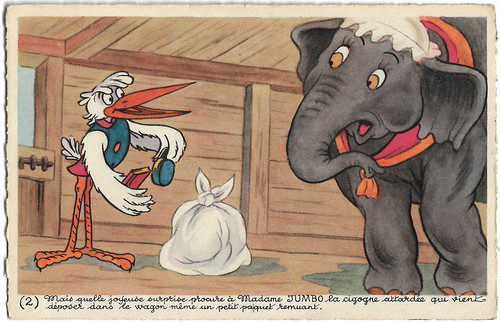
French postcard by Éditions Superluxe, Paris, no. 2. Image: Walt Disney - Mickey-Mouse, S.A. Publicity still for Dumbo (Ben Sharpsteen, a.o., 1941). Caption: But what a joyful surprise for Mrs. Jumbo when the stork comes to deposit a small stirring package in the wagon.
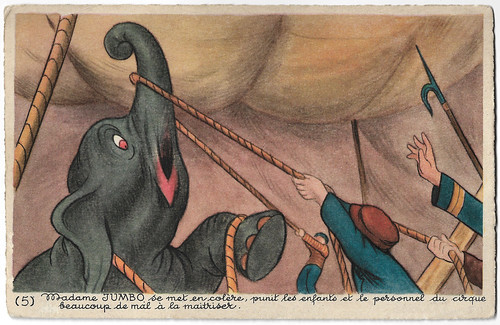
French postcard by Éditions Superluxe, Paris, no. 5. Image: Walt Disney - Mickey-Mouse, S.A. Publicity still for Dumbo (Ben Sharpsteen, a.o., 1941). Caption: Ms. Jumbo gets angry, punishes the children and becomes very hard to master for the circus staff.
The tough, tough circus world
Honestly, I've watched Dumbo (Ben Sharpsteen, a.o., 1941) more than a hundred times, together with my mentally handicapped son Lucas. The film still thrills us no matter how many times we have seen it.
Dumbo is based upon a children's story written by Helen Aberson-Mayer and Harold Pearl, with illustrations by Helen Durney, that was prepared to demonstrate the prototype of a toy storytelling display device called 'Roll-A-Book', which was similar in principle to a panorama. It involved only eight drawings and just a few lines of text.
Dumbo was first brought to the attention of Walt Disney in late 1939 by Disney's head of merchandise licensing Kay Kamen, who showed a prototype of the Roll-A-Book that included Dumbo. Disney immediately grasped its possibilities and heartwarming story and purchased the rights to it. Originally it was intended to be a short film, but Disney soon found that the only way to do justice to the book was to make it feature-length.
In the opening sequence, a flock of storks delivers babies while circus animals are being transported by train from their 'Winter Quarters'. Finally, a tired stork also delivers a baby elephant to Mrs. Jumbo, a veteran of the tough circus world. All the other elephants ridicule the newborn Jumbo Jr. for his gigantic ears. He is dubbed 'Dumbo' and is shut out.
After his mother has been locked up in a jail-like waggon for protecting him, Dumbo is all alone. Heartbreaking is the scene scene when Dumbo's mother in chains rocks him with her trunk from beyond the bars. Timothy Q. Mouse feels sympathy for Dumbo and appoints himself as Dumbo's mentor and protector. Timothy is determined to help Dumbo regain his spirits.
The circus director makes Dumbo the top of an elephant pyramid stunt. The performance goes awry as Dumbo trips over his ears and misses his target, causing the other elephants to suffer various injuries, and bring down the big top.
When Dumbo is relegated to the circus' clown acts, it is up to his only friend, Timothy, to assist the little elephant to achieve his full potential at last. Dumbo learns that he can fly and becomes he 'ninth wonder of the universe', and the only elephant in the world who can fly.
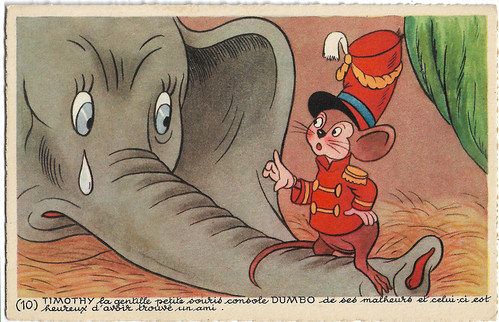
French postcard by Éditions Superluxe, Paris, no. 10. Image: Walt Disney - Mickey-Mouse, S.A. Publicity still for Dumbo (Ben Sharpsteen, a.o., 1941). Caption: Timothy, the nice little mouse consoles Dumbo of his woes and Dumbo is happy to have found a friend.
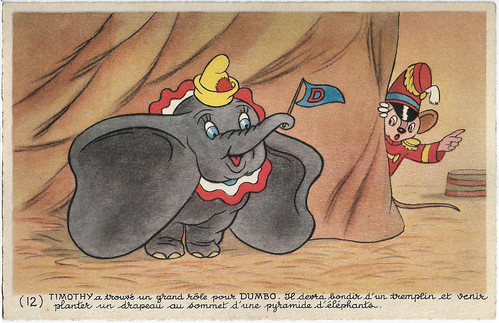
French postcard by Editions Superluxe, Paris, no. 12. Image: Walt Disney Productions. Publicity still for Dumbo (Ben Sharpsteen, a.o., 1941). Caption: Timothy has found a great role for Dumbo. He will have to jump from a springboard and come to plant a flag at the top of a pyramid of elephants.
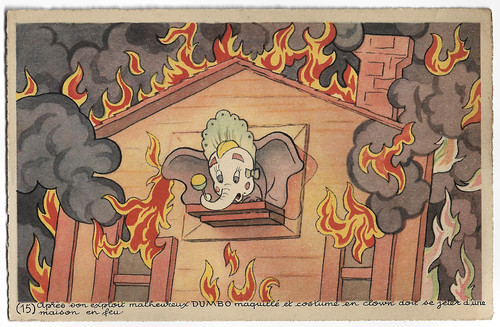
French postcard by Editions Superluxe, Paris, no. 15. Image: Walt Disney Productions. Publicity still for Dumbo (Ben Sharpsteen, a.o., 1941). Caption: After his unfortunate exploits, Dumbo made up and costumed as a clown must jump from a house on fire.
Some of Disney's best visual poetry
At just 64 minutes, Dumbo (Ben Sharpsteen, a.o., 1941) is short and sweet. But it also contains some of Disney's best visual poetry. The style is elegant, vivid, and occasionally grotesque in ways that recall not only classic circus posters but also Paul Cadmus paintings and vintage 'New Yorker' cover art, as one of the IMDb reviewers observes.
Dumbo (Ben Sharpsteen, a.o., 1941) certainly has a hint of nostalgia. The film presents a rosy-hued portrait of old America but in the middle is a simple, tender story about acceptance and mother love.
Dumbo and his mother are both mute which means that their entire characters are created through their body language. You see all the emotions Dumbo is passing through. Mrs Jumbo rearing up and destroying the big top to protect her little son from taunting kids is an incredible scene.
These performances are triumphs of animation. The entire opening sequence, till the gossipy elephants start talking, plays out without words, and its like the best silent films: simply beautiful.
The other characters, both good and bad, are painted with broad, memorable strokes. The songs and score are flawless, and the show-stopping, nightmarish pink elephant sequence is brilliant. One of the most inventive animation sequences ever.
Ben Sharpsteen was the supervising director of Dumbo. Sequences were directed by Sam Armstrong, Norman Ferguson, Wilfred Jackson, Jack Kinney, Bill Roberts and (uncredited) by John Elliotte. Despite the advent of World War II, Dumbo proved to be the most financially successful Disney film of the 1940s.
Tim Burton released a live-action adaptation of the film earlier this year, but I won't go to the cinema to see the new version. This one is just perfect.
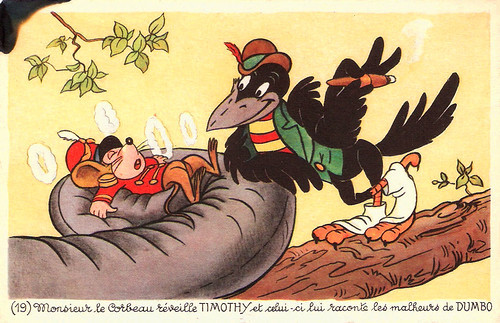
French postcard by Editions Superluxe, Paris, no. 19. Image: Walt Disney Productions. Publicity still for Dumbo (Ben Sharpsteen, a.o., 1941). Caption: Mr. Crow wakes Timothy and he tells the story of Dumbo's woes.
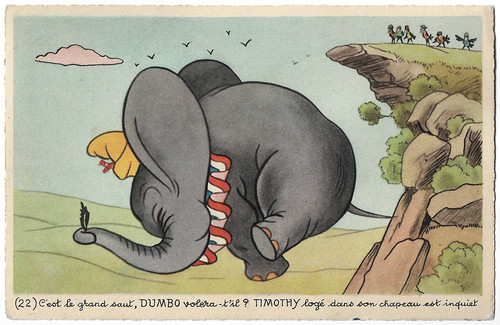
French postcard by Editions Superluxe, Paris, no. 22. Sent by mail in 1953. Image: Walt Disney Productions. Publicity still for Dumbo (Ben Sharpsteen, a.o., 1941). Caption: This is the big jump, Dumbo will fly? Timothy lodged in his hat is worried.
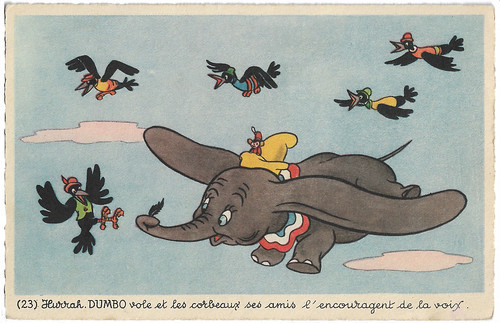
French postcard by Editions Superluxe, Paris, no. 23. Image: Walt Disney Productions. Publicity still for Dumbo (Ben Sharpsteen, a.o., 1941). Caption: Hurrah. Dumbo flies and his friends the crows encourage him.
Sources: Wikipedia and IMDb.

Big American postcard in the Walt Disney's Classics series by Classico, San Francisco, no. 511-021. Sent by mail in the Netherlands in 1983. Image: The Walt Disney Company. Publicity still for Dumbo (Ben Sharpsteen, a.o., 1941). Caption: Based upon an original story, Dumbo, the Flying Elephant, by Helen Aberson and Harold Pearl, the Disney feature starred a little circus elephant who never talked and his pal, Timothy Mouse, who talked for both of them. After mistakenly drinking some champagne that belonged to the clowns, the elephant and the mouse fell asleep and awoke to find themselves upon the limb of a tall tree with a flock of crows. "Your ears, Dumbo. Dere poifect wings. You flew!", exclaimed Timothy, and he persuaded the little elephant to do it again.

French postcard by Éditions Superluxe, Paris, no. 2. Image: Walt Disney - Mickey-Mouse, S.A. Publicity still for Dumbo (Ben Sharpsteen, a.o., 1941). Caption: But what a joyful surprise for Mrs. Jumbo when the stork comes to deposit a small stirring package in the wagon.

French postcard by Éditions Superluxe, Paris, no. 5. Image: Walt Disney - Mickey-Mouse, S.A. Publicity still for Dumbo (Ben Sharpsteen, a.o., 1941). Caption: Ms. Jumbo gets angry, punishes the children and becomes very hard to master for the circus staff.
The tough, tough circus world
Honestly, I've watched Dumbo (Ben Sharpsteen, a.o., 1941) more than a hundred times, together with my mentally handicapped son Lucas. The film still thrills us no matter how many times we have seen it.
Dumbo is based upon a children's story written by Helen Aberson-Mayer and Harold Pearl, with illustrations by Helen Durney, that was prepared to demonstrate the prototype of a toy storytelling display device called 'Roll-A-Book', which was similar in principle to a panorama. It involved only eight drawings and just a few lines of text.
Dumbo was first brought to the attention of Walt Disney in late 1939 by Disney's head of merchandise licensing Kay Kamen, who showed a prototype of the Roll-A-Book that included Dumbo. Disney immediately grasped its possibilities and heartwarming story and purchased the rights to it. Originally it was intended to be a short film, but Disney soon found that the only way to do justice to the book was to make it feature-length.
In the opening sequence, a flock of storks delivers babies while circus animals are being transported by train from their 'Winter Quarters'. Finally, a tired stork also delivers a baby elephant to Mrs. Jumbo, a veteran of the tough circus world. All the other elephants ridicule the newborn Jumbo Jr. for his gigantic ears. He is dubbed 'Dumbo' and is shut out.
After his mother has been locked up in a jail-like waggon for protecting him, Dumbo is all alone. Heartbreaking is the scene scene when Dumbo's mother in chains rocks him with her trunk from beyond the bars. Timothy Q. Mouse feels sympathy for Dumbo and appoints himself as Dumbo's mentor and protector. Timothy is determined to help Dumbo regain his spirits.
The circus director makes Dumbo the top of an elephant pyramid stunt. The performance goes awry as Dumbo trips over his ears and misses his target, causing the other elephants to suffer various injuries, and bring down the big top.
When Dumbo is relegated to the circus' clown acts, it is up to his only friend, Timothy, to assist the little elephant to achieve his full potential at last. Dumbo learns that he can fly and becomes he 'ninth wonder of the universe', and the only elephant in the world who can fly.

French postcard by Éditions Superluxe, Paris, no. 10. Image: Walt Disney - Mickey-Mouse, S.A. Publicity still for Dumbo (Ben Sharpsteen, a.o., 1941). Caption: Timothy, the nice little mouse consoles Dumbo of his woes and Dumbo is happy to have found a friend.

French postcard by Editions Superluxe, Paris, no. 12. Image: Walt Disney Productions. Publicity still for Dumbo (Ben Sharpsteen, a.o., 1941). Caption: Timothy has found a great role for Dumbo. He will have to jump from a springboard and come to plant a flag at the top of a pyramid of elephants.

French postcard by Editions Superluxe, Paris, no. 15. Image: Walt Disney Productions. Publicity still for Dumbo (Ben Sharpsteen, a.o., 1941). Caption: After his unfortunate exploits, Dumbo made up and costumed as a clown must jump from a house on fire.
Some of Disney's best visual poetry
At just 64 minutes, Dumbo (Ben Sharpsteen, a.o., 1941) is short and sweet. But it also contains some of Disney's best visual poetry. The style is elegant, vivid, and occasionally grotesque in ways that recall not only classic circus posters but also Paul Cadmus paintings and vintage 'New Yorker' cover art, as one of the IMDb reviewers observes.
Dumbo (Ben Sharpsteen, a.o., 1941) certainly has a hint of nostalgia. The film presents a rosy-hued portrait of old America but in the middle is a simple, tender story about acceptance and mother love.
Dumbo and his mother are both mute which means that their entire characters are created through their body language. You see all the emotions Dumbo is passing through. Mrs Jumbo rearing up and destroying the big top to protect her little son from taunting kids is an incredible scene.
These performances are triumphs of animation. The entire opening sequence, till the gossipy elephants start talking, plays out without words, and its like the best silent films: simply beautiful.
The other characters, both good and bad, are painted with broad, memorable strokes. The songs and score are flawless, and the show-stopping, nightmarish pink elephant sequence is brilliant. One of the most inventive animation sequences ever.
Ben Sharpsteen was the supervising director of Dumbo. Sequences were directed by Sam Armstrong, Norman Ferguson, Wilfred Jackson, Jack Kinney, Bill Roberts and (uncredited) by John Elliotte. Despite the advent of World War II, Dumbo proved to be the most financially successful Disney film of the 1940s.
Tim Burton released a live-action adaptation of the film earlier this year, but I won't go to the cinema to see the new version. This one is just perfect.

French postcard by Editions Superluxe, Paris, no. 19. Image: Walt Disney Productions. Publicity still for Dumbo (Ben Sharpsteen, a.o., 1941). Caption: Mr. Crow wakes Timothy and he tells the story of Dumbo's woes.

French postcard by Editions Superluxe, Paris, no. 22. Sent by mail in 1953. Image: Walt Disney Productions. Publicity still for Dumbo (Ben Sharpsteen, a.o., 1941). Caption: This is the big jump, Dumbo will fly? Timothy lodged in his hat is worried.

French postcard by Editions Superluxe, Paris, no. 23. Image: Walt Disney Productions. Publicity still for Dumbo (Ben Sharpsteen, a.o., 1941). Caption: Hurrah. Dumbo flies and his friends the crows encourage him.
Sources: Wikipedia and IMDb.
Published on June 17, 2019 22:00
June 16, 2019
Pinocchio (1940)
The second full length animated Disney classic, Pinocchio (Hamilton Luske, Ben Sharpsteen, a.o., 1940), is based on the 19th century Italian novel of the same name by Carlo Collodi. It's a gem. For this post we found some wonderful vintage postcards from The Netherlands, published by Rembrandt Uitgeversmaatschappij in Amsterdam. We added French vintage cards by Editions E. Séphériadès and Editions Superluxe, and a more recent French postcard.
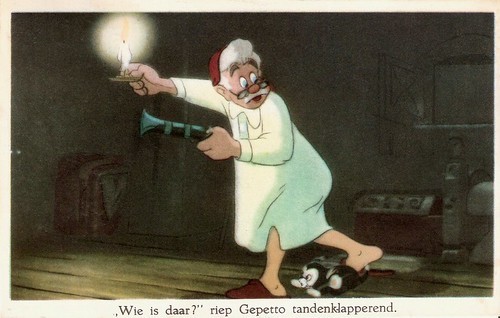
Dutch postcard by Rembrandt Uitg. Mij, Amsterdam. Image: Walt Disney. Publicity still for Pinocchio (Hamilton Luske, Ben Sharpsteen, a.o., 1940). Caption: "Who is there?", Gepetto called with shattering teeth.
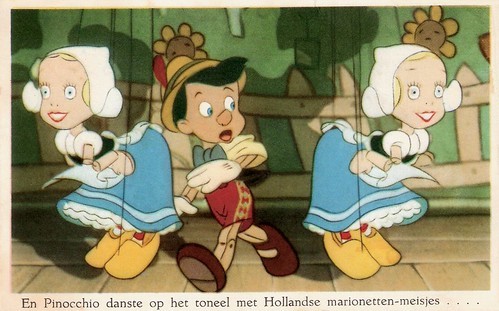
Dutch postcard by Rembrandt Uitg. Mij, Amsterdam. Image: Walt Disney. Publicity still for Pinocchio (Hamilton Luske, Ben Sharpsteen, a.o., 1940). Caption: And Pinocchio danced on stage with the Dutch marionette girls...
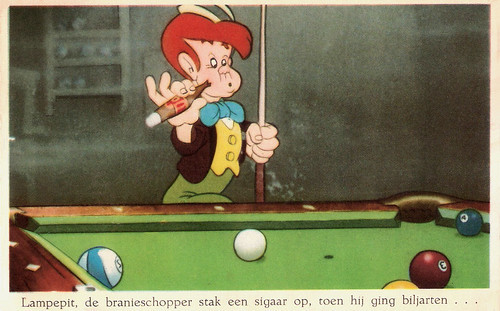
Dutch postcard by Rembrandt Uitg. Mij, Amsterdam. Image: Walt Disney. Publicity still for Pinocchio (Hamilton Luske, Ben Sharpsteen, a.o., 1940). Caption: Lampwick, the britterchopper lit a cigar when he went playing billiards.
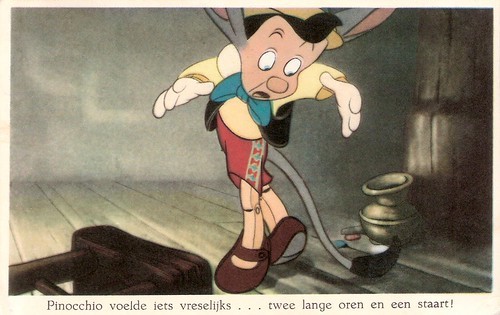
Dutch postcard by Rembrandt Uitg. Mij, Amsterdam. Image: Walt Disney. Publicity still for Pinocchio (Hamilton Luske, Ben Sharpsteen, a.o., 1940). Caption: Pinocchio felt something terrible .... two long ears and a tail!
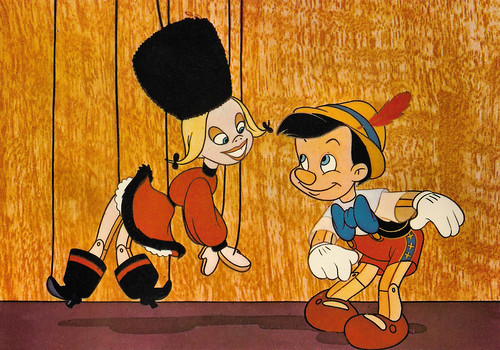
French postcard by Editions Kroma, Caissargues, no. 10. Image: Walt Disney Productions. Publicity still for Pinocchio (Hamilton Luske, Ben Sharpsteen, a.o., 1940).
Childhood is full of temptations
In Pinocchio (Hamilton Luske, Ben Sharpsteen, a.o., 1940), the kind woodcarver Geppetto creates a wooden marionette, which he calls Pinocchio.
His wish for Pinocchio to be a real boy is unexpectedly granted by a fairy. The fairy assigns Jiminy Cricket to act as Pinocchio's 'conscience' and keep him out of trouble.
However, Pinocchio is weak-willed and Jiminy is not too successful in his endeavour. Pinocchio doesn't always listen to reason and most of the film he is deep in trouble.
The story has never a dull moment. In fact Pinocchio is about childhood and temptation. Tasting jam, stealing, not going to school, lying, childhood is full of temptations. Everything is new then everything looks pretty.
When the standard for kids is to obey to authoritarian figures who know the best for them, the most precious lesson in Pinocchio is not to obey for the sake of obedience but to follow your conscience. Differentiate between right or wrong. That's what being a real boy is about, being unselfish, trustful and brave, not being obedient.
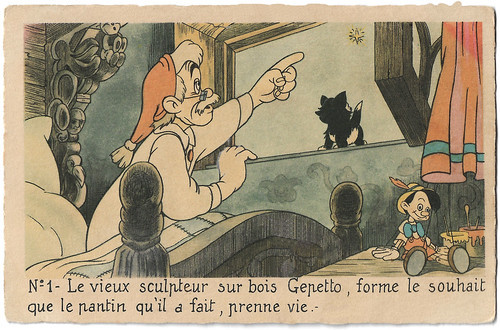
French postcard by Editions E. Séphériadès, Paris, no. 1. Image: Walt Disney - Mickey Mouse S.A. Publicity still for Pinocchio (Hamilton Luske, Ben Sharpsteen, a.o., 1940). Caption: The olf wood sculptor Gepetto wishes that the puppet he made, comes to life.
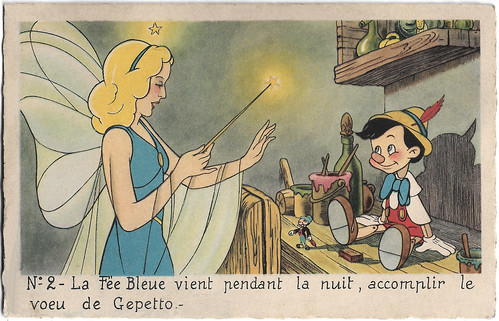
French postcard by Editions E. Séphériadès, Paris, no. 2. Image: Walt Disney - Mickey Mouse S.A. Publicity still for Pinocchio (Hamilton Luske, Ben Sharpsteen, a.o., 1940). Caption: The Blue Fairy comes during the night, to fulfil the wish of Gepetto.
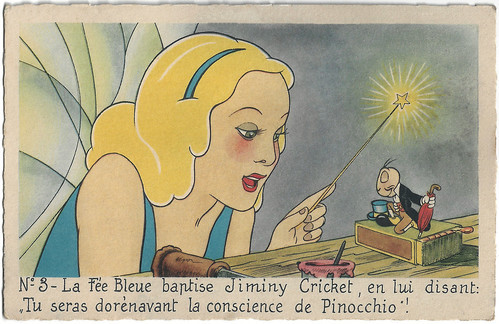
French postcard by Editions E. Séphériadès, Paris, no. 3. Image: Walt Disney - Mickey Mouse S.A. Publicity still for Pinocchio (Hamilton Luske, Ben Sharpsteen, a.o., 1940). Caption: The Blue Fairy baptises Jiminy Cricket, by telling him: "You will be from now on Pinocchio's conscience."
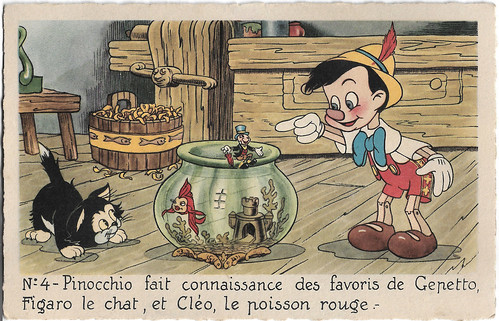
French postcard by Editions E. Séphériadès, Paris, no. 4. Image: Walt Disney - Mickey Mouse S.A. Publicity still for Pinocchio (Hamilton Luske, Ben Sharpsteen, a.o., 1940). Caption: Pinocchio meets Gepetto's favourites, Figaro the cat and Cléo the goldfish.
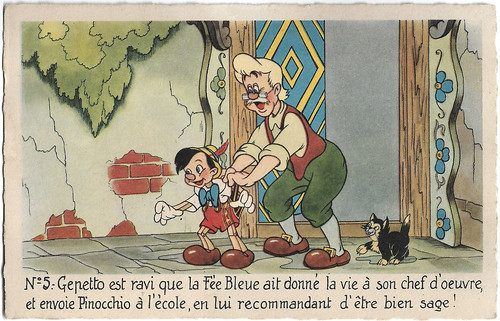
French postcard by Editions E. Séphériadès, Paris, no. 5. Image: Walt Disney - Mickey Mouse S.A. Publicity still for Pinocchio (Hamilton Luske, Ben Sharpsteen, a.o., 1940). Caption: Gepetto is delighted that the Blue Fairy has given life to his masterpiece and sends Pinocchio to school, recommending him to be wise.
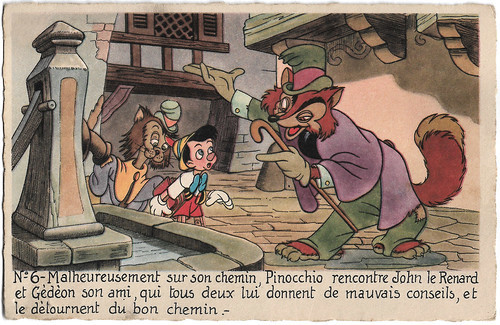
French postcard by Editions Superluxe, Paris, no. 5. Image: Walt Disney - Mickey Mouse S.A. Publicity still for Pinocchio (Hamilton Luske, Ben Sharpsteen, a.o., 1940). Caption: Unfortunately, Pinocchio meets on his way John the Fox and Gèdèon his friend, both of whom give him bad advice, and divert him from the right path.
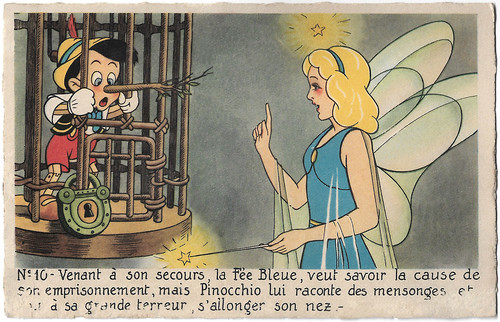
French postcard by Editions E. Séphériadès, Paris, no. 10. Image: Walt Disney - Mickey Mouse S.A. Publicity still for Pinocchio (Hamilton Luske, Ben Sharpsteen, a.o., 1940). Caption: Coming to his aid, the Blue Fairy wants to know the cause of his imprisonment, but Pinocchio tells her lies and to his great terror, she lengthens his nose.
Unforgettable imagery
Although the atmosphere is quite dark and creepy in some parts, most of the time Pinocchio (Hamilton Luske, Ben Sharpsteen, a.o., 1940) is a sweet fairy-tale. It is entertaining, heartwarming and magical.
Animation and soundtrack are superb. Walt Disney made Pinocchio shortly after Snow White and the Seven Dwarfs (William Cottrell, David Hand, a.o., 1937), and the film showed marked improvement in the art of animation technology with startling special effects. The animation makes brilliant use of the multiplane camera, featuring a sprawling opening sequence in which the viewer practically sees the entire village at night.
Geppetto's inventive clocks come to life as realistically as any real-life photography could do. The scene of Geppetto searching for Pinocchio with a lantern on a rainy night after he has been captured by Stromboli is unforgettable imagery.
The characters are colourful and fun. Pinocchio is cute, innocent and lovable like a human child, although stubborn and prone to temptation at times. Jiminy Cricket is humorous and cool, but a bit impatient.
Pinocchio is full of sweet characters like Geppetto's goldfish Cleo and kitten Figaro. Honest John Foulfellow and his sidekick Gideon aka 'Giddy' are the perfect comic relief. Giddy is a cat and a funny mute character. Honest John is the epitome of the sly fox: not 'really' evil, but clever, hilarious, charming, shameless, unscrupulous and greedy. And Monstro, the enormous sperm whale, is one of the most impressive animated beasts of all time.
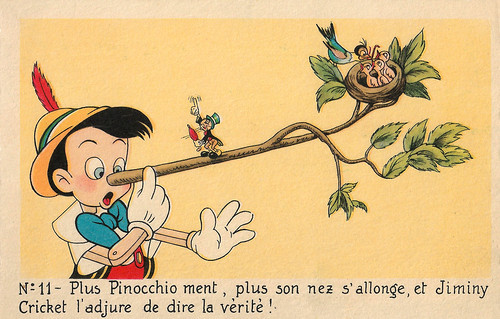
French postcard by Editions E. Séphériadès, Paris, no. 11. Image: Walt Disney - Mickey Mouse S.A. Publicity still for Pinocchio (Hamilton Luske, Ben Sharpsteen, a.o., 1940). Caption: The more Pinocchio lies, the longer his nose gets, and Jiminy Cricket adjures him to tell the truth.
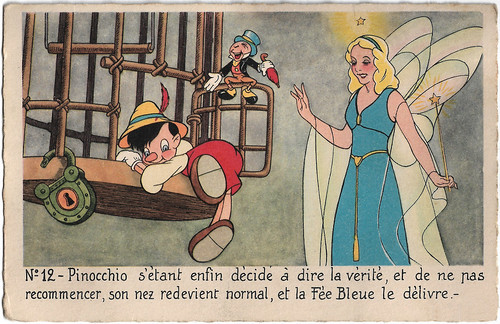
French postcard by Editions Superluxe, Paris, no. 12. Image: Walt Disney - Mickey Mouse S.A. Publicity still for Pinocchio (Hamilton Luske, Ben Sharpsteen, a.o., 1940). Caption: Pinocchio has finally decided to tell the truth, and not to start again. His nose becomes normal again and the Blue Fairy sets him free.
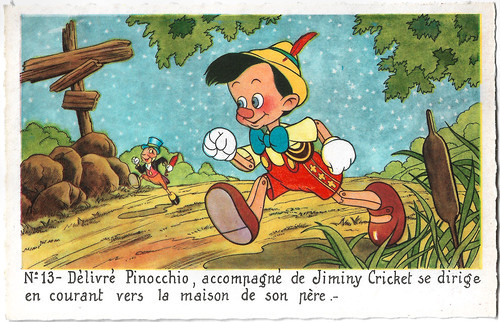
French postcard by Editions Superluxe, Paris, no. 13. Image: Walt Disney - Mickey Mouse S.A. Publicity still for Pinocchio (Hamilton Luske, Ben Sharpsteen, a.o., 1940). Caption: Rescued Pinocchio, accompanied by Jiminy Cricket, runs to his father's house.
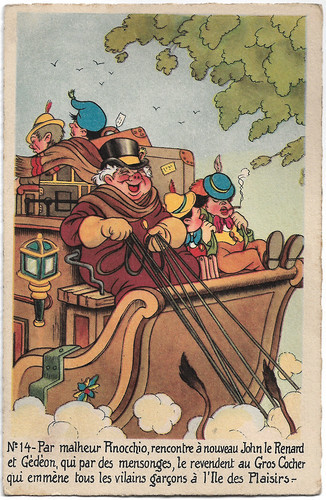
French postcard by Editions Superluxe, Paris, no. 14. Image: Walt Disney - Mickey Mouse S.A. Publicity still for Pinocchio (Hamilton Luske, Ben Sharpsteen, a.o., 1940). Caption: Unfortunately Pinocchio meets John the Fox and Gideon again, who by lies, sell him to the Big Coach who takes all the naughty boys to the Island of Pleasures.

French postcard by Editions E. Séphériadès, Paris, no. 15. Image: Walt Disney - Mickey Mouse S.A. Publicity still for Pinocchio (Hamilton Luske, Ben Sharpsteen, a.o., 1940). Caption: At the Island of Pleasures, Pinocchio with his new friend Lampwick, tastes of all the amusements, and does not want to listen to the advice of Jiminy Cricket.
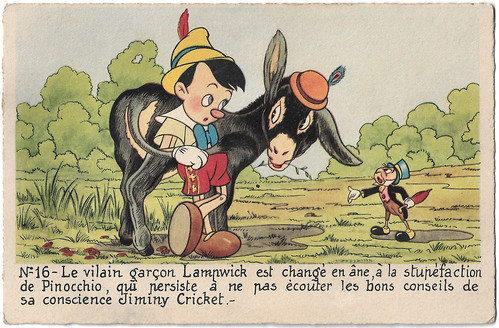
French postcard by Editions E. Séphériadès, Paris, no. 16. Image: Walt Disney - Mickey Mouse S.A. Publicity still for Pinocchio (Hamilton Luske, Ben Sharpsteen, a.o., 1940). Caption: The bad boy Lampwick has changed into an ass, to the stupefaction of Pinocchio, who persists in not listening to the good advice by his conscience Jiminy Cricket.

French postcard by Editions Superluxe, Paris, no. 17. Image: Walt Disney - Mickey Mouse S.A. Publicity still for Pinocchio (Hamilton Luske, Ben Sharpsteen, a.o., 1940). Caption: Having managed to escape from Pleasure Island, Pinocchio and Jiminy cricket finally return home, where they find the door closed and his father away looking for him.
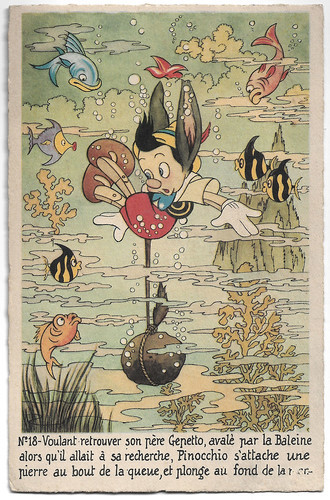
French postcard by Editions E. Séphériadès, Paris, no. 18. Image: Walt Disney - Mickey Mouse S.A. Publicity still for Pinocchio (Hamilton Luske, Ben Sharpsteen, a.o., 1940). Caption: Wanting to find his father Gepetto, swallowed by the Whale when he was looking for him, Pinocchio attaches a stone to the end of the tail, and plunges to the bottom of the sea.
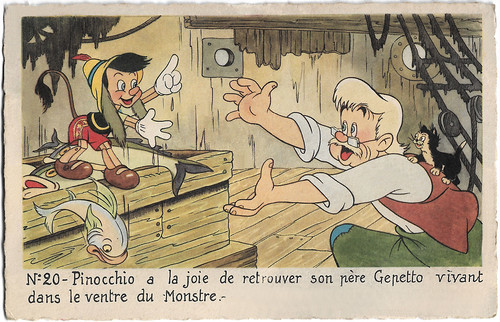
French postcard by Editions E. Séphériadès, Paris, no. 20. Image: Walt Disney - Mickey Mouse S.A. Publicity still for Pinocchio (Hamilton Luske, Ben Sharpsteen, a.o., 1940). Caption: Pinocchio has the joy of finding his father Gepetto alive in the belly of the monster.
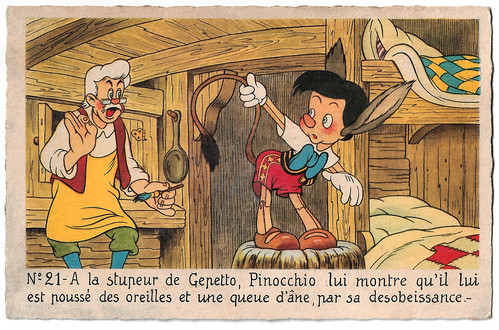
French postcard by Editions E. Séphériadès, Paris, no. 21. Image: Walt Disney - Mickey Mouse S.A. Publicity still for Pinocchio (Hamilton Luske, Ben Sharpsteen, a.o., 1940). Caption: At the bewilderment of Gepetto, Pinocchio shows him that he has ears and a donkey tail, by his disobedience.
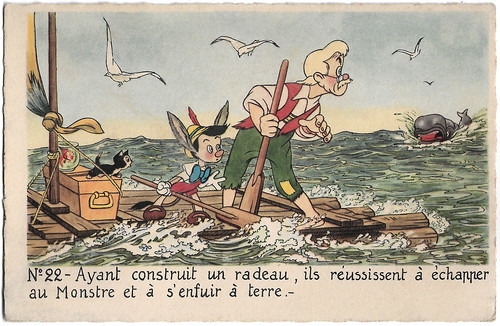
French postcard by Editions E. Séphériadès, Paris, no. 22. Image: Walt Disney - Mickey Mouse S.A. Publicity still for Pinocchio (Hamilton Luske, Ben Sharpsteen, a.o., 1940). Caption: Having built a raft, they managed to escape the monster and to flee to the land.
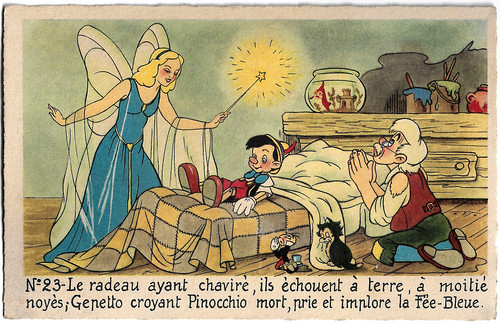
French postcard by Editions E. Séphériadès, Paris, no. 23. Image: Walt Disney - Mickey Mouse S.A. Publicity still for Pinocchio (Hamilton Luske, Ben Sharpsteen, a.o., 1940). Caption: The raft having capsized, they fail on the ground, half drowned; Gepetto believing dead Pinocchio, prays and implores the Blue Fairy.
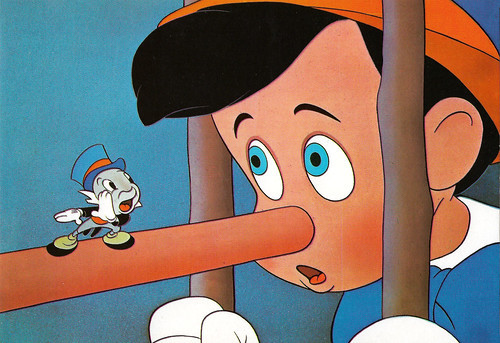
Italian postcard by Grafiche Biondetti, Verona, no. 115/2. Image: Disney. Publicity still for Pinocchio (Hamilton Luske, Ben Sharpsteen, a.o., 1940).

Italian postcard by Grafiche Biondetti, Verona, no. 115/3. Image: Disney. Publicity still for Pinocchio (Hamilton Luske, Ben Sharpsteen, a.o., 1940).
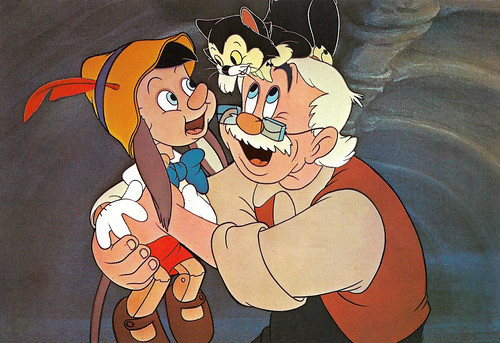
Italian postcard by Grafiche Biondetti, Verona, no. 115/4. Image: Disney. Publicity still for Pinocchio (Hamilton Luske, Ben Sharpsteen, a.o., 1940).
Sources: Wikipedia and IMDb.

Dutch postcard by Rembrandt Uitg. Mij, Amsterdam. Image: Walt Disney. Publicity still for Pinocchio (Hamilton Luske, Ben Sharpsteen, a.o., 1940). Caption: "Who is there?", Gepetto called with shattering teeth.

Dutch postcard by Rembrandt Uitg. Mij, Amsterdam. Image: Walt Disney. Publicity still for Pinocchio (Hamilton Luske, Ben Sharpsteen, a.o., 1940). Caption: And Pinocchio danced on stage with the Dutch marionette girls...

Dutch postcard by Rembrandt Uitg. Mij, Amsterdam. Image: Walt Disney. Publicity still for Pinocchio (Hamilton Luske, Ben Sharpsteen, a.o., 1940). Caption: Lampwick, the britterchopper lit a cigar when he went playing billiards.

Dutch postcard by Rembrandt Uitg. Mij, Amsterdam. Image: Walt Disney. Publicity still for Pinocchio (Hamilton Luske, Ben Sharpsteen, a.o., 1940). Caption: Pinocchio felt something terrible .... two long ears and a tail!

French postcard by Editions Kroma, Caissargues, no. 10. Image: Walt Disney Productions. Publicity still for Pinocchio (Hamilton Luske, Ben Sharpsteen, a.o., 1940).
Childhood is full of temptations
In Pinocchio (Hamilton Luske, Ben Sharpsteen, a.o., 1940), the kind woodcarver Geppetto creates a wooden marionette, which he calls Pinocchio.
His wish for Pinocchio to be a real boy is unexpectedly granted by a fairy. The fairy assigns Jiminy Cricket to act as Pinocchio's 'conscience' and keep him out of trouble.
However, Pinocchio is weak-willed and Jiminy is not too successful in his endeavour. Pinocchio doesn't always listen to reason and most of the film he is deep in trouble.
The story has never a dull moment. In fact Pinocchio is about childhood and temptation. Tasting jam, stealing, not going to school, lying, childhood is full of temptations. Everything is new then everything looks pretty.
When the standard for kids is to obey to authoritarian figures who know the best for them, the most precious lesson in Pinocchio is not to obey for the sake of obedience but to follow your conscience. Differentiate between right or wrong. That's what being a real boy is about, being unselfish, trustful and brave, not being obedient.

French postcard by Editions E. Séphériadès, Paris, no. 1. Image: Walt Disney - Mickey Mouse S.A. Publicity still for Pinocchio (Hamilton Luske, Ben Sharpsteen, a.o., 1940). Caption: The olf wood sculptor Gepetto wishes that the puppet he made, comes to life.

French postcard by Editions E. Séphériadès, Paris, no. 2. Image: Walt Disney - Mickey Mouse S.A. Publicity still for Pinocchio (Hamilton Luske, Ben Sharpsteen, a.o., 1940). Caption: The Blue Fairy comes during the night, to fulfil the wish of Gepetto.

French postcard by Editions E. Séphériadès, Paris, no. 3. Image: Walt Disney - Mickey Mouse S.A. Publicity still for Pinocchio (Hamilton Luske, Ben Sharpsteen, a.o., 1940). Caption: The Blue Fairy baptises Jiminy Cricket, by telling him: "You will be from now on Pinocchio's conscience."

French postcard by Editions E. Séphériadès, Paris, no. 4. Image: Walt Disney - Mickey Mouse S.A. Publicity still for Pinocchio (Hamilton Luske, Ben Sharpsteen, a.o., 1940). Caption: Pinocchio meets Gepetto's favourites, Figaro the cat and Cléo the goldfish.

French postcard by Editions E. Séphériadès, Paris, no. 5. Image: Walt Disney - Mickey Mouse S.A. Publicity still for Pinocchio (Hamilton Luske, Ben Sharpsteen, a.o., 1940). Caption: Gepetto is delighted that the Blue Fairy has given life to his masterpiece and sends Pinocchio to school, recommending him to be wise.

French postcard by Editions Superluxe, Paris, no. 5. Image: Walt Disney - Mickey Mouse S.A. Publicity still for Pinocchio (Hamilton Luske, Ben Sharpsteen, a.o., 1940). Caption: Unfortunately, Pinocchio meets on his way John the Fox and Gèdèon his friend, both of whom give him bad advice, and divert him from the right path.

French postcard by Editions E. Séphériadès, Paris, no. 10. Image: Walt Disney - Mickey Mouse S.A. Publicity still for Pinocchio (Hamilton Luske, Ben Sharpsteen, a.o., 1940). Caption: Coming to his aid, the Blue Fairy wants to know the cause of his imprisonment, but Pinocchio tells her lies and to his great terror, she lengthens his nose.
Unforgettable imagery
Although the atmosphere is quite dark and creepy in some parts, most of the time Pinocchio (Hamilton Luske, Ben Sharpsteen, a.o., 1940) is a sweet fairy-tale. It is entertaining, heartwarming and magical.
Animation and soundtrack are superb. Walt Disney made Pinocchio shortly after Snow White and the Seven Dwarfs (William Cottrell, David Hand, a.o., 1937), and the film showed marked improvement in the art of animation technology with startling special effects. The animation makes brilliant use of the multiplane camera, featuring a sprawling opening sequence in which the viewer practically sees the entire village at night.
Geppetto's inventive clocks come to life as realistically as any real-life photography could do. The scene of Geppetto searching for Pinocchio with a lantern on a rainy night after he has been captured by Stromboli is unforgettable imagery.
The characters are colourful and fun. Pinocchio is cute, innocent and lovable like a human child, although stubborn and prone to temptation at times. Jiminy Cricket is humorous and cool, but a bit impatient.
Pinocchio is full of sweet characters like Geppetto's goldfish Cleo and kitten Figaro. Honest John Foulfellow and his sidekick Gideon aka 'Giddy' are the perfect comic relief. Giddy is a cat and a funny mute character. Honest John is the epitome of the sly fox: not 'really' evil, but clever, hilarious, charming, shameless, unscrupulous and greedy. And Monstro, the enormous sperm whale, is one of the most impressive animated beasts of all time.

French postcard by Editions E. Séphériadès, Paris, no. 11. Image: Walt Disney - Mickey Mouse S.A. Publicity still for Pinocchio (Hamilton Luske, Ben Sharpsteen, a.o., 1940). Caption: The more Pinocchio lies, the longer his nose gets, and Jiminy Cricket adjures him to tell the truth.

French postcard by Editions Superluxe, Paris, no. 12. Image: Walt Disney - Mickey Mouse S.A. Publicity still for Pinocchio (Hamilton Luske, Ben Sharpsteen, a.o., 1940). Caption: Pinocchio has finally decided to tell the truth, and not to start again. His nose becomes normal again and the Blue Fairy sets him free.

French postcard by Editions Superluxe, Paris, no. 13. Image: Walt Disney - Mickey Mouse S.A. Publicity still for Pinocchio (Hamilton Luske, Ben Sharpsteen, a.o., 1940). Caption: Rescued Pinocchio, accompanied by Jiminy Cricket, runs to his father's house.

French postcard by Editions Superluxe, Paris, no. 14. Image: Walt Disney - Mickey Mouse S.A. Publicity still for Pinocchio (Hamilton Luske, Ben Sharpsteen, a.o., 1940). Caption: Unfortunately Pinocchio meets John the Fox and Gideon again, who by lies, sell him to the Big Coach who takes all the naughty boys to the Island of Pleasures.

French postcard by Editions E. Séphériadès, Paris, no. 15. Image: Walt Disney - Mickey Mouse S.A. Publicity still for Pinocchio (Hamilton Luske, Ben Sharpsteen, a.o., 1940). Caption: At the Island of Pleasures, Pinocchio with his new friend Lampwick, tastes of all the amusements, and does not want to listen to the advice of Jiminy Cricket.

French postcard by Editions E. Séphériadès, Paris, no. 16. Image: Walt Disney - Mickey Mouse S.A. Publicity still for Pinocchio (Hamilton Luske, Ben Sharpsteen, a.o., 1940). Caption: The bad boy Lampwick has changed into an ass, to the stupefaction of Pinocchio, who persists in not listening to the good advice by his conscience Jiminy Cricket.

French postcard by Editions Superluxe, Paris, no. 17. Image: Walt Disney - Mickey Mouse S.A. Publicity still for Pinocchio (Hamilton Luske, Ben Sharpsteen, a.o., 1940). Caption: Having managed to escape from Pleasure Island, Pinocchio and Jiminy cricket finally return home, where they find the door closed and his father away looking for him.

French postcard by Editions E. Séphériadès, Paris, no. 18. Image: Walt Disney - Mickey Mouse S.A. Publicity still for Pinocchio (Hamilton Luske, Ben Sharpsteen, a.o., 1940). Caption: Wanting to find his father Gepetto, swallowed by the Whale when he was looking for him, Pinocchio attaches a stone to the end of the tail, and plunges to the bottom of the sea.

French postcard by Editions E. Séphériadès, Paris, no. 20. Image: Walt Disney - Mickey Mouse S.A. Publicity still for Pinocchio (Hamilton Luske, Ben Sharpsteen, a.o., 1940). Caption: Pinocchio has the joy of finding his father Gepetto alive in the belly of the monster.

French postcard by Editions E. Séphériadès, Paris, no. 21. Image: Walt Disney - Mickey Mouse S.A. Publicity still for Pinocchio (Hamilton Luske, Ben Sharpsteen, a.o., 1940). Caption: At the bewilderment of Gepetto, Pinocchio shows him that he has ears and a donkey tail, by his disobedience.

French postcard by Editions E. Séphériadès, Paris, no. 22. Image: Walt Disney - Mickey Mouse S.A. Publicity still for Pinocchio (Hamilton Luske, Ben Sharpsteen, a.o., 1940). Caption: Having built a raft, they managed to escape the monster and to flee to the land.

French postcard by Editions E. Séphériadès, Paris, no. 23. Image: Walt Disney - Mickey Mouse S.A. Publicity still for Pinocchio (Hamilton Luske, Ben Sharpsteen, a.o., 1940). Caption: The raft having capsized, they fail on the ground, half drowned; Gepetto believing dead Pinocchio, prays and implores the Blue Fairy.

Italian postcard by Grafiche Biondetti, Verona, no. 115/2. Image: Disney. Publicity still for Pinocchio (Hamilton Luske, Ben Sharpsteen, a.o., 1940).

Italian postcard by Grafiche Biondetti, Verona, no. 115/3. Image: Disney. Publicity still for Pinocchio (Hamilton Luske, Ben Sharpsteen, a.o., 1940).

Italian postcard by Grafiche Biondetti, Verona, no. 115/4. Image: Disney. Publicity still for Pinocchio (Hamilton Luske, Ben Sharpsteen, a.o., 1940).
Sources: Wikipedia and IMDb.
Published on June 16, 2019 22:00
June 15, 2019
Snow White and the Seven Dwarfs (1937)
Snow White and the Seven Dwarfs (William Cottrell, David Hand, Wilfred Jackson, Larry Morey, Perce Pearce, Ben Sharpsteen, 1937) was produced by Walt Disney Productions and originally released by RKO Radio Pictures. It was the first full-length cell animated feature film and the earliest Disney animated feature film. Walt Disney turned the German fairy tale by the Grimm brothers into a charming family film that is still holding up very well more than 80 years later. EFSP presents vintage postcards made for the film by two different French publishers: E. Séphériades and Editions Superluxe in Paris, plus a vintage German postcard by Erdal-Fabrik in Völklingen. And we added some more recent cards from Belgium and France.
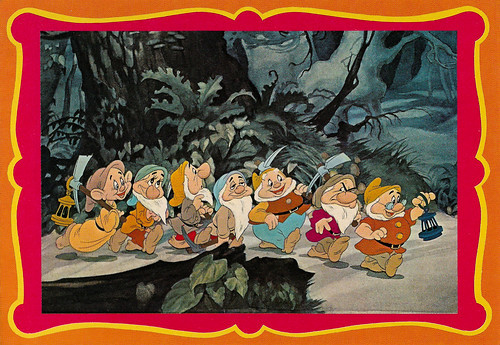
Belgian postcard by Edicorna. Image: Walt Disney - Micky Mouse S.A.. Publicity still for Snow White and the Seven Dwarfs (William Cottrell, David Hand, Wilfred Jackson, Larry Morey, Perce Pearce, Ben Sharpsteen, 1937).
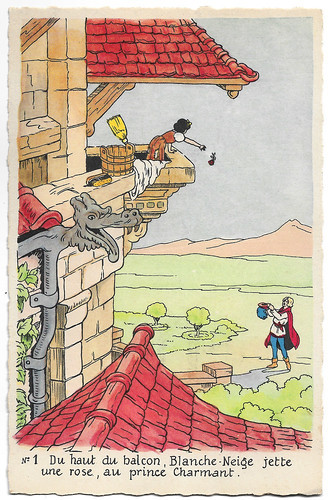
French postcard by Editions Superluxe, Paris, no. 1. Image: Walt Disney - Micky Mouse S.A.. Publicity still for Snow White and the Seven Dwarfs (William Cottrell, David Hand, Wilfred Jackson, Larry Morey, Perce Pearce, Ben Sharpsteen, 1937). Caption: From the top of the balcony, Snow White casts a rose, to Prince Charming.
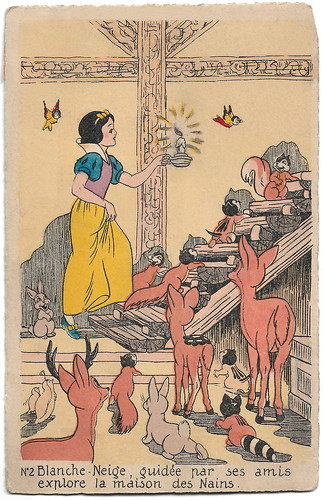
French postcard by E. Séphériades, Paris, no. 2. Image: Walt Disney - Micky Mouse S.A.. Publicity still for Snow White and the Seven Dwarfs (William Cottrell, David Hand, Wilfred Jackson, Larry Morey, Perce Pearce, Ben Sharpsteen, 1937). Caption: Snow White, guided by her friends, explores the house of the dwarfs.
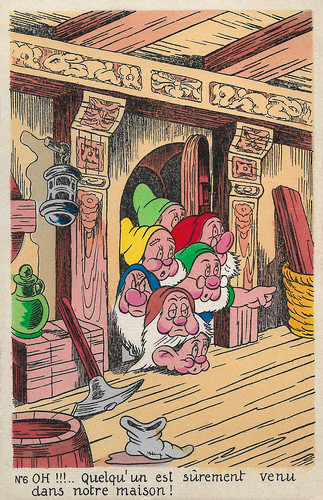
French postcard by Editions Superluxe, Paris, no. 6. Image: Walt Disney - Micky Mouse S.A.. Publicity still for Snow White and the Seven Dwarfs (William Cottrell, David Hand, Wilfred Jackson, Larry Morey, Perce Pearce, Ben Sharpsteen, 1937). Caption: Oh!!!... Someone has surely come into our house!
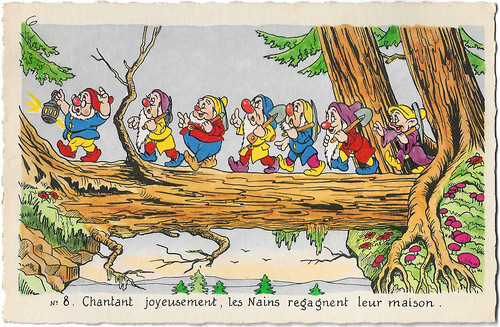
French postcard by Editions Superluxe, Paris, no. 8. Image: Walt Disney - Micky Mouse S.A.. Publicity still for Snow White and the Seven Dwarfs (William Cottrell, David Hand, Wilfred Jackson, Larry Morey, Perce Pearce, Ben Sharpsteen, 1937). Caption: Singing happily, the dwarfs return home.
Heigh Ho
Based on the Brothers Grimm fairy tale, the story of Snow White and the Seven Dwarfs (William Cottrell, David Hand, Wilfred Jackson, Larry Morey, Perce Pearce, Ben Sharpsteen, 1937) is simple enough.
Snow White is a beautiful princess who flees her jealous stepmother and finds refuge with seven friendly dwarfs. The Disney studio spent much time and effort into developing the characters of these seven dwarfs and gave each a distinct personality, a feat which was absent in the original fairy tale.
The artwork is stunning, a virtual watercolour painting come to life. The details in the animation are still amazing. The raindrops in the chase sequence really hit the rocks, and slip away.
The film makers toned down the famous German fairy tale considerably to make it more 'family friendly, but the fascinating and scary transformation of the Wicked Queen into a hideous hag at the climax was the subject of much controversy at the time. No Disney villain would ever be so frightening and enchanting at the same time.
Snow White and the Seven Dwarfs was immediately embraced both by critics and audiences, and received a special Academy Award in 1938.
The songs of the film, like the dwarfs song as they bathe 'Whistle While You Work', their 'Heigh Ho' and Snow White's anthem 'Some Day My Prince Will Come', became evergreens. They were composed by Frank Churchill and Larry Morey.
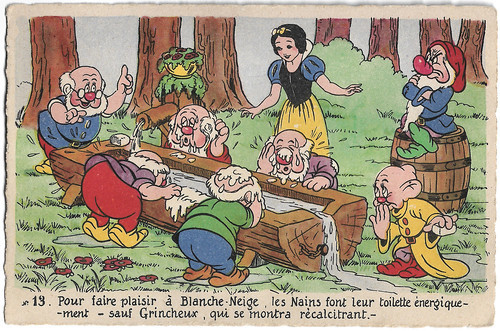
French postcard by Editions Superluxe, Paris, no. 13. Image: Walt Disney - Micky Mouse S.A.. Publicity still for Snow White and the Seven Dwarfs (William Cottrell, David Hand, Wilfred Jackson, Larry Morey, Perce Pearce, Ben Sharpsteen, 1937). Caption: To please Snow White, the Dwarves wash themselves vigourously - except Grumpy who is noticeably obstinate.
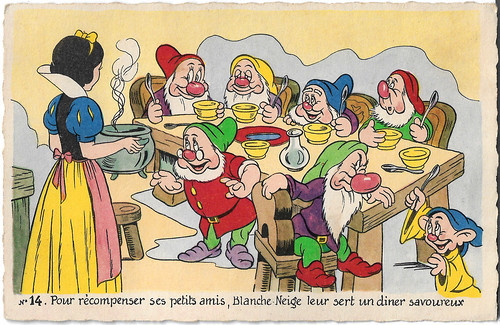
French postcard by Editions Superluxe, Paris, no. 14. Image: Walt Disney - Micky Mouse S.A.. Publicity still for Snow White and the Seven Dwarfs (William Cottrell, David Hand, Wilfred Jackson, Larry Morey, Perce Pearce, Ben Sharpsteen, 1937). Caption: To reward her little friends, Snow White serves them a tasty dinner.
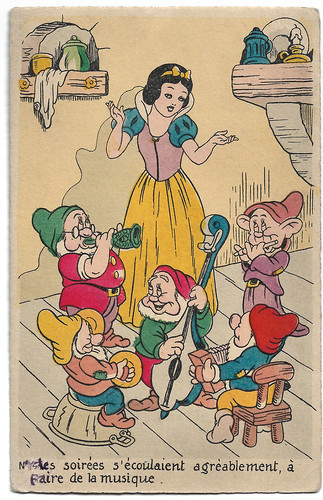
French postcard by E. Séphériades, Paris, no. 15. Image: Walt Disney - Micky Mouse S.A.. Publicity still for Snow White and the Seven Dwarfs (William Cottrell, David Hand, Wilfred Jackson, Larry Morey, Perce Pearce, Ben Sharpsteen, 1937). Caption: Evenings went smoothly, making music.
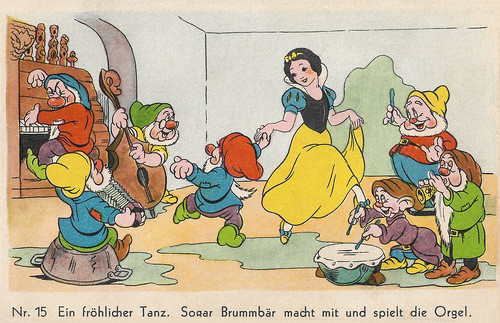
German collectors card by Erdal-Fabrik, Völklingen, no. 15. Image: Walt Disney - Micky Mouse S.A.. Publicity still for Snow White and the Seven Dwarfs (William Cottrell, David Hand, Wilfred Jackson, Larry Morey, Perce Pearce, Ben Sharpsteen, 1937). Caption: A happy dance. Even Grumpy participates and plays the organ.
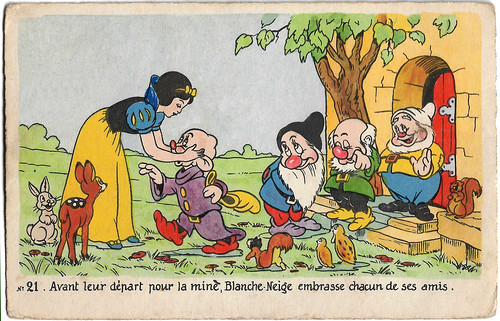
French postcard by Editions Superluxe, Paris, no. 21. Image: Walt Disney - Micky Mouse S.A.. Publicity still for Snow White and the Seven Dwarfs (William Cottrell, David Hand, Wilfred Jackson, Larry Morey, Perce Pearce, Ben Sharpsteen, 1937). Caption: Before their leaving for the mine, Snow White embraces each of her friends.
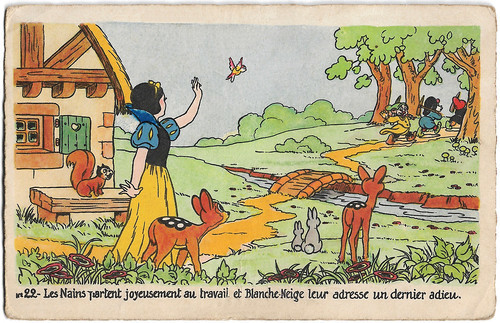
French postcard by Editions Superluxe, Paris, no. 22. Image: Walt Disney - Micky Mouse S.A.. Publicity still for Snow White and the Seven Dwarfs (William Cottrell, David Hand, Wilfred Jackson, Larry Morey, Perce Pearce, Ben Sharpsteen, 1937). Caption: The dwarves leave happily at work and Snow White gives them a last farewell.
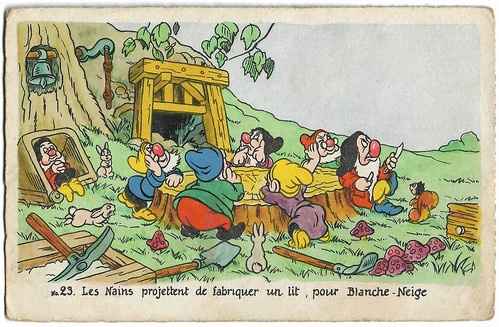
French postcard by Superluxe, Paris, no. 23. Image: Walt Disney - Micky Mouse S.A.. Publicity still for Snow White and the Seven Dwarfs (William Cottrell, David Hand, Wilfred Jackson, Larry Morey, Perce Pearce, Ben Sharpsteen, 1937). Caption: The dwarves plan to make a bed, for Snow White.
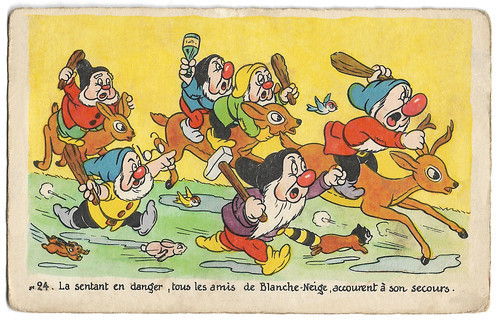
French postcard by Editions Superluxe, Paris, no. 24. Image: Walt Disney - Micky Mouse S.A.. Publicity still for Snow White and the Seven Dwarfs (William Cottrell, David Hand, Wilfred Jackson, Larry Morey, Perce Pearce, Ben Sharpsteen, 1937). Caption: Feeling that she is in danger, all the friends of Snow White come to her rescue.
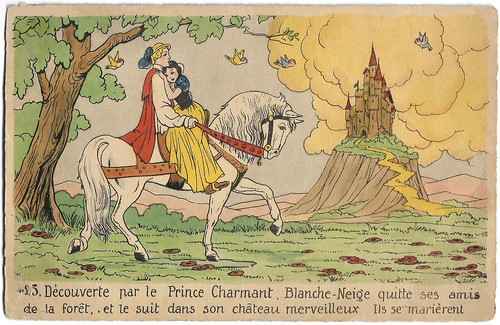
French postcard by Editions Superluxe, Paris, no. 25. Image: Walt Disney - Micky Mouse S.A.. Publicity still for Snow White and the Seven Dwarfs (William Cottrell, David Hand, Wilfred Jackson, Larry Morey, Perce Pearce, Ben Sharpsteen, 1937). Caption: Discovered by Prince Charming, Snow White leaves her friends of the forest and follows him to this marvellous castle. They marry.
Disney's folly
Before Snow White and the Seven Dwarfs (William Cottrell, David Hand, Wilfred Jackson, Larry Morey, Perce Pearce, Ben Sharpsteen, 1937), the Disney studio had been primarily involved in the production of animated short subjects in the Mickey Mouse and Silly Symphonies series.
Disney had hoped to expand his studio's prestige and revenues by moving into features. He had to mortgage his house to help finance the film's production, which eventually ran up a total cost of $1,488,422.74, a massive sum for a feature film in 1937.
Hal Erickson at AllMovie : "Bypassing early temptations to transform the heroine Snow White into a plump Betty Boop type or a woebegone ZaSu Pitts lookalike, the Disney staffers wisely made radical differentiations between the 'straight' and 'funny' characters in the story. Thus, Snow White and Prince Charming moved and were drawn realistically, while the Seven Dwarfs were rendered in the rounded, caricatured manner of Disney's short-subject characters. In this way, the serious elements of the story could be propelled forward in a believable enough manner to grab the adult viewers, while the dwarfs provided enough comic and musical hijinks to keep the kids happy."
Only after the enormous success of 'Disney's folly', other film makers attempted their own full-length cartoon features. Snow White's success led to Disney moving ahead with more feature-film productions.
Walt Disney used much of the profits from Snow White and the Seven Dwarfs to finance a new $4.5 million studio in Burbank – the location on which The Walt Disney Studios is located to this day.
Within two years, the studio completed Pinocchio and Fantasia and had begun production on features such as Dumbo, Bambi, Alice in Wonderland and Peter Pan.
In 1989, the United States Library of Congress deemed Snow White and the Seven Dwarfs "culturally, historically, or aesthetically significant" and selected it for preservation in the National Film Registry.
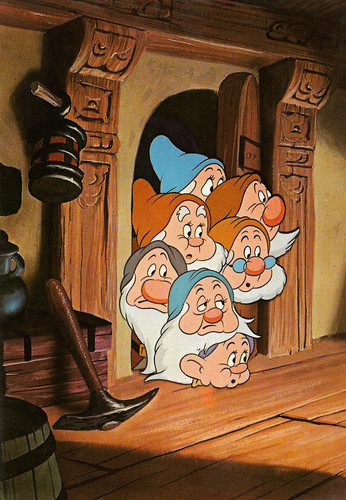
French postcard in the series Le Monde merveilleux de Walt Disney by Editions Kroma, Casissargues, no. 201-1. Image: Walt Disney Productions. Publicity still for Snow White and the Seven Dwarfs (William Cottrell, David Hand, Wilfred Jackson, Larry Morey, Perce Pearce, Ben Sharpsteen, 1937).
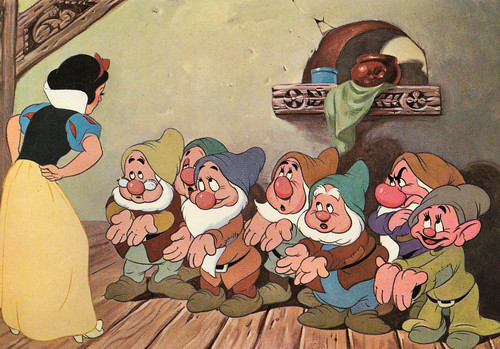
French postcard in the series The Wonderful World of Walt Disney by Editions Kroma, Caissargues, no. 202. Image: Walt Disney Productions. Publicity still for Snow White and the Seven Dwarfs (William Cottrell, David Hand, Wilfred Jackson, Larry Morey, Perce Pearce, Ben Sharpsteen, 1937).
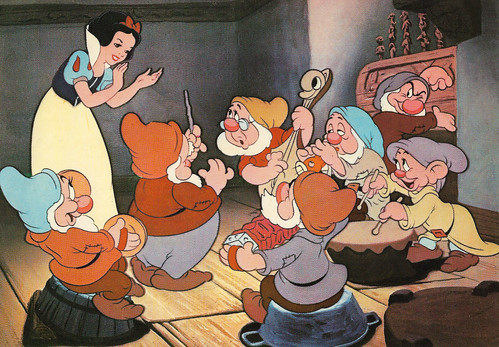
French postcard in the series The Wonderful World of Walt Disney by Editions Kroma, Caissargues, no. 203. Image: Walt Disney Productions. Publicity still for Snow White and the Seven Dwarfs (William Cottrell, David Hand, Wilfred Jackson, Larry Morey, Perce Pearce, Ben Sharpsteen, 1937).
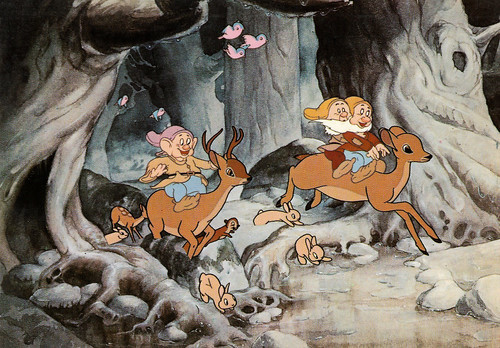
French postcard in the series Le Monde merveilleux de Walt Disney by Editions Kroma, Casissargues, no. 206. Image: Walt Disney Productions. Publicity still for Snow White and the Seven Dwarfs (William Cottrell, David Hand, Wilfred Jackson, Larry Morey, Perce Pearce, Ben Sharpsteen, 1937).
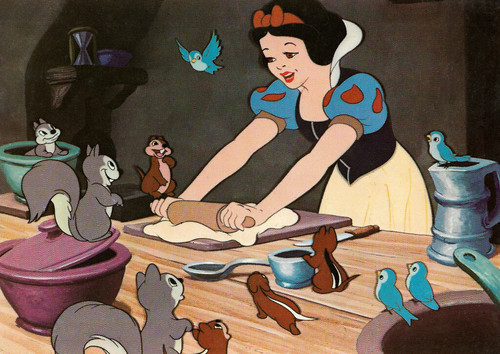
French postcard in the series Le Monde merveilleux de Walt Disney by Editions Kroma, Casissargues, no. 207. Image: Walt Disney Productions. Publicity still for Snow White and the Seven Dwarfs (William Cottrell, David Hand, Wilfred Jackson, Larry Morey, Perce Pearce, Ben Sharpsteen, 1937).
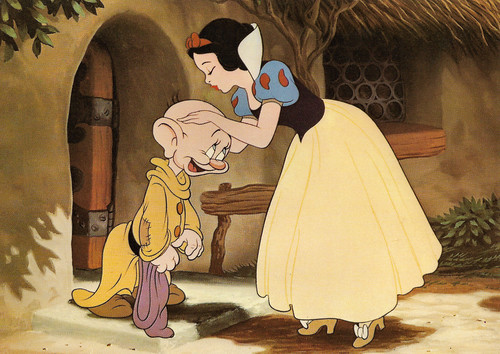
French postcard in the series The Wonderful World of Walt Disney by Editions Kroma, Caissargues, no. 208. Image: Walt Disney Productions. Publicity still for Snow White and the Seven Dwarfs (William Cottrell, David Hand, Wilfred Jackson, Larry Morey, Perce Pearce, Ben Sharpsteen, 1937).
Sources: Hal Erickson (AllMovie), Wikipedia and IMDb.

Belgian postcard by Edicorna. Image: Walt Disney - Micky Mouse S.A.. Publicity still for Snow White and the Seven Dwarfs (William Cottrell, David Hand, Wilfred Jackson, Larry Morey, Perce Pearce, Ben Sharpsteen, 1937).

French postcard by Editions Superluxe, Paris, no. 1. Image: Walt Disney - Micky Mouse S.A.. Publicity still for Snow White and the Seven Dwarfs (William Cottrell, David Hand, Wilfred Jackson, Larry Morey, Perce Pearce, Ben Sharpsteen, 1937). Caption: From the top of the balcony, Snow White casts a rose, to Prince Charming.

French postcard by E. Séphériades, Paris, no. 2. Image: Walt Disney - Micky Mouse S.A.. Publicity still for Snow White and the Seven Dwarfs (William Cottrell, David Hand, Wilfred Jackson, Larry Morey, Perce Pearce, Ben Sharpsteen, 1937). Caption: Snow White, guided by her friends, explores the house of the dwarfs.

French postcard by Editions Superluxe, Paris, no. 6. Image: Walt Disney - Micky Mouse S.A.. Publicity still for Snow White and the Seven Dwarfs (William Cottrell, David Hand, Wilfred Jackson, Larry Morey, Perce Pearce, Ben Sharpsteen, 1937). Caption: Oh!!!... Someone has surely come into our house!

French postcard by Editions Superluxe, Paris, no. 8. Image: Walt Disney - Micky Mouse S.A.. Publicity still for Snow White and the Seven Dwarfs (William Cottrell, David Hand, Wilfred Jackson, Larry Morey, Perce Pearce, Ben Sharpsteen, 1937). Caption: Singing happily, the dwarfs return home.
Heigh Ho
Based on the Brothers Grimm fairy tale, the story of Snow White and the Seven Dwarfs (William Cottrell, David Hand, Wilfred Jackson, Larry Morey, Perce Pearce, Ben Sharpsteen, 1937) is simple enough.
Snow White is a beautiful princess who flees her jealous stepmother and finds refuge with seven friendly dwarfs. The Disney studio spent much time and effort into developing the characters of these seven dwarfs and gave each a distinct personality, a feat which was absent in the original fairy tale.
The artwork is stunning, a virtual watercolour painting come to life. The details in the animation are still amazing. The raindrops in the chase sequence really hit the rocks, and slip away.
The film makers toned down the famous German fairy tale considerably to make it more 'family friendly, but the fascinating and scary transformation of the Wicked Queen into a hideous hag at the climax was the subject of much controversy at the time. No Disney villain would ever be so frightening and enchanting at the same time.
Snow White and the Seven Dwarfs was immediately embraced both by critics and audiences, and received a special Academy Award in 1938.
The songs of the film, like the dwarfs song as they bathe 'Whistle While You Work', their 'Heigh Ho' and Snow White's anthem 'Some Day My Prince Will Come', became evergreens. They were composed by Frank Churchill and Larry Morey.

French postcard by Editions Superluxe, Paris, no. 13. Image: Walt Disney - Micky Mouse S.A.. Publicity still for Snow White and the Seven Dwarfs (William Cottrell, David Hand, Wilfred Jackson, Larry Morey, Perce Pearce, Ben Sharpsteen, 1937). Caption: To please Snow White, the Dwarves wash themselves vigourously - except Grumpy who is noticeably obstinate.

French postcard by Editions Superluxe, Paris, no. 14. Image: Walt Disney - Micky Mouse S.A.. Publicity still for Snow White and the Seven Dwarfs (William Cottrell, David Hand, Wilfred Jackson, Larry Morey, Perce Pearce, Ben Sharpsteen, 1937). Caption: To reward her little friends, Snow White serves them a tasty dinner.

French postcard by E. Séphériades, Paris, no. 15. Image: Walt Disney - Micky Mouse S.A.. Publicity still for Snow White and the Seven Dwarfs (William Cottrell, David Hand, Wilfred Jackson, Larry Morey, Perce Pearce, Ben Sharpsteen, 1937). Caption: Evenings went smoothly, making music.

German collectors card by Erdal-Fabrik, Völklingen, no. 15. Image: Walt Disney - Micky Mouse S.A.. Publicity still for Snow White and the Seven Dwarfs (William Cottrell, David Hand, Wilfred Jackson, Larry Morey, Perce Pearce, Ben Sharpsteen, 1937). Caption: A happy dance. Even Grumpy participates and plays the organ.

French postcard by Editions Superluxe, Paris, no. 21. Image: Walt Disney - Micky Mouse S.A.. Publicity still for Snow White and the Seven Dwarfs (William Cottrell, David Hand, Wilfred Jackson, Larry Morey, Perce Pearce, Ben Sharpsteen, 1937). Caption: Before their leaving for the mine, Snow White embraces each of her friends.

French postcard by Editions Superluxe, Paris, no. 22. Image: Walt Disney - Micky Mouse S.A.. Publicity still for Snow White and the Seven Dwarfs (William Cottrell, David Hand, Wilfred Jackson, Larry Morey, Perce Pearce, Ben Sharpsteen, 1937). Caption: The dwarves leave happily at work and Snow White gives them a last farewell.

French postcard by Superluxe, Paris, no. 23. Image: Walt Disney - Micky Mouse S.A.. Publicity still for Snow White and the Seven Dwarfs (William Cottrell, David Hand, Wilfred Jackson, Larry Morey, Perce Pearce, Ben Sharpsteen, 1937). Caption: The dwarves plan to make a bed, for Snow White.

French postcard by Editions Superluxe, Paris, no. 24. Image: Walt Disney - Micky Mouse S.A.. Publicity still for Snow White and the Seven Dwarfs (William Cottrell, David Hand, Wilfred Jackson, Larry Morey, Perce Pearce, Ben Sharpsteen, 1937). Caption: Feeling that she is in danger, all the friends of Snow White come to her rescue.

French postcard by Editions Superluxe, Paris, no. 25. Image: Walt Disney - Micky Mouse S.A.. Publicity still for Snow White and the Seven Dwarfs (William Cottrell, David Hand, Wilfred Jackson, Larry Morey, Perce Pearce, Ben Sharpsteen, 1937). Caption: Discovered by Prince Charming, Snow White leaves her friends of the forest and follows him to this marvellous castle. They marry.
Disney's folly
Before Snow White and the Seven Dwarfs (William Cottrell, David Hand, Wilfred Jackson, Larry Morey, Perce Pearce, Ben Sharpsteen, 1937), the Disney studio had been primarily involved in the production of animated short subjects in the Mickey Mouse and Silly Symphonies series.
Disney had hoped to expand his studio's prestige and revenues by moving into features. He had to mortgage his house to help finance the film's production, which eventually ran up a total cost of $1,488,422.74, a massive sum for a feature film in 1937.
Hal Erickson at AllMovie : "Bypassing early temptations to transform the heroine Snow White into a plump Betty Boop type or a woebegone ZaSu Pitts lookalike, the Disney staffers wisely made radical differentiations between the 'straight' and 'funny' characters in the story. Thus, Snow White and Prince Charming moved and were drawn realistically, while the Seven Dwarfs were rendered in the rounded, caricatured manner of Disney's short-subject characters. In this way, the serious elements of the story could be propelled forward in a believable enough manner to grab the adult viewers, while the dwarfs provided enough comic and musical hijinks to keep the kids happy."
Only after the enormous success of 'Disney's folly', other film makers attempted their own full-length cartoon features. Snow White's success led to Disney moving ahead with more feature-film productions.
Walt Disney used much of the profits from Snow White and the Seven Dwarfs to finance a new $4.5 million studio in Burbank – the location on which The Walt Disney Studios is located to this day.
Within two years, the studio completed Pinocchio and Fantasia and had begun production on features such as Dumbo, Bambi, Alice in Wonderland and Peter Pan.
In 1989, the United States Library of Congress deemed Snow White and the Seven Dwarfs "culturally, historically, or aesthetically significant" and selected it for preservation in the National Film Registry.

French postcard in the series Le Monde merveilleux de Walt Disney by Editions Kroma, Casissargues, no. 201-1. Image: Walt Disney Productions. Publicity still for Snow White and the Seven Dwarfs (William Cottrell, David Hand, Wilfred Jackson, Larry Morey, Perce Pearce, Ben Sharpsteen, 1937).

French postcard in the series The Wonderful World of Walt Disney by Editions Kroma, Caissargues, no. 202. Image: Walt Disney Productions. Publicity still for Snow White and the Seven Dwarfs (William Cottrell, David Hand, Wilfred Jackson, Larry Morey, Perce Pearce, Ben Sharpsteen, 1937).

French postcard in the series The Wonderful World of Walt Disney by Editions Kroma, Caissargues, no. 203. Image: Walt Disney Productions. Publicity still for Snow White and the Seven Dwarfs (William Cottrell, David Hand, Wilfred Jackson, Larry Morey, Perce Pearce, Ben Sharpsteen, 1937).

French postcard in the series Le Monde merveilleux de Walt Disney by Editions Kroma, Casissargues, no. 206. Image: Walt Disney Productions. Publicity still for Snow White and the Seven Dwarfs (William Cottrell, David Hand, Wilfred Jackson, Larry Morey, Perce Pearce, Ben Sharpsteen, 1937).

French postcard in the series Le Monde merveilleux de Walt Disney by Editions Kroma, Casissargues, no. 207. Image: Walt Disney Productions. Publicity still for Snow White and the Seven Dwarfs (William Cottrell, David Hand, Wilfred Jackson, Larry Morey, Perce Pearce, Ben Sharpsteen, 1937).

French postcard in the series The Wonderful World of Walt Disney by Editions Kroma, Caissargues, no. 208. Image: Walt Disney Productions. Publicity still for Snow White and the Seven Dwarfs (William Cottrell, David Hand, Wilfred Jackson, Larry Morey, Perce Pearce, Ben Sharpsteen, 1937).
Sources: Hal Erickson (AllMovie), Wikipedia and IMDb.
Published on June 15, 2019 22:00
June 14, 2019
Photo by Disney
Today, the Walt Disney Company is a diversified multinational mass media and entertainment conglomerate, even the world's largest independent media conglomerate in terms of revenue. On 16 October 1923, two brothers - Walt and Roy O. Disney - founded the Disney Brothers Cartoon Studio; later operating under the names The Walt Disney Studio and Walt Disney Productions. The company established itself as a leader in the American animation industry before diversifying into live-action film production, television, and theme parks. But it all started with Mickey Mouse, who was created in 1928 and is still the signature mascot and emblem for Disney.
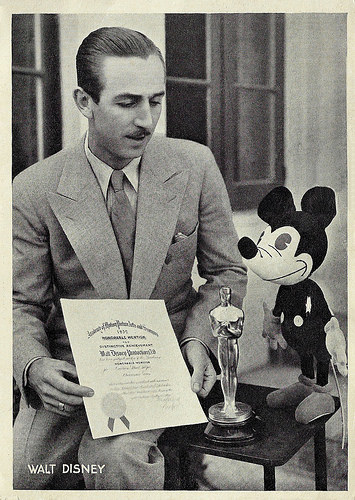
Vintage postcard. In 1932, Walt Disney received an honorary Academy Award for creating Mickey Mouse.
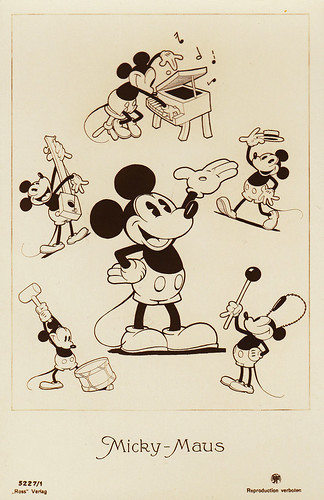
German postcard by Ross Verlag, no. 5227/1, 1930-1931. Image: Walt Disney. Collection: Marlene Pilaete.
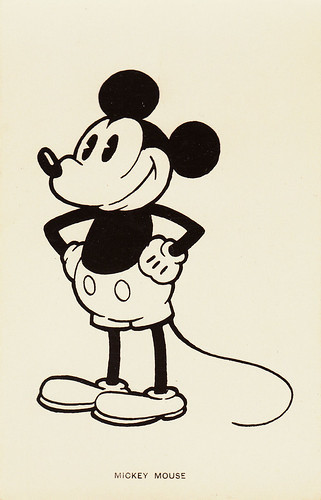
British postcard in the Picturegoer series. Image: Walt Disney. Collection: Marlene Pilaete.
 >
>
German postcard by Ross-Verlag, Berlin, no. 5174/2, 1930-1931. Photo: Harlip, Berlin. Mickey surrenders Europe and Olga Tschechova .
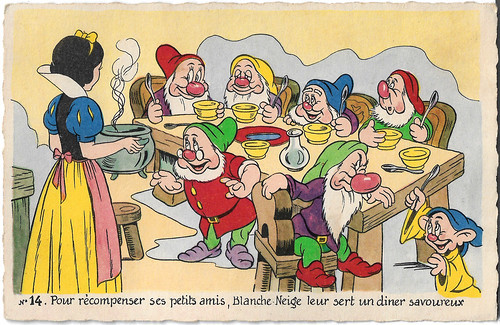
French postcard by Editions Superluxe, Paris, no. 14. Image: Walt Disney - Micky Mouse S.A.. Publicity still for Snow White and the Seven Dwarfs (William Cottrell, David Hand, Wilfred Jackson, Larry Morey, Perce Pearce, Ben Sharpsteen, 1937). Caption: To reward her little friends, Snow White serves them a tasty dinner.
A Mouse named Mortimer
In early 1923, animator Walt Disney created a short film entitled Alice's Wonderland, which featured child actress Virginia Davis interacting with animated characters. After the bankruptcy in 1923 of his previous firm, Laugh-O-Gram Studio, Disney moved to Hollywood to join his brother, Roy O. Disney. Film distributor Margaret J. Winkler of M.J. Winkler Productions contacted Disney with plans to distribute a whole series of Alice Comedies purchased for $1,500 per reel with Disney as a production partner.
Walt and Roy Disney formed Disney Brothers Cartoon Studio that same year. More animated films followed after Alice. In January 1926, with the completion of the Disney studio on Hyperion Street, the Disney Brothers Studio's name was changed to the Walt Disney Studio. Hundreds of Alice Comedies were produced between 1923 and 1927, before they lost popularity.
After the demise of the Alice Comedies, Disney developed an all-cartoon series starring his first original character, Oswald the Lucky Rabbit, which was distributed by Winkler Pictures through Universal Pictures. The distributor owned Oswald, so Disney only made a few hundred dollars.
From 1927 on, Disney completed 26 Oswald shorts before losing the contract in February 1928, due to a legal loophole, when Winkler's husband Charles Mintz took over their distribution company. After failing to take over the Disney Studio, Mintz hired away four of Disney's primary animators (the exception being Ub Iwerks) to start his own animation studio, Snappy Comedies.
In 1928, to recover from the loss of Oswald the Lucky Rabbit, Disney came up with the idea of a mouse character named Mortimer while on a train headed to California, drawing up a few simple drawings. The mouse was later renamed Mickey Mouse and starred in several Disney produced films. Ub Iwerks refined Disney's initial design of Mickey Mouse.
Disney's first sound film Steamboat Willie (Walt Disney, Ub Iwerks, 1928), a cartoon starring Mickey, was released in 1928 through Pat Powers' distribution company. It was the first Mickey Mouse sound cartoon released, but the third to be created, behind Plane Crazy (Walt Disney, Ub Iwerks, 1928), and The Gallopin' Gaucho (Walt Disney, Ub Iwerks, 1928).
Steamboat Willie, with Walt as the voice of Mickey, was an immediate smash hit, and its initial success was attributed not just to Mickey's appeal as a character, but to the fact that it was the first cartoon to feature synchronised sound. Disney's Plane Crazy and The Gallopin' Gaucho were then retrofitted with synchronised sound tracks and re-released successfully in 1929.
Disney continued to produce cartoons with Mickey Mouse and friends, including Minnie Mouse, Donald Duck, Goofy, Pluto, and plenty more. He began the Silly Symphony series, a cartoon series that didn't have a continuous character, with Columbia Pictures signing on as Symphonies distributor in August 1929. In September 1929, theatre manager Harry Woodin requested permission to start a Mickey Mouse Club which Walt approved. In November, test comics strips were sent to King Features, who requested additional samples to show to the publisher, William Randolph Hearst. On 30 December, King Features signed its first newspaper, New York Mirror, to publish the Mickey Mouse comic strip with Walt's permission.
In 1932, Disney signed an exclusive contract with Technicolor (through the end of 1935) to produce cartoons in colour. The first, Flowers and Trees (Burt Gillett, 1932), was also the first cartoon to win an Oscar. Another cartoon, Three Little Pigs (Burt Gillett, 1933), was so popular it was often billed above the feature films it accompanied. Disney released cartoons through Powers' Celebrity Pictures (1928–1930), Columbia Pictures (1930–1932), and United Artists (1932–1937). The popularity of the Mickey Mouse series allowed Disney to plan for his first feature-length animation. Criticasters called it "Disney's Folly".
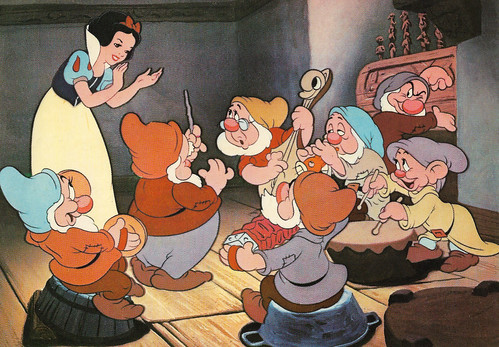
French postcard in the series The Wonderful World of Walt Disney by Editions Kroma, Caissargues, no. 203. Image: Walt Disney Productions. Publicity still for Snow White and the Seven Dwarfs (William Cottrell, David Hand, Wilfred Jackson, Larry Morey, Perce Pearce, Ben Sharpsteen, 1937).
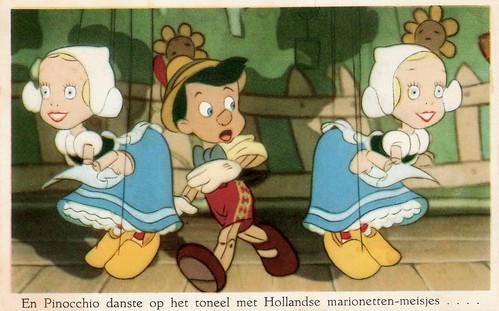
Dutch postcard by Rembrandt Uitg. Mij, Amsterdam. Image: Walt Disney. Publicity still for Pinocchio (Hamilton Luske, Ben Sharpsteen, a.o., 1940). Caption: "And Pinocchio danced on stage with the Dutch marionette girls..."
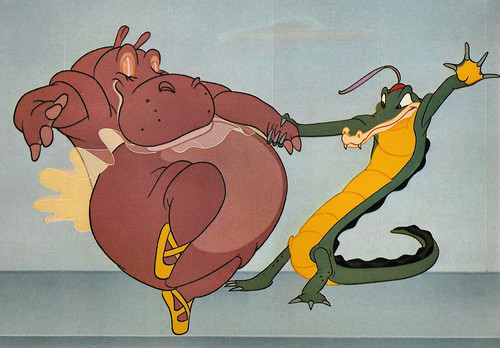
French postcard in the series The Wonderful World of Walt Disney by Editions Kroma, Caissargues, no. 6. Image: Walt Disney Productions. Publicity still for Fantasia (James Algar, Wilfred Jackson, Hamilton Luske, Ben Sharpsteen, a.o., 1940). Hyacinth Hippo and alligator dance partner in the segment Dance of the Hours.
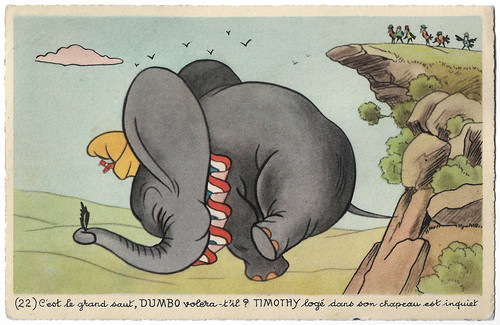
French postcard by Editions Superluxe, Paris, no. 22. Sent by mail in 1953. Image: Walt Disney Productions. Publicity still for Dumbo (Ben Sharpsteen, a.o., 1941). Caption: This is the big jump, Dumbo will fly? Timothy lodged in his hat is worried.
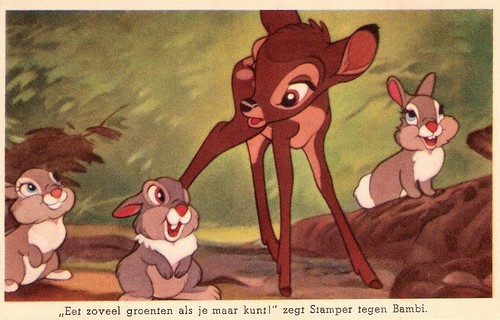
Dutch postcard by Rembrandt Uitg. Mij. Amsterdam, circa 1949. Publicity still for Bambi (David Hand, 1942). Caption: Eat as many vegetables as you can, Thumper says to Bambi.
Pushing the boundaries of Animation
Walt Disney decided to push the boundaries of animation further. He began production of his first feature-length animated film in 1934. Taking three years to complete, Snow White and the Seven Dwarfs (William Cottrell, David Hand, Wilfred Jackson, Larry Morey, Perce Pearce, Ben Sharpsteen, 1937), premiered in December 1937 and by 1939 became the highest-grossing film of that time. Snow White was released through RKO Radio Pictures, which had assumed distribution of Disney's product in July 1937, after United Artists attempted to attain future television rights to the Disney shorts.
Using the profits from Snow White, Disney financed the construction of a new 51-acre (210,000 m2) studio complex in Burbank, California. The new Walt Disney Studios, in which the company is headquartered to this day, was completed and open for business by the end of 1939. The studio continued releasing animated shorts and features, such as Pinocchio (Hamilton Luske, Ben Sharpsteen, a.o., 1940), Fantasia (James Algar, Wilfred Jackson, Hamilton Luske, Ben Sharpsteen, a.o., 1940), Dumbo (Ben Sharpsteen, a.o., 1941), and Bambi (David Hand, 1942).
After World War II began, box office profits declined. When the United States entered the war after the attack on Pearl Harbor, many of Disney's animators were drafted into the armed forces. The U.S. and Canadian governments commissioned the studio to produce training and propaganda films. By 1942, 90% of its 550 employees were working on war-related films. Films such as the feature Victory Through Air Power (Perce Pearce, a.o., 1943) and the short Education for Death (Clyde Geronimi, 1943) were meant to increase public support for the war effort. Even the studio's characters joined the effort, as Donald Duck appeared in a number of comical propaganda shorts, including the Academy Award-winning Der Fuehrer's Face (Jack Kinney, 1943).
With limited staff and little operating capital during and after the war, Disney's feature films during much of the 1940s were 'package films', or collections of shorts, such as The Three Caballeros (Norman Ferguson, a.o., 1944) and Melody Time (Jack Kinney, Clyde Geronimi, Hamilton Luske, Wilfred Jackson, 1948), which performed poorly at the box office.
At the same time, the studio began producing live-action films and documentaries. Song of the South (Harve Foster, Wilfred Jackson, 1946) and So Dear to My Heart (Harold D. Schuster, Hamilton Luske, 1948) featured animated segments, while the True-Life Adventures series, which included such films as Seal Island (James Algar, 1948) and The Vanishing Prairie (James Algar, 1954), were also popular. Eight of the films in the series won Academy Awards.
The release of Cinderella (Clyde Geronimi, Hamilton Luske, Wilfred Jackson, 1950) proved that feature-length animation could still succeed in the marketplace. Other releases of the period included Alice in Wonderland (Clyde Geronimi, Wilfred Jackson, Hamilton Luske, 1951) and Peter Pan (Clyde Geronimi, Wilfred Jackson, Hamilton Luske, 1953), both in production before the war began, and Disney's first all-live action feature, Treasure Island (Byron Haskin, 1950). Disney ended its distribution contract with RKO in 1953, forming its own distribution arm, Buena Vista Distribution.
In December 1950, Walt Disney Productions and the Coca-Cola Company teamed up for Disney's first venture into television, the NBC television network special An Hour in Wonderland. In October 1954, the ABC network launched Disney's first regular television series.
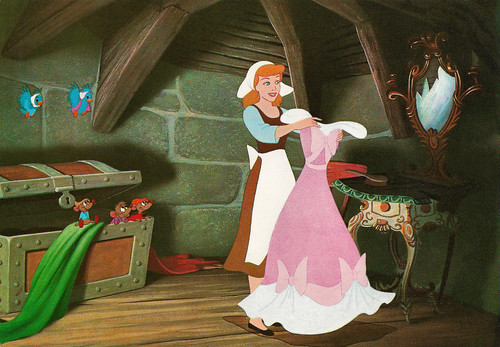
Italian postcard by Grafiche Biondetti, Verona, no. 104. Picture: Walt Disney Productions. Publicity still for Cinderella (Clyde Geronimi, Wilfred Jackson, Hamilton Luske, 1950).
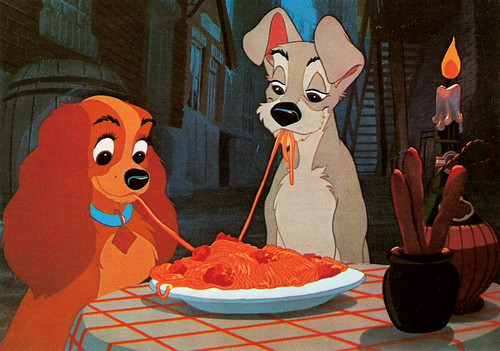
Italian postcard by Grafiche Biondetti S.R.L., Verona, no. 108/4. Image: Disney. Publicity still for Lady and the Tramp (Clyde Geronimi, Wilfred Jackson, Hamilton Luske, 1955).
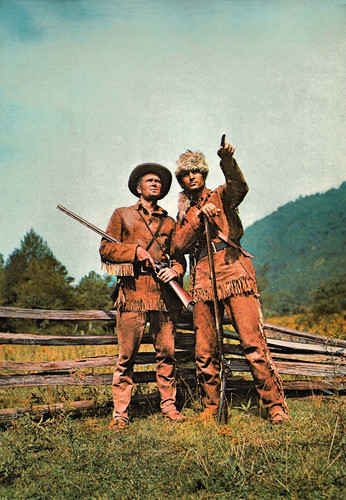
French card by Jouets Masport, Chanas (Isère), no. 39/882. Photo: Walt Disney. Fess Parker and Buddy Ebsen in Davy Crockett - King of the Wild Frontier/Davy Crockett (Norman Foster, 1955).
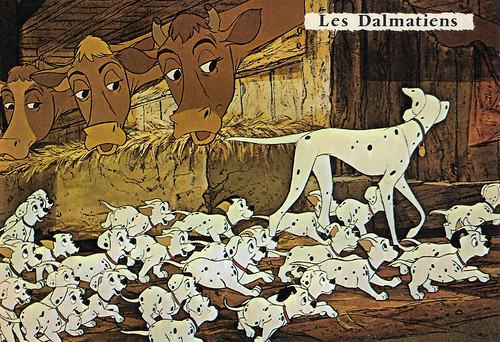
French postcard by Editions Krõma, Paris in the Le monde merveuilleux de Walt Disney series. Illustration: Walt Disney Productions. Publicity still for One Hundred and One Dalmatians (Clyde Geronimi, Hamilton Luske, 1961).
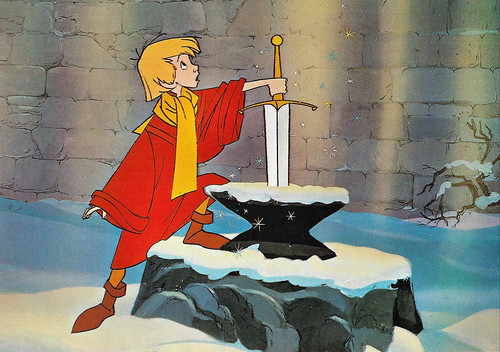
Italian postcard by Grafiche Biondetti S.R.L., Verona, no. 116/1. Image: Disney. Publicity still for The Sword in the Stone (Wolfgang Reitherman, 1963).
Walt Disney's Magnum Opus
In 1954, Walt Disney used his Disneyland series to unveil what would become Disneyland, an idea conceived out of a desire for a place where parents and children could both have fun at the same time. In 1955, Disney opened Disneyland to the general public. After a shaky start, Disneyland continued to grow and attract visitors from across the country and around the world. In 1965, a second Disney theme park, Disney World', was announced, outside of Orlando, Florida.
Disney continued to focus its talents on television throughout the 1950s. Its weekday afternoon children's television program The Mickey Mouse Club (1955) was a great success, as was the Davy Crockett miniseries, starring Fess Parker and broadcast on the Disneyland anthology show. Two years later, Zorro (1957) would prove just as popular, running for two seasons on ABC.
Disney's film studios stayed busy as well, averaging five or six releases per year during this period. While the production of shorts slowed significantly during the 1950s and 1960s, the studio released a number of popular animated features, like Lady and the Tramp (Clyde Geronimi, Wilfred Jackson, Hamilton Luske, 1955), Sleeping Beauty (Clyde Geronimi, a.o., 1959) and One Hundred and One Dalmatians (Clyde Geronimi, Hamilton Luske, 1961), which introduced a new xerography process to transfer the drawings to animation cels.
Disney's live-action releases were spread across a number of genres, including the historical fiction film Johnny Tremain (Robert Stevenson, 1957), the children's book adaptation Pollyanna (David Swift, 1960) starring Hayley Mills , and the modern-day comedy The Shaggy Dog (Charles Barton, 1959), with Fred MacMurray.
Disney's most successful film of the 1960s was a musical adaptation of Mary Poppins (Robert Stevenson, 1964), which mixed live-action with animation. It is considered by many to be Walt Disney's magnum opus. Mary Poppins became one of the all-time highest-grossing films and received five Academy Awards, including Best Actress for Julie Andrews and Best Song for Robert B. Sherman & Richard M. Sherman for 'Chim Chim Cher-ee'.
In 1966, Walt Disney died of complications relating to lung cancer, and Roy Disney took over as chairman, CEO, and president of the company. One of his first acts was to rename Disney World as 'Walt Disney World' in honour of his brother and his vision. In 1967, the last two films Walt actively supervised were released, the animated feature The Jungle Book (Wolfgang Reitherman, 1967) and the musical The Happiest Millionaire (Norman Tokar, 1967).
The studio released a number of comedies in the late 1960s, including The Love Bug (Robert Stevenson, 1969), the year's highest-grossing film, and The Computer Wore Tennis Shoes (Robert Butler, 1969), which starred another young Disney discovery, Kurt Russell. The 1970s opened with the release of Disney's first 'post-Walt' animated feature, The AristoCats (Wolfgang Reitherman, 1970), followed by a return to fantasy musicals in Bedknobs and Broomsticks (Robert Stevenson, 1971) with Angela Lansbury .
In December 1971, Roy Disney died of a stroke. He left the company under control of Donn Tatum, Card Walker, and Walt's son-in-law Ron Miller, each trained by Walt and Roy. While Walt Disney Productions continued releasing family-friendly films throughout the 1970s, such as Escape to Witch Mountain (John Hough, 1975) and Freaky Friday (Gary Nielson, 1976) with Jodie Foster, the films did not fare as well at the box office as earlier material. However, the animation studio saw success with Robin Hood (Wolfgang Reitherman, 1973), The Rescuers (Wolfgang Reitherman, John Lounsbery, Art Stevens, 1977), and The Fox and the Hound (Ted Berman, Richard Rich, Art Stevens, 1981).
As head of the studio, Ron Miller attempted to make films to drive the profitable teenage market who generally passed on seeing Disney films. Inspired by the popularity of Star Wars (George Lucas, 1977), Disney produced the science-fiction adventure The Black Hole (Gary Nelson, 1979) that cost $20 million to make, but was lost in Star Wars' wake. Disney dabbled in the horror genre with The Watcher in the Woods (John Hough, Vincent McEveety, 1980) starring Bette Davis, and financed the boldly innovative Tron (Steven Lisberger, 1982) with Jeff Bridges, but both films were released to minimal success.
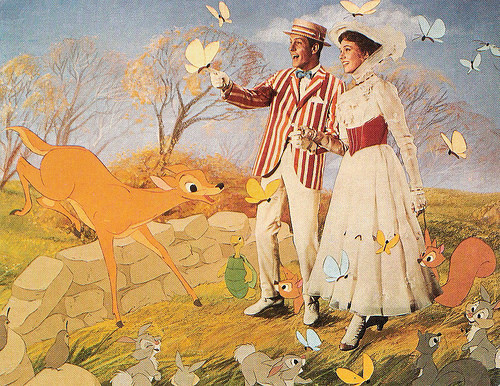
French postcard. Photo: Walt Disney Productions. Julie Andrews and Dick Van Dyke in Mary Poppins (Robert Stevenson, 1964).
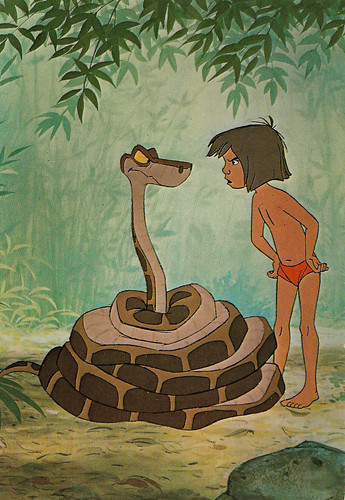
Belgian postcard by Edicorna. Image: Walt Disney Productions. Publicity still for The Jungle Book (Wolfgang Reitherman, 1967).
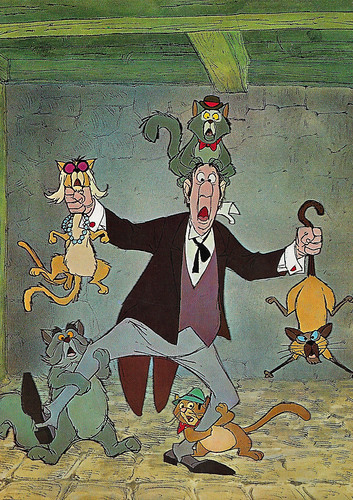
Italian postcard by Grafiche Biondetti, no. 117. Illustration: Walt Disney Productions. Publicity still for The AristoCats (Wolfgang Reitherman, 1970).
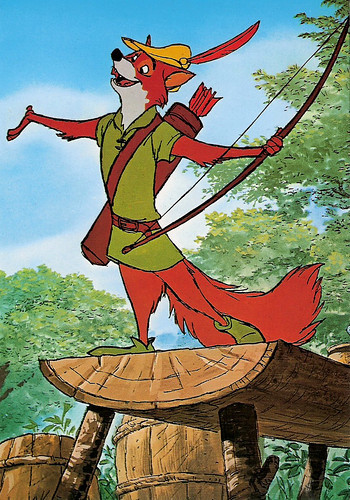
Italian postcard by Grafiche Biondetti S.R.L., Verona. Image: Disney. Publicity still for Robin Hood (Wolfgang Reitherman, 1973).
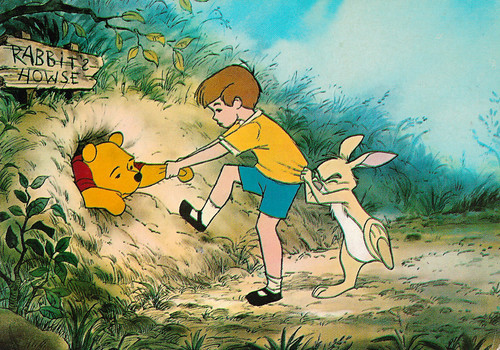
French postcard by Les Presses de Belleville, Paris. Image: Walt Disney Productions, 1965. Publicity still for the short film Winnie the Pooh and the Honey Tree (Wolfgang Reitherman, 1966), later incorporated in the feature The Many Adventures of Winnie the Pooh (John Lounsbery, Wolfgang Reitherman, 1977).
The Michael Eisner Era
The 1983 release of Mickey's Christmas Carol began a string of successful films, starting with Never Cry Wolf (Carroll Ballard, 1983) and the Ray Bradbury adaptation Something Wicked This Way Comes (Jack Clayton, 1983). In 1984, Disney CEO Ron Miller created Touchstone Films as a brand for Disney to release more major motion pictures. Touchstone's first release was the comedy Splash (Ron Howard. 1984), which was a box office success. In 1980, Disney launched Walt Disney Home Video to take advantage of the newly emerging videocassette market. In 1983, The Disney Channel debuted as a subscription-level channel on cable systems nationwide.
Despite the success of the Disney Channel and its new theme park creations, Walt Disney Productions was financially vulnerable. Its film library was valuable, but offered few current successes, and its leadership team was unable to keep up with other studios, particularly the works of Don Bluth, who defected from Disney in 1979. By the early 1980s, the parks were generating 70% of Disney's income.
With the Sid Bass family purchase of 18.7 percent of Disney, Bass and the board brought in Michael Eisner from Paramount as CEO and Frank Wells from Warner Bros. as president. Eisner emphasised Touchstone with Down and Out in Beverly Hills (Paul Mazursky, 1985) to start leading to increased output with Good Morning, Vietnam (Barry Levinson, 1987), Dead Poets Society (Peter Weir, 1989), Pretty Woman (Garry Marshall, 1990) and additional hits.
Beginning with Who Framed Roger Rabbit (Robert Zemeckis, 1988), Disney's flagship animation studio enjoyed a series of commercial and critical successes with such films as The Little Mermaid (Ron Clements, John Musker, 1989), Beauty and the Beast (Gary Trousdale, Kirk Wise, 1991), Aladdin (Ron Clements, John Musker, 1992) and The Lion King (Roger Allers, Rob Minkoff, 1994). Disney moved to first place in box office receipts by 1988 and had increased revenues by 20% every year. In 1989, Disney signed an agreement-in-principle to acquire The Jim Henson Company from its founder, Muppet creator Jim Henson.
Disney also broadened its adult offerings in film when then-Disney Studio Chairman Jeffrey Katzenberg acquired Miramax Films in 1993. Wells was killed in a helicopter crash in 1994. Shortly thereafter, Katzenberg resigned and formed DreamWorks SKG because Eisner would not appoint Katzenberg to Wells' now-available post (Katzenberg had also sued over the terms of his contract). Instead, Eisner recruited his friend Michael Ovitz, one of the founders of the Creative Artists Agency, to be President. Ovitz lasted only 14 months and left Disney in December 1996.
In 2003, Disney became the first studio to record over $3 billion in worldwide box office receipts. Eisner did not want the board to renominate Roy E. Disney, the son of Disney co-founder Roy O. Disney, as a board director citing his age of 72 as a required retirement age. Stanley Gold responded by resigning from the board and requesting the other board members oust Eisner. On 30 November 2003, Disney resigned from his positions as the company's vice chairman and chairman of Walt Disney Feature Animation, accusing Eisner of micromanagement, failures with the ABC television network, timidity in the theme park business, turning The Walt Disney Company into a "rapacious, soul-less" company, and refusing to establish a clear succession plan, as well as a string of box office film flops starting in the year 2000.
In 2005, Walt Disney's nephew, Roy E. Disney, returned to the company as a consultant and as non-voting director emeritus. Walt Disney Feature Animation released Chicken Little, the company's first film using 3D animation. Bob Iger replaced Eisner as CEO. In January 2006, it was announced that Disney would purchase Pixar. Former Executive Vice-President of Pixar, John Lasseter, became Chief Creative Officer of Walt Disney Animation Studios, its division Disneytoon Studios, and Pixar Animation Studios, as well as assuming the role of Principal Creative Advisor at Walt Disney Imagineering.
In February 2006, Disney acquired the rights to Oswald the Lucky Rabbit from NBC Universal (including the character's intellectual property and the 26 Oswald cartoons produced by Walt Disney) as part of an exchange of minor assets. In 2009, Disney acquired Marvel Entertainment. Director Emeritus Roy E. Disney died of stomach cancer that year.
In 2018, Disney announced that Lasseter would be leaving the company. Pete Docter and Jennifer Lee replaced him as chief creative officers of Pixar and Disney Animation, respectively. In 2018, Disneytoon Studios was shut down, resulting in the layoffs of 75 animators and staff. Disney acquired 21st Century Fox. The acquisition lead to the formation of a new company, which kept the Walt Disney Company name.
In August 2017, Disney announced that they would be starting its own streaming service, known as Disney+, to compete with the longtime industry monopoly Netflix. Disney+ is currently scheduled to begin service in late 2019, with many series announced that will be using its many successful franchises. Disney currently has a publishing deal with Netflix to stream its content, however, Disney has said that its contract will end in 2019 and they won't renew it. Disney films and franchises will only be available via the new Disney+ subscription. The service will have content from Disney, Walt Disney Animation Studios, Pixar, Marvel, Star Wars, and National Geographic.
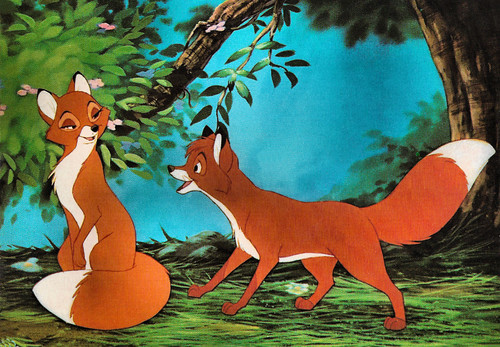
Italian postcard by Grafiche Biondetti, Verona. Photo: Walt Disney Productions. Photo: publicity still for The Fox and the Hound (Ted Berman, Richard Rich, Art Stevens, 1981).
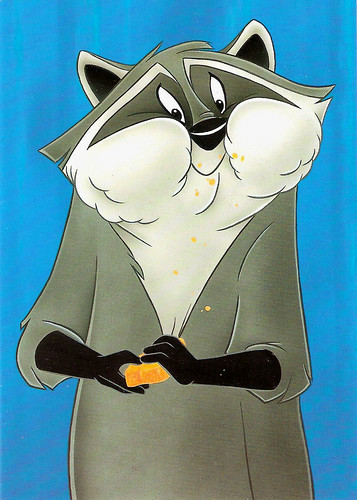
Dutch postcard by Interstat, Amsterdam. Image: Disney. Publicity still for Pocahontas (Mike Gabriel, Eric Goldberg, 1995).
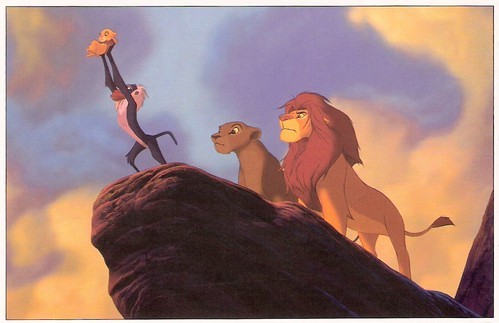
Dutch postcard by Donald Duck magazine. Image: Disney. Publicity still for The Lion King II: Simba's Pride (1998).
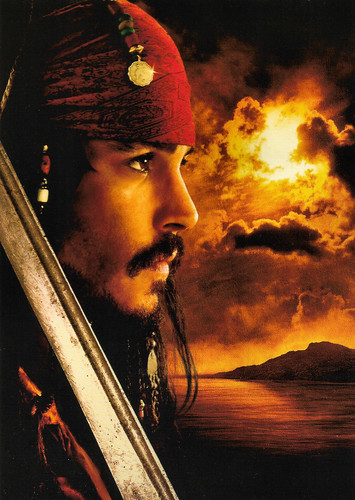
Danish postcard by Interstat. Photo: Disney. Johnny Depp as Jack Sparrow in Pirates of the Caribbean: Dead Man's Chest (Gore Verbinski, 2006).
Disney 50 movies / 50 filme | celebration trailer (2010) Walt Disney Animation Studios. Source: moviemaniacsDE (YouTube).
The next six days, EFSP presents six film specials with Disney animation classics!
Sources: Wikipedia and .

Vintage postcard. In 1932, Walt Disney received an honorary Academy Award for creating Mickey Mouse.

German postcard by Ross Verlag, no. 5227/1, 1930-1931. Image: Walt Disney. Collection: Marlene Pilaete.

British postcard in the Picturegoer series. Image: Walt Disney. Collection: Marlene Pilaete.
 >
>German postcard by Ross-Verlag, Berlin, no. 5174/2, 1930-1931. Photo: Harlip, Berlin. Mickey surrenders Europe and Olga Tschechova .

French postcard by Editions Superluxe, Paris, no. 14. Image: Walt Disney - Micky Mouse S.A.. Publicity still for Snow White and the Seven Dwarfs (William Cottrell, David Hand, Wilfred Jackson, Larry Morey, Perce Pearce, Ben Sharpsteen, 1937). Caption: To reward her little friends, Snow White serves them a tasty dinner.
A Mouse named Mortimer
In early 1923, animator Walt Disney created a short film entitled Alice's Wonderland, which featured child actress Virginia Davis interacting with animated characters. After the bankruptcy in 1923 of his previous firm, Laugh-O-Gram Studio, Disney moved to Hollywood to join his brother, Roy O. Disney. Film distributor Margaret J. Winkler of M.J. Winkler Productions contacted Disney with plans to distribute a whole series of Alice Comedies purchased for $1,500 per reel with Disney as a production partner.
Walt and Roy Disney formed Disney Brothers Cartoon Studio that same year. More animated films followed after Alice. In January 1926, with the completion of the Disney studio on Hyperion Street, the Disney Brothers Studio's name was changed to the Walt Disney Studio. Hundreds of Alice Comedies were produced between 1923 and 1927, before they lost popularity.
After the demise of the Alice Comedies, Disney developed an all-cartoon series starring his first original character, Oswald the Lucky Rabbit, which was distributed by Winkler Pictures through Universal Pictures. The distributor owned Oswald, so Disney only made a few hundred dollars.
From 1927 on, Disney completed 26 Oswald shorts before losing the contract in February 1928, due to a legal loophole, when Winkler's husband Charles Mintz took over their distribution company. After failing to take over the Disney Studio, Mintz hired away four of Disney's primary animators (the exception being Ub Iwerks) to start his own animation studio, Snappy Comedies.
In 1928, to recover from the loss of Oswald the Lucky Rabbit, Disney came up with the idea of a mouse character named Mortimer while on a train headed to California, drawing up a few simple drawings. The mouse was later renamed Mickey Mouse and starred in several Disney produced films. Ub Iwerks refined Disney's initial design of Mickey Mouse.
Disney's first sound film Steamboat Willie (Walt Disney, Ub Iwerks, 1928), a cartoon starring Mickey, was released in 1928 through Pat Powers' distribution company. It was the first Mickey Mouse sound cartoon released, but the third to be created, behind Plane Crazy (Walt Disney, Ub Iwerks, 1928), and The Gallopin' Gaucho (Walt Disney, Ub Iwerks, 1928).
Steamboat Willie, with Walt as the voice of Mickey, was an immediate smash hit, and its initial success was attributed not just to Mickey's appeal as a character, but to the fact that it was the first cartoon to feature synchronised sound. Disney's Plane Crazy and The Gallopin' Gaucho were then retrofitted with synchronised sound tracks and re-released successfully in 1929.
Disney continued to produce cartoons with Mickey Mouse and friends, including Minnie Mouse, Donald Duck, Goofy, Pluto, and plenty more. He began the Silly Symphony series, a cartoon series that didn't have a continuous character, with Columbia Pictures signing on as Symphonies distributor in August 1929. In September 1929, theatre manager Harry Woodin requested permission to start a Mickey Mouse Club which Walt approved. In November, test comics strips were sent to King Features, who requested additional samples to show to the publisher, William Randolph Hearst. On 30 December, King Features signed its first newspaper, New York Mirror, to publish the Mickey Mouse comic strip with Walt's permission.
In 1932, Disney signed an exclusive contract with Technicolor (through the end of 1935) to produce cartoons in colour. The first, Flowers and Trees (Burt Gillett, 1932), was also the first cartoon to win an Oscar. Another cartoon, Three Little Pigs (Burt Gillett, 1933), was so popular it was often billed above the feature films it accompanied. Disney released cartoons through Powers' Celebrity Pictures (1928–1930), Columbia Pictures (1930–1932), and United Artists (1932–1937). The popularity of the Mickey Mouse series allowed Disney to plan for his first feature-length animation. Criticasters called it "Disney's Folly".

French postcard in the series The Wonderful World of Walt Disney by Editions Kroma, Caissargues, no. 203. Image: Walt Disney Productions. Publicity still for Snow White and the Seven Dwarfs (William Cottrell, David Hand, Wilfred Jackson, Larry Morey, Perce Pearce, Ben Sharpsteen, 1937).

Dutch postcard by Rembrandt Uitg. Mij, Amsterdam. Image: Walt Disney. Publicity still for Pinocchio (Hamilton Luske, Ben Sharpsteen, a.o., 1940). Caption: "And Pinocchio danced on stage with the Dutch marionette girls..."

French postcard in the series The Wonderful World of Walt Disney by Editions Kroma, Caissargues, no. 6. Image: Walt Disney Productions. Publicity still for Fantasia (James Algar, Wilfred Jackson, Hamilton Luske, Ben Sharpsteen, a.o., 1940). Hyacinth Hippo and alligator dance partner in the segment Dance of the Hours.

French postcard by Editions Superluxe, Paris, no. 22. Sent by mail in 1953. Image: Walt Disney Productions. Publicity still for Dumbo (Ben Sharpsteen, a.o., 1941). Caption: This is the big jump, Dumbo will fly? Timothy lodged in his hat is worried.

Dutch postcard by Rembrandt Uitg. Mij. Amsterdam, circa 1949. Publicity still for Bambi (David Hand, 1942). Caption: Eat as many vegetables as you can, Thumper says to Bambi.
Pushing the boundaries of Animation
Walt Disney decided to push the boundaries of animation further. He began production of his first feature-length animated film in 1934. Taking three years to complete, Snow White and the Seven Dwarfs (William Cottrell, David Hand, Wilfred Jackson, Larry Morey, Perce Pearce, Ben Sharpsteen, 1937), premiered in December 1937 and by 1939 became the highest-grossing film of that time. Snow White was released through RKO Radio Pictures, which had assumed distribution of Disney's product in July 1937, after United Artists attempted to attain future television rights to the Disney shorts.
Using the profits from Snow White, Disney financed the construction of a new 51-acre (210,000 m2) studio complex in Burbank, California. The new Walt Disney Studios, in which the company is headquartered to this day, was completed and open for business by the end of 1939. The studio continued releasing animated shorts and features, such as Pinocchio (Hamilton Luske, Ben Sharpsteen, a.o., 1940), Fantasia (James Algar, Wilfred Jackson, Hamilton Luske, Ben Sharpsteen, a.o., 1940), Dumbo (Ben Sharpsteen, a.o., 1941), and Bambi (David Hand, 1942).
After World War II began, box office profits declined. When the United States entered the war after the attack on Pearl Harbor, many of Disney's animators were drafted into the armed forces. The U.S. and Canadian governments commissioned the studio to produce training and propaganda films. By 1942, 90% of its 550 employees were working on war-related films. Films such as the feature Victory Through Air Power (Perce Pearce, a.o., 1943) and the short Education for Death (Clyde Geronimi, 1943) were meant to increase public support for the war effort. Even the studio's characters joined the effort, as Donald Duck appeared in a number of comical propaganda shorts, including the Academy Award-winning Der Fuehrer's Face (Jack Kinney, 1943).
With limited staff and little operating capital during and after the war, Disney's feature films during much of the 1940s were 'package films', or collections of shorts, such as The Three Caballeros (Norman Ferguson, a.o., 1944) and Melody Time (Jack Kinney, Clyde Geronimi, Hamilton Luske, Wilfred Jackson, 1948), which performed poorly at the box office.
At the same time, the studio began producing live-action films and documentaries. Song of the South (Harve Foster, Wilfred Jackson, 1946) and So Dear to My Heart (Harold D. Schuster, Hamilton Luske, 1948) featured animated segments, while the True-Life Adventures series, which included such films as Seal Island (James Algar, 1948) and The Vanishing Prairie (James Algar, 1954), were also popular. Eight of the films in the series won Academy Awards.
The release of Cinderella (Clyde Geronimi, Hamilton Luske, Wilfred Jackson, 1950) proved that feature-length animation could still succeed in the marketplace. Other releases of the period included Alice in Wonderland (Clyde Geronimi, Wilfred Jackson, Hamilton Luske, 1951) and Peter Pan (Clyde Geronimi, Wilfred Jackson, Hamilton Luske, 1953), both in production before the war began, and Disney's first all-live action feature, Treasure Island (Byron Haskin, 1950). Disney ended its distribution contract with RKO in 1953, forming its own distribution arm, Buena Vista Distribution.
In December 1950, Walt Disney Productions and the Coca-Cola Company teamed up for Disney's first venture into television, the NBC television network special An Hour in Wonderland. In October 1954, the ABC network launched Disney's first regular television series.

Italian postcard by Grafiche Biondetti, Verona, no. 104. Picture: Walt Disney Productions. Publicity still for Cinderella (Clyde Geronimi, Wilfred Jackson, Hamilton Luske, 1950).

Italian postcard by Grafiche Biondetti S.R.L., Verona, no. 108/4. Image: Disney. Publicity still for Lady and the Tramp (Clyde Geronimi, Wilfred Jackson, Hamilton Luske, 1955).

French card by Jouets Masport, Chanas (Isère), no. 39/882. Photo: Walt Disney. Fess Parker and Buddy Ebsen in Davy Crockett - King of the Wild Frontier/Davy Crockett (Norman Foster, 1955).

French postcard by Editions Krõma, Paris in the Le monde merveuilleux de Walt Disney series. Illustration: Walt Disney Productions. Publicity still for One Hundred and One Dalmatians (Clyde Geronimi, Hamilton Luske, 1961).

Italian postcard by Grafiche Biondetti S.R.L., Verona, no. 116/1. Image: Disney. Publicity still for The Sword in the Stone (Wolfgang Reitherman, 1963).
Walt Disney's Magnum Opus
In 1954, Walt Disney used his Disneyland series to unveil what would become Disneyland, an idea conceived out of a desire for a place where parents and children could both have fun at the same time. In 1955, Disney opened Disneyland to the general public. After a shaky start, Disneyland continued to grow and attract visitors from across the country and around the world. In 1965, a second Disney theme park, Disney World', was announced, outside of Orlando, Florida.
Disney continued to focus its talents on television throughout the 1950s. Its weekday afternoon children's television program The Mickey Mouse Club (1955) was a great success, as was the Davy Crockett miniseries, starring Fess Parker and broadcast on the Disneyland anthology show. Two years later, Zorro (1957) would prove just as popular, running for two seasons on ABC.
Disney's film studios stayed busy as well, averaging five or six releases per year during this period. While the production of shorts slowed significantly during the 1950s and 1960s, the studio released a number of popular animated features, like Lady and the Tramp (Clyde Geronimi, Wilfred Jackson, Hamilton Luske, 1955), Sleeping Beauty (Clyde Geronimi, a.o., 1959) and One Hundred and One Dalmatians (Clyde Geronimi, Hamilton Luske, 1961), which introduced a new xerography process to transfer the drawings to animation cels.
Disney's live-action releases were spread across a number of genres, including the historical fiction film Johnny Tremain (Robert Stevenson, 1957), the children's book adaptation Pollyanna (David Swift, 1960) starring Hayley Mills , and the modern-day comedy The Shaggy Dog (Charles Barton, 1959), with Fred MacMurray.
Disney's most successful film of the 1960s was a musical adaptation of Mary Poppins (Robert Stevenson, 1964), which mixed live-action with animation. It is considered by many to be Walt Disney's magnum opus. Mary Poppins became one of the all-time highest-grossing films and received five Academy Awards, including Best Actress for Julie Andrews and Best Song for Robert B. Sherman & Richard M. Sherman for 'Chim Chim Cher-ee'.
In 1966, Walt Disney died of complications relating to lung cancer, and Roy Disney took over as chairman, CEO, and president of the company. One of his first acts was to rename Disney World as 'Walt Disney World' in honour of his brother and his vision. In 1967, the last two films Walt actively supervised were released, the animated feature The Jungle Book (Wolfgang Reitherman, 1967) and the musical The Happiest Millionaire (Norman Tokar, 1967).
The studio released a number of comedies in the late 1960s, including The Love Bug (Robert Stevenson, 1969), the year's highest-grossing film, and The Computer Wore Tennis Shoes (Robert Butler, 1969), which starred another young Disney discovery, Kurt Russell. The 1970s opened with the release of Disney's first 'post-Walt' animated feature, The AristoCats (Wolfgang Reitherman, 1970), followed by a return to fantasy musicals in Bedknobs and Broomsticks (Robert Stevenson, 1971) with Angela Lansbury .
In December 1971, Roy Disney died of a stroke. He left the company under control of Donn Tatum, Card Walker, and Walt's son-in-law Ron Miller, each trained by Walt and Roy. While Walt Disney Productions continued releasing family-friendly films throughout the 1970s, such as Escape to Witch Mountain (John Hough, 1975) and Freaky Friday (Gary Nielson, 1976) with Jodie Foster, the films did not fare as well at the box office as earlier material. However, the animation studio saw success with Robin Hood (Wolfgang Reitherman, 1973), The Rescuers (Wolfgang Reitherman, John Lounsbery, Art Stevens, 1977), and The Fox and the Hound (Ted Berman, Richard Rich, Art Stevens, 1981).
As head of the studio, Ron Miller attempted to make films to drive the profitable teenage market who generally passed on seeing Disney films. Inspired by the popularity of Star Wars (George Lucas, 1977), Disney produced the science-fiction adventure The Black Hole (Gary Nelson, 1979) that cost $20 million to make, but was lost in Star Wars' wake. Disney dabbled in the horror genre with The Watcher in the Woods (John Hough, Vincent McEveety, 1980) starring Bette Davis, and financed the boldly innovative Tron (Steven Lisberger, 1982) with Jeff Bridges, but both films were released to minimal success.

French postcard. Photo: Walt Disney Productions. Julie Andrews and Dick Van Dyke in Mary Poppins (Robert Stevenson, 1964).

Belgian postcard by Edicorna. Image: Walt Disney Productions. Publicity still for The Jungle Book (Wolfgang Reitherman, 1967).

Italian postcard by Grafiche Biondetti, no. 117. Illustration: Walt Disney Productions. Publicity still for The AristoCats (Wolfgang Reitherman, 1970).

Italian postcard by Grafiche Biondetti S.R.L., Verona. Image: Disney. Publicity still for Robin Hood (Wolfgang Reitherman, 1973).

French postcard by Les Presses de Belleville, Paris. Image: Walt Disney Productions, 1965. Publicity still for the short film Winnie the Pooh and the Honey Tree (Wolfgang Reitherman, 1966), later incorporated in the feature The Many Adventures of Winnie the Pooh (John Lounsbery, Wolfgang Reitherman, 1977).
The Michael Eisner Era
The 1983 release of Mickey's Christmas Carol began a string of successful films, starting with Never Cry Wolf (Carroll Ballard, 1983) and the Ray Bradbury adaptation Something Wicked This Way Comes (Jack Clayton, 1983). In 1984, Disney CEO Ron Miller created Touchstone Films as a brand for Disney to release more major motion pictures. Touchstone's first release was the comedy Splash (Ron Howard. 1984), which was a box office success. In 1980, Disney launched Walt Disney Home Video to take advantage of the newly emerging videocassette market. In 1983, The Disney Channel debuted as a subscription-level channel on cable systems nationwide.
Despite the success of the Disney Channel and its new theme park creations, Walt Disney Productions was financially vulnerable. Its film library was valuable, but offered few current successes, and its leadership team was unable to keep up with other studios, particularly the works of Don Bluth, who defected from Disney in 1979. By the early 1980s, the parks were generating 70% of Disney's income.
With the Sid Bass family purchase of 18.7 percent of Disney, Bass and the board brought in Michael Eisner from Paramount as CEO and Frank Wells from Warner Bros. as president. Eisner emphasised Touchstone with Down and Out in Beverly Hills (Paul Mazursky, 1985) to start leading to increased output with Good Morning, Vietnam (Barry Levinson, 1987), Dead Poets Society (Peter Weir, 1989), Pretty Woman (Garry Marshall, 1990) and additional hits.
Beginning with Who Framed Roger Rabbit (Robert Zemeckis, 1988), Disney's flagship animation studio enjoyed a series of commercial and critical successes with such films as The Little Mermaid (Ron Clements, John Musker, 1989), Beauty and the Beast (Gary Trousdale, Kirk Wise, 1991), Aladdin (Ron Clements, John Musker, 1992) and The Lion King (Roger Allers, Rob Minkoff, 1994). Disney moved to first place in box office receipts by 1988 and had increased revenues by 20% every year. In 1989, Disney signed an agreement-in-principle to acquire The Jim Henson Company from its founder, Muppet creator Jim Henson.
Disney also broadened its adult offerings in film when then-Disney Studio Chairman Jeffrey Katzenberg acquired Miramax Films in 1993. Wells was killed in a helicopter crash in 1994. Shortly thereafter, Katzenberg resigned and formed DreamWorks SKG because Eisner would not appoint Katzenberg to Wells' now-available post (Katzenberg had also sued over the terms of his contract). Instead, Eisner recruited his friend Michael Ovitz, one of the founders of the Creative Artists Agency, to be President. Ovitz lasted only 14 months and left Disney in December 1996.
In 2003, Disney became the first studio to record over $3 billion in worldwide box office receipts. Eisner did not want the board to renominate Roy E. Disney, the son of Disney co-founder Roy O. Disney, as a board director citing his age of 72 as a required retirement age. Stanley Gold responded by resigning from the board and requesting the other board members oust Eisner. On 30 November 2003, Disney resigned from his positions as the company's vice chairman and chairman of Walt Disney Feature Animation, accusing Eisner of micromanagement, failures with the ABC television network, timidity in the theme park business, turning The Walt Disney Company into a "rapacious, soul-less" company, and refusing to establish a clear succession plan, as well as a string of box office film flops starting in the year 2000.
In 2005, Walt Disney's nephew, Roy E. Disney, returned to the company as a consultant and as non-voting director emeritus. Walt Disney Feature Animation released Chicken Little, the company's first film using 3D animation. Bob Iger replaced Eisner as CEO. In January 2006, it was announced that Disney would purchase Pixar. Former Executive Vice-President of Pixar, John Lasseter, became Chief Creative Officer of Walt Disney Animation Studios, its division Disneytoon Studios, and Pixar Animation Studios, as well as assuming the role of Principal Creative Advisor at Walt Disney Imagineering.
In February 2006, Disney acquired the rights to Oswald the Lucky Rabbit from NBC Universal (including the character's intellectual property and the 26 Oswald cartoons produced by Walt Disney) as part of an exchange of minor assets. In 2009, Disney acquired Marvel Entertainment. Director Emeritus Roy E. Disney died of stomach cancer that year.
In 2018, Disney announced that Lasseter would be leaving the company. Pete Docter and Jennifer Lee replaced him as chief creative officers of Pixar and Disney Animation, respectively. In 2018, Disneytoon Studios was shut down, resulting in the layoffs of 75 animators and staff. Disney acquired 21st Century Fox. The acquisition lead to the formation of a new company, which kept the Walt Disney Company name.
In August 2017, Disney announced that they would be starting its own streaming service, known as Disney+, to compete with the longtime industry monopoly Netflix. Disney+ is currently scheduled to begin service in late 2019, with many series announced that will be using its many successful franchises. Disney currently has a publishing deal with Netflix to stream its content, however, Disney has said that its contract will end in 2019 and they won't renew it. Disney films and franchises will only be available via the new Disney+ subscription. The service will have content from Disney, Walt Disney Animation Studios, Pixar, Marvel, Star Wars, and National Geographic.

Italian postcard by Grafiche Biondetti, Verona. Photo: Walt Disney Productions. Photo: publicity still for The Fox and the Hound (Ted Berman, Richard Rich, Art Stevens, 1981).

Dutch postcard by Interstat, Amsterdam. Image: Disney. Publicity still for Pocahontas (Mike Gabriel, Eric Goldberg, 1995).

Dutch postcard by Donald Duck magazine. Image: Disney. Publicity still for The Lion King II: Simba's Pride (1998).

Danish postcard by Interstat. Photo: Disney. Johnny Depp as Jack Sparrow in Pirates of the Caribbean: Dead Man's Chest (Gore Verbinski, 2006).
Disney 50 movies / 50 filme | celebration trailer (2010) Walt Disney Animation Studios. Source: moviemaniacsDE (YouTube).
The next six days, EFSP presents six film specials with Disney animation classics!
Sources: Wikipedia and .
Published on June 14, 2019 22:00
June 13, 2019
Mary Pickford
Mary Pickford (1892-1979) was a legendary silent film actress and was known as 'America’s sweetheart.' She was a founder of United Artists and helped to establish the Academy.

German postcard by Ross Verlag, no. 838/1. Photo: Terra Film A.G., Berlin. Publicity still for Rosita (Ernst Lubitsch, 1923).

French postcard by Europe, no. 710. Photo: United Artists. Publicity still for Dorothy Vernon of Haddon Hall (Marshall Neilan, 1924).
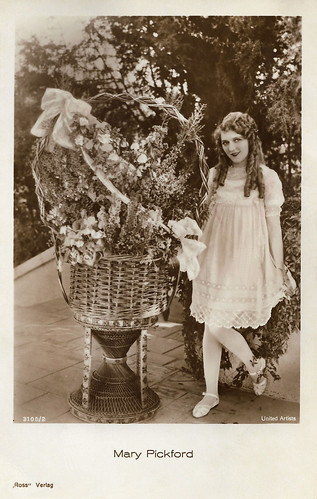
German postcard by Ross Verlag, no. 3100/2, 1928-1929. Photo: United Artists.

German postcard by Ross Verlag, no. 4778/1, 1929-1930. Photo: Ifa / United Artists. Publicity still for Coquette (Sam Taylor, 1929).
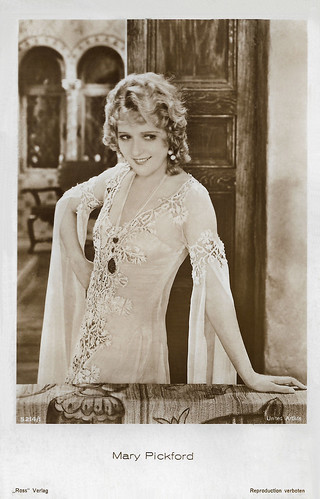
German postcard by Ross Verlag, no. 5214/1, 1930-1931. Photo: publicity still for The Taming of the Shrew (Sam Taylor, 1929).
The Girl with the Golden Curls
Mary Pickford was born Gladys Mary Smith in 1892, in Toronto, Canada. She was the sister of actor/director Jack Pickford and stage/screen actress Lottie Pickford.
Pickford began performing at the age of five on the stage and was known for a time as 'Baby Gladys.' After her father was killed in an accident, Gladys became the family’s main breadwinner by performing in the theatre. She was seven years old.
The stage became a family venture, as her younger siblings Lottie and Jack and even her mother took up the trade. After touring in different shows and productions for more than nine years, Gladys went to New York to conquer Broadway.
In 1907, she made her Broadway debut in The Warrens of Virginia, produced by the famous director-producer David Belasco. He insisted that Gladys Smith would assume the stage name Mary Pickford.
In 1909, when Pickford was between stage engagements, she approached David Wark Griffith, director and head of the Biograph Company (American Mutoscope & Biograph) in New York and asked him for work in moving pictures.
Pickford had no intention of working permanently in the new medium, but hoped the income would tide her over before she went back to Belasco and the stage. That same year, 'the girl with the curls' appeared in 40 films for Biograph (according to some sources even 51 films).
In January 1910, Griffith moved his operation to California, and Pickford went with him. Actors were not listed in the credits of the Biograph pictures. Audiences noticed and identified Pickford within weeks of her first film appearance.
Exhibitors in turn capitalised on her popularity by advertising on sandwich boards that a film featuring 'The Girl with the Golden Curls' or 'The Biograph Girl' was inside.
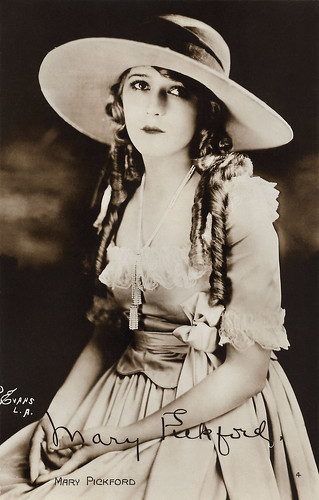
French postcard by Cinemagazine-Edition, no. 4 Photo: Evans L.A.
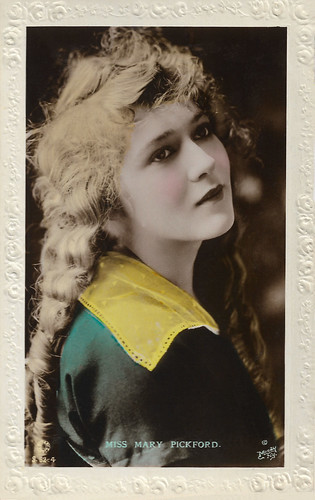
British postcard by Rotary Photo, London, no. S 62-4. Photo: Moody, N.Y. Caption: "This is a Real Photograph on Rajar Bromide Card."
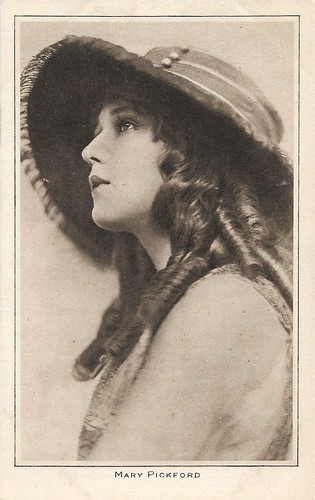
British postcard in the 'Pictures' Portrait Gallery, London.
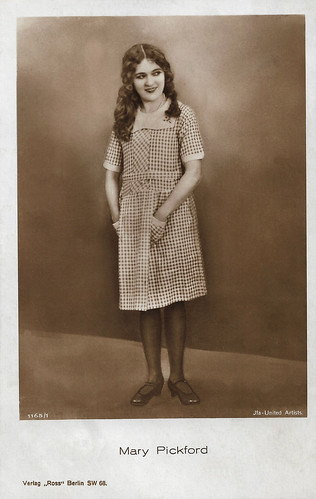
German postcard by Ross Verlag, no. 1165/1, 1927-1928. Photo: Ifa / United Artists.
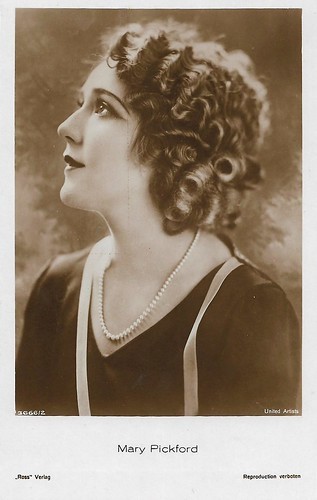
German postcard by Ross Verlag, no. 3666/2, 1928-1929. Photo: United Artists.
The Most Popular Actress in America, if not the World
Mary Pickford stayed with the Biograph Company, working as both an actress and writer from 1909 to 1911. She left Biograph in December 1910 for a brief stint at Carl Laemmle's Independent Moving Pictures Company (IMP). Unhappy with their creative standards, Pickford returned to work with Griffith. Some of her best performances were in his films, such as Friends (D.W. Griffith, 1912) with Henry B. Walthall, The Mender of Nets (D.W. Griffith, 1912) with Mabel Normand, and The Female of the Species (D.W. Griffith, 1912).
In 1913, after a run on Broadway in 'A Good Little Devil', Pickford made a definitive break from the stage by signing a film contract with Adolph Zukor who had formed one of the first American feature film companies: Famous Players in Famous Plays later known as Paramount Pictures.
Hearts Adrift (Edwin S. Porter, 1914) made her irresistible to filmgoers. With Harold Lockwood, she played a man and a woman who are shipwrecked on a desert island. It doesn't take long before they fall in love and, figuring that they would never see civilisation again, declare themselves married ... The film was so popular that Pickford asked for the first of her many publicised pay raises based on the profits and reviews. The film marked the first time Pickford’s name was featured above the title on cinema marquees.
Tess of the Storm Country (Edwin S. Porter, 1914) was released five weeks later. Mary played a fiery young woman fighting for the underclass. The film caused a sensation. Biographer Kevin Brownlow observed that the film "sent her career into orbit and made her the most popular actress in America, if not the world." Over the years, her fame grew as well as her salary. In 1916, Pickford had negotiated a contract that gave her a $10,000 a week salary, 50% of her film profits, and her own production company.
'Little Mary' became an international star, beloved for her beauty and charm. She often appeared on screen in young girl roles, even when she was an adult. Some of Mary Pickford’s greatest films were a collaborative effort with friend and writer-director Frances Marion. Together they worked on such hits as Rebecca of Sunnybrook Farm (Marshall Neilan, 1917) and Poor Little Rich Girl (Maurice Tourneur, 1917).
Christel Schmidt at Women Film Pioneers Project: "Pickford is often remembered for her portrayals of children in films including Rebecca of Sunnybrook Farm (1917) and Daddy-Long-Legs (1919). The stories were adapted from popular novels and had been performed on stage with an adult actress (Edith Taliaferro and Ruth Chatterton) playing the role of a young girl. Pickford’s petite size and youthful beauty made her ideal for these parts, but it was her acting talent that seared these roles into the public consciousness."
Mary Pickford also worked as a producer. In 1919, when she was only twenty-seven years old, Pickford cofounded United Artists, the first independent film distribution company along with D.W. Griffith, Charlie Chaplin , and Douglas Fairbanks, Sr., She had been married to actor Owen Moore since 1911, but in 1920, she divorced him to be with Fairbanks.

American postcard by California Postcard Company, Los Angeles. Pickfair. The "Doug (Douglas Fairbanks) and Mary" (Mary Pickford) Home, Beverly Hills, Los Angeles, California.
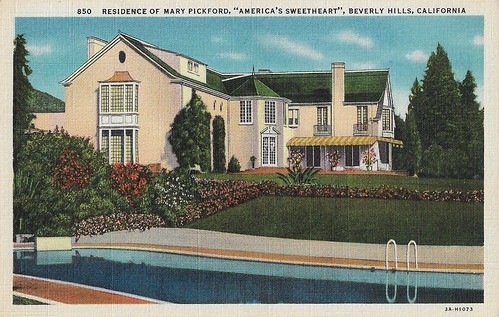
American postcard by Western Publishing & Novelty Co., Los Angeles, no. 850. Pickfair. Residence of Mary Pickford, "America's sweetheart" (and Douglas Fairbanks), Beverly Hills, California.
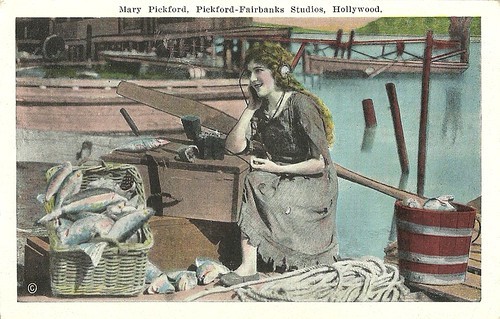
American postcard by California Postcard Co., Los Angeles. Photo: Glen G. Stone, Los Angeles. Mary Pickford in the title role of Tess of the Storm Country (John S. Robertson, 1922), on location, speaking by a radiophone with her studio at Hollywood, at thirty miles distant.
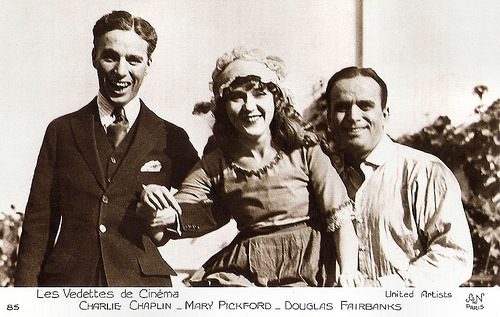
French postcard in the Les Vedettes de Cinéma series by A.N., Paris, no. 85. Photo: United Artists. Charlie Chaplin , Mary Pickford and Douglas Fairbanks, Sr ., the 'United Artists'.
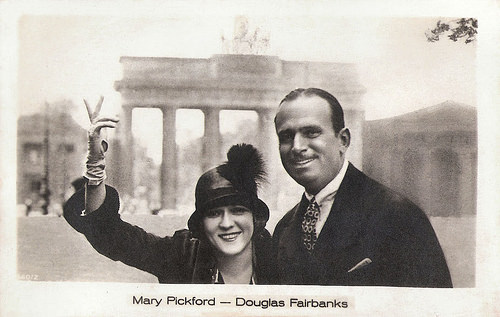
Vintage postcard, no. 960/2. Probably a vintage reprint of a Ross Verlag postcard. In 1926, Pickford and Douglas Fairbanks, Sr. visited Berlin and stayed at the Hotel Adlon near the Brandenburg Gate, which is in the background of this picture.
One of Hollywood’s Earliest Supercouples
Mary Pickford and Douglas Fairbanks, Sr married in 1920, becoming one of Hollywood’s earliest supercouples. Fans adored the pairing, and the couple was mobbed at every port on their whirlwind European honeymoon. The couple were known to host fabulous events at their home, called Pickfair, which were attended by many of the leading figures in film.
In the 1920s, Pickford continued to score more box-office hits with Polyanna (Paul Powell, 1920), Little Lord Fauntleroy (Alfred E. Green, Jack Pickford, 1921) with Claude Gillingwater, and a new version of Tess of the Storm Country (John S. Robertson, 1922).
German director Ernst Lubitsch came to America at Mary's invitation to direct Dorothy Vernon of Haddon Hall (1924), but when he arrived he had changed his mind and would not do it. The film was eventually directed by Marshall Neilan. Instead, Ernst Lubitsch and Mary Pickford made Rosita (1923) together.
Another hit was Little Annie Rooney (William Beaudine, 1925) with William Haines , and her last silent film, My Best Girl (Sam Taylor, 1927) with Charles 'Buddy' Rogers, would be one of the greatest of the era.
Mary Pickford was one of the original 36 founders of the Academy of Motion Picture Arts and Sciences in 1927. Around this time, the film industry was changing and talking pictures were on the rise. In 1929, Pickford starred in her first sound film, Coquette (Sam Taylor, 1929), which explored the dark side of a wealthy family. She won an Academy Award for her work on the film.
Still she was never quite able to recreate the phenomenal success she had in the silent pictures with the sound films. Her last film was Secrets (Frank Borzage, 1933) with Leslie Howard. Mary Pickford retired from the screen in 1933 but continued to produce.
Pickford, whose professional decline had begun in the same year as the death of her beloved mother, Gladys, in 1928, saw her brother and sister die in the 1930s. In 1936, her fairytale marriage to Fairbanks ended in divorce. Fairbanks died of heart failure only three years later.
In 1937, Pickford married actor and band leader Charles 'Buddy' Rogers, her costar in My Best Girl. They stayed together until her death and adopted two children. Mary Pickford died in 1979 in Santa Monica, California.
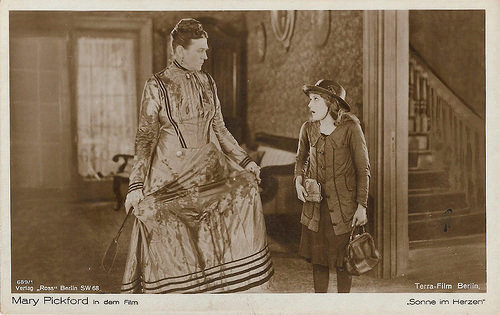
German postcard by Ross Verlag, no. 689/1, 1919-1924. Photo: Terra-Film, Berlin. Publicity still of Katherine Griffith and Mary Pickford in Pollyanna (Paul Powell, 1920), released in Germany as Sonne im Herzen (Sunshine in her Heart).
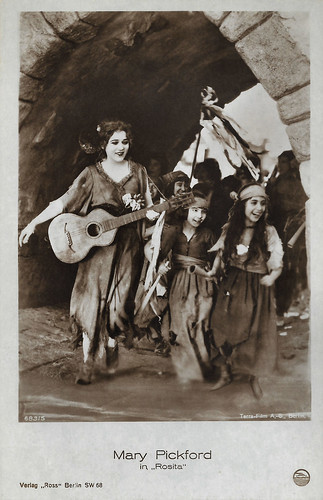
German postcard by Ross Verlag, no. 683/5. Photo: Terra Film A.G., Berlin. Publicity still for Rosita (Ernst Lubitsch, 1923).
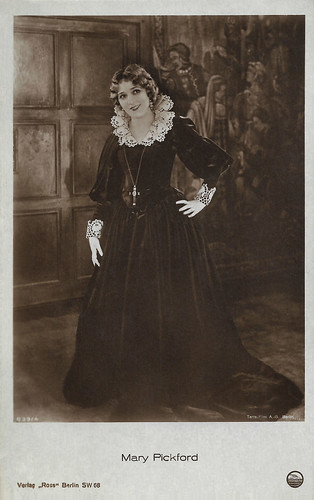
German postcard by Ross Verlag, no. 839/4. Photo: Terra Film A.G., Berlin. Publicity still for Dorothy Vernon of Haddon Hall (Marshall Neilan, 1924).

Austrian postcard by Iris Verlag, no. 906. Photo: United Artists / Projectograph-Film. Publicity still for Sparrows (William Beaudine, 1926).
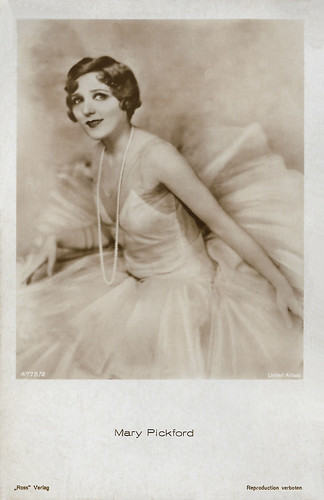
German postcard by Ross Verlag, no. 47784/2, 1929-1930. Photo: United Artists. Publicity still for Coquette (Sam Taylor, 1929).
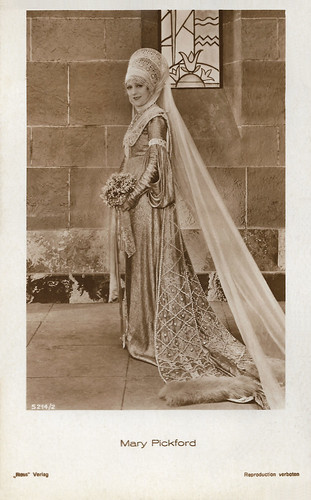
German postcard by Ross Verlag, no. 5214/2, 1930-1931. Photo: publicity still for Taming of the Shrew (Sam Taylor, 1929).
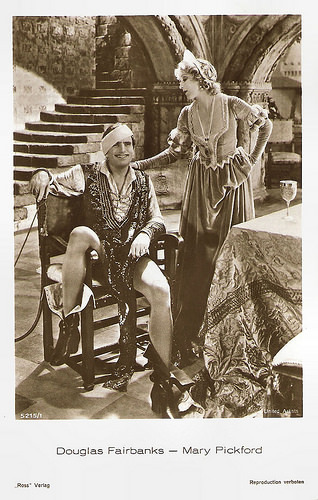
German postcard by Ross-Verlag, no. 5215/4 1930-1931. Photo: United Artists. Publicity still for The Taming of the Shrew (Sam Taylor, 1930) with Douglas Fairbanks Sr. .
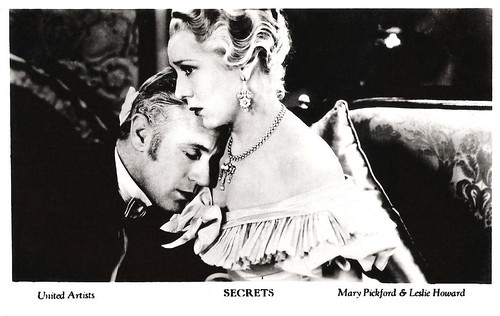
British postcard. Photo: United Artists. Publicity still for Secrets (Frank Borzage, 1933) with Leslie Howard .
Sources: Christel Schmidt (Women's Film Pioneer Project), Biography.com, Wikipedia and .

German postcard by Ross Verlag, no. 838/1. Photo: Terra Film A.G., Berlin. Publicity still for Rosita (Ernst Lubitsch, 1923).

French postcard by Europe, no. 710. Photo: United Artists. Publicity still for Dorothy Vernon of Haddon Hall (Marshall Neilan, 1924).

German postcard by Ross Verlag, no. 3100/2, 1928-1929. Photo: United Artists.

German postcard by Ross Verlag, no. 4778/1, 1929-1930. Photo: Ifa / United Artists. Publicity still for Coquette (Sam Taylor, 1929).

German postcard by Ross Verlag, no. 5214/1, 1930-1931. Photo: publicity still for The Taming of the Shrew (Sam Taylor, 1929).
The Girl with the Golden Curls
Mary Pickford was born Gladys Mary Smith in 1892, in Toronto, Canada. She was the sister of actor/director Jack Pickford and stage/screen actress Lottie Pickford.
Pickford began performing at the age of five on the stage and was known for a time as 'Baby Gladys.' After her father was killed in an accident, Gladys became the family’s main breadwinner by performing in the theatre. She was seven years old.
The stage became a family venture, as her younger siblings Lottie and Jack and even her mother took up the trade. After touring in different shows and productions for more than nine years, Gladys went to New York to conquer Broadway.
In 1907, she made her Broadway debut in The Warrens of Virginia, produced by the famous director-producer David Belasco. He insisted that Gladys Smith would assume the stage name Mary Pickford.
In 1909, when Pickford was between stage engagements, she approached David Wark Griffith, director and head of the Biograph Company (American Mutoscope & Biograph) in New York and asked him for work in moving pictures.
Pickford had no intention of working permanently in the new medium, but hoped the income would tide her over before she went back to Belasco and the stage. That same year, 'the girl with the curls' appeared in 40 films for Biograph (according to some sources even 51 films).
In January 1910, Griffith moved his operation to California, and Pickford went with him. Actors were not listed in the credits of the Biograph pictures. Audiences noticed and identified Pickford within weeks of her first film appearance.
Exhibitors in turn capitalised on her popularity by advertising on sandwich boards that a film featuring 'The Girl with the Golden Curls' or 'The Biograph Girl' was inside.

French postcard by Cinemagazine-Edition, no. 4 Photo: Evans L.A.

British postcard by Rotary Photo, London, no. S 62-4. Photo: Moody, N.Y. Caption: "This is a Real Photograph on Rajar Bromide Card."

British postcard in the 'Pictures' Portrait Gallery, London.

German postcard by Ross Verlag, no. 1165/1, 1927-1928. Photo: Ifa / United Artists.

German postcard by Ross Verlag, no. 3666/2, 1928-1929. Photo: United Artists.
The Most Popular Actress in America, if not the World
Mary Pickford stayed with the Biograph Company, working as both an actress and writer from 1909 to 1911. She left Biograph in December 1910 for a brief stint at Carl Laemmle's Independent Moving Pictures Company (IMP). Unhappy with their creative standards, Pickford returned to work with Griffith. Some of her best performances were in his films, such as Friends (D.W. Griffith, 1912) with Henry B. Walthall, The Mender of Nets (D.W. Griffith, 1912) with Mabel Normand, and The Female of the Species (D.W. Griffith, 1912).
In 1913, after a run on Broadway in 'A Good Little Devil', Pickford made a definitive break from the stage by signing a film contract with Adolph Zukor who had formed one of the first American feature film companies: Famous Players in Famous Plays later known as Paramount Pictures.
Hearts Adrift (Edwin S. Porter, 1914) made her irresistible to filmgoers. With Harold Lockwood, she played a man and a woman who are shipwrecked on a desert island. It doesn't take long before they fall in love and, figuring that they would never see civilisation again, declare themselves married ... The film was so popular that Pickford asked for the first of her many publicised pay raises based on the profits and reviews. The film marked the first time Pickford’s name was featured above the title on cinema marquees.
Tess of the Storm Country (Edwin S. Porter, 1914) was released five weeks later. Mary played a fiery young woman fighting for the underclass. The film caused a sensation. Biographer Kevin Brownlow observed that the film "sent her career into orbit and made her the most popular actress in America, if not the world." Over the years, her fame grew as well as her salary. In 1916, Pickford had negotiated a contract that gave her a $10,000 a week salary, 50% of her film profits, and her own production company.
'Little Mary' became an international star, beloved for her beauty and charm. She often appeared on screen in young girl roles, even when she was an adult. Some of Mary Pickford’s greatest films were a collaborative effort with friend and writer-director Frances Marion. Together they worked on such hits as Rebecca of Sunnybrook Farm (Marshall Neilan, 1917) and Poor Little Rich Girl (Maurice Tourneur, 1917).
Christel Schmidt at Women Film Pioneers Project: "Pickford is often remembered for her portrayals of children in films including Rebecca of Sunnybrook Farm (1917) and Daddy-Long-Legs (1919). The stories were adapted from popular novels and had been performed on stage with an adult actress (Edith Taliaferro and Ruth Chatterton) playing the role of a young girl. Pickford’s petite size and youthful beauty made her ideal for these parts, but it was her acting talent that seared these roles into the public consciousness."
Mary Pickford also worked as a producer. In 1919, when she was only twenty-seven years old, Pickford cofounded United Artists, the first independent film distribution company along with D.W. Griffith, Charlie Chaplin , and Douglas Fairbanks, Sr., She had been married to actor Owen Moore since 1911, but in 1920, she divorced him to be with Fairbanks.

American postcard by California Postcard Company, Los Angeles. Pickfair. The "Doug (Douglas Fairbanks) and Mary" (Mary Pickford) Home, Beverly Hills, Los Angeles, California.

American postcard by Western Publishing & Novelty Co., Los Angeles, no. 850. Pickfair. Residence of Mary Pickford, "America's sweetheart" (and Douglas Fairbanks), Beverly Hills, California.

American postcard by California Postcard Co., Los Angeles. Photo: Glen G. Stone, Los Angeles. Mary Pickford in the title role of Tess of the Storm Country (John S. Robertson, 1922), on location, speaking by a radiophone with her studio at Hollywood, at thirty miles distant.

French postcard in the Les Vedettes de Cinéma series by A.N., Paris, no. 85. Photo: United Artists. Charlie Chaplin , Mary Pickford and Douglas Fairbanks, Sr ., the 'United Artists'.

Vintage postcard, no. 960/2. Probably a vintage reprint of a Ross Verlag postcard. In 1926, Pickford and Douglas Fairbanks, Sr. visited Berlin and stayed at the Hotel Adlon near the Brandenburg Gate, which is in the background of this picture.
One of Hollywood’s Earliest Supercouples
Mary Pickford and Douglas Fairbanks, Sr married in 1920, becoming one of Hollywood’s earliest supercouples. Fans adored the pairing, and the couple was mobbed at every port on their whirlwind European honeymoon. The couple were known to host fabulous events at their home, called Pickfair, which were attended by many of the leading figures in film.
In the 1920s, Pickford continued to score more box-office hits with Polyanna (Paul Powell, 1920), Little Lord Fauntleroy (Alfred E. Green, Jack Pickford, 1921) with Claude Gillingwater, and a new version of Tess of the Storm Country (John S. Robertson, 1922).
German director Ernst Lubitsch came to America at Mary's invitation to direct Dorothy Vernon of Haddon Hall (1924), but when he arrived he had changed his mind and would not do it. The film was eventually directed by Marshall Neilan. Instead, Ernst Lubitsch and Mary Pickford made Rosita (1923) together.
Another hit was Little Annie Rooney (William Beaudine, 1925) with William Haines , and her last silent film, My Best Girl (Sam Taylor, 1927) with Charles 'Buddy' Rogers, would be one of the greatest of the era.
Mary Pickford was one of the original 36 founders of the Academy of Motion Picture Arts and Sciences in 1927. Around this time, the film industry was changing and talking pictures were on the rise. In 1929, Pickford starred in her first sound film, Coquette (Sam Taylor, 1929), which explored the dark side of a wealthy family. She won an Academy Award for her work on the film.
Still she was never quite able to recreate the phenomenal success she had in the silent pictures with the sound films. Her last film was Secrets (Frank Borzage, 1933) with Leslie Howard. Mary Pickford retired from the screen in 1933 but continued to produce.
Pickford, whose professional decline had begun in the same year as the death of her beloved mother, Gladys, in 1928, saw her brother and sister die in the 1930s. In 1936, her fairytale marriage to Fairbanks ended in divorce. Fairbanks died of heart failure only three years later.
In 1937, Pickford married actor and band leader Charles 'Buddy' Rogers, her costar in My Best Girl. They stayed together until her death and adopted two children. Mary Pickford died in 1979 in Santa Monica, California.

German postcard by Ross Verlag, no. 689/1, 1919-1924. Photo: Terra-Film, Berlin. Publicity still of Katherine Griffith and Mary Pickford in Pollyanna (Paul Powell, 1920), released in Germany as Sonne im Herzen (Sunshine in her Heart).

German postcard by Ross Verlag, no. 683/5. Photo: Terra Film A.G., Berlin. Publicity still for Rosita (Ernst Lubitsch, 1923).

German postcard by Ross Verlag, no. 839/4. Photo: Terra Film A.G., Berlin. Publicity still for Dorothy Vernon of Haddon Hall (Marshall Neilan, 1924).

Austrian postcard by Iris Verlag, no. 906. Photo: United Artists / Projectograph-Film. Publicity still for Sparrows (William Beaudine, 1926).

German postcard by Ross Verlag, no. 47784/2, 1929-1930. Photo: United Artists. Publicity still for Coquette (Sam Taylor, 1929).

German postcard by Ross Verlag, no. 5214/2, 1930-1931. Photo: publicity still for Taming of the Shrew (Sam Taylor, 1929).

German postcard by Ross-Verlag, no. 5215/4 1930-1931. Photo: United Artists. Publicity still for The Taming of the Shrew (Sam Taylor, 1930) with Douglas Fairbanks Sr. .

British postcard. Photo: United Artists. Publicity still for Secrets (Frank Borzage, 1933) with Leslie Howard .
Sources: Christel Schmidt (Women's Film Pioneer Project), Biography.com, Wikipedia and .
Published on June 13, 2019 22:00
June 12, 2019
La disfida di Barletta (1915)
In 1915, the Turinese company Pasquali Film produced an adaptation of the classic, nationalistic novel 'Ettore Fieramosca' by Massimo D'Azeglio. The film, La disfida di Barletta/The Challenge of Barletta (1915), was directed by Umberto Paradisi and with scenography by Domenico Gaido, according to film historian Vittorio Martinelli. IMDb claims Gaido was co-director with Paradisi. Acclaimed actors Gustavo Serena and Domenico Gambino had supporting parts in the film.
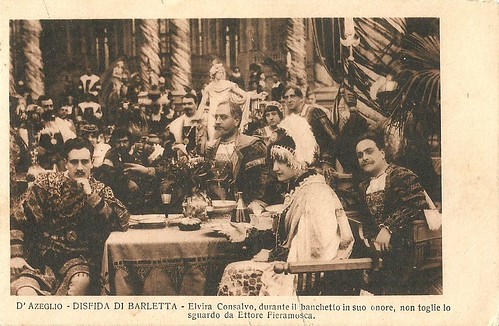
Italian postcard. Photo: Pasquali Film. Caption: During the banquet given in her honour, Elvira Consalvo cannot take her eyes from Ettore Fieramosca.
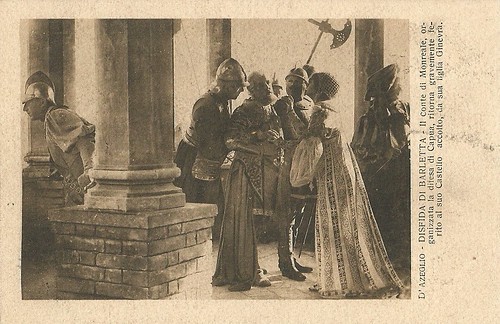
Italian postcard. Photo: Pasquali Film. Caption: The Count of Monreale, who had organised the defense of Capua, returns gravely wounded to his castle, welcomed by his daughter Ginevra.
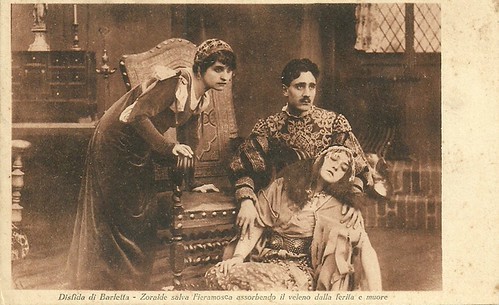
Italian postcard. Photo: Pasquali Film. Caption: Zoraide saves Fieramosca, sucking the venom of the wound and dies.
A farewell kiss which awakens her
La disfida di Barletta/Ettore Fieramosca (Umberto Paradisi, 1915) was based on a literary action epic by Massimo D'Azeglio. During the Risorgimento and the rise of Fascism, Ettore Fieramosca was presented as a national hero and became the subject of national celebrations. D'Azeglio wrote his novel in 1833 novel in an effort to boost Italian patriotism.
In 1938, during the Fascist era, Alessandro Blasetti directed a sound film Ettore Fieramosca. Two warships, the protected cruiser Ettore Fieramosca and the submarine Ettore Fieramosca, were named after him. Before that Fieramosca had been the subject of two Italian silent films by the Ambrosio company, Ettore Fieramosca (Ernesto Maria Pasquali, 1909) and La disfida di Barletta/Ettore Fieramosca (Umberto Paradisi, 1915).
In 1503, the French army is walking towards Rome. Ettore Fieramosca (Giovanni Cimara), engaged to Ginevra di Monreale (Laura Darville), is sent to Bari to organise the Resistance. But the invaders proceed and they capture the castle of Monreale.
The old count of Monreale offers his daughter in a marriage to Grajano d'Asti (Nello Carotenuto), a renegade who commands the French troops, if he frees them from the foreign soldiers. Among Grajano's friends is Valentino Borgia, who becomes hot for Ginevra and gives her a potion which creates an apparent death.
Yet when Ettore returns from Bari and hears from her death, he gives her a farewell kiss... and awakens her. The two of them flee, so when Borgia opens the coffin, it is empty. The French now move to Barletta, ruled by Ettore.
During a seize fire, a French captain, prisoner of war of the Italians, insults the honour of the fighting Italians. Ettore then proposes a challenge of 13 Italians against 13 French and their allies. During the fight the Italians win and Grajano dies.
Borgia makes Ginevra believe Ettore has another love, so she has a heart attack. When Ettore returns to her, he finds her dead by grief. He then saddles his horse, storms towards a rock and ends up in sea.
While produced in 1915, La disfida di Barletta/Ettore Fieramosca was released late, e.g. in 1917 in Turin. The critics wrote that the film should have been lauded before the war (the First World War), but now looked old style, for instance in its performances, despite the tasteful sets and shots on location.
Vittorio Martinelli suspects that this oudated reputation may have been enforced by the insertion of fragments from the 1909 version, which is now considered a lost film.
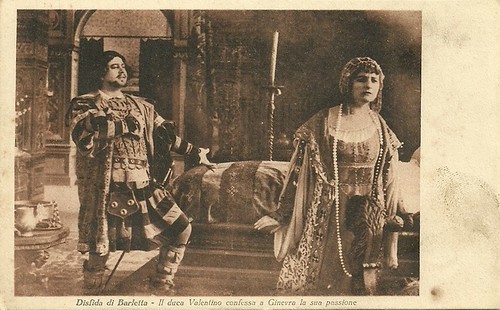
Italian postcard. Photo: Pasquali Film. Caption: Duke Valentino confessions his passion to Ginevra.
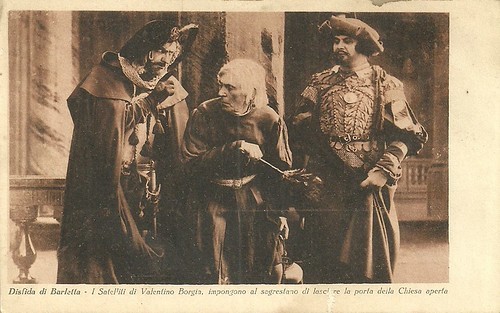
Italian postcard. Photo: Pasquali Film. Caption: Valentino Borgia's local cronies press the sacristan to leave the door of the church open.
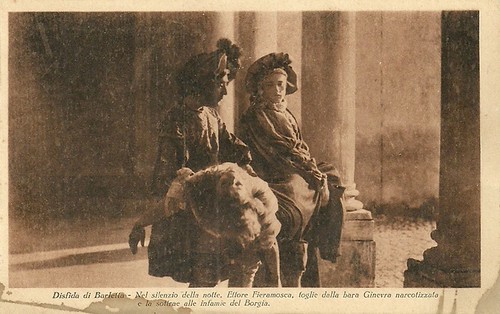
Italian postcard. Photo: Pasquali Film. Caption: In the still of the night, Ettore Fieramosca lifts the drugged Ginevra from the coffin and thus subtracts her from the infamous Borgia.
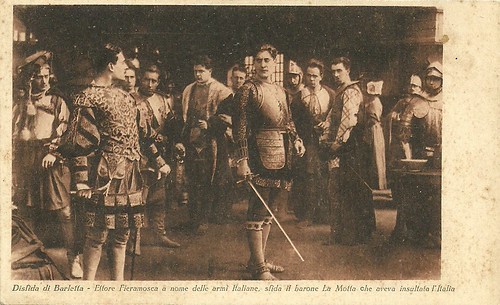
Italian postcard. Photo: Pasquali Film. Caption: In the name of the Italian armies, Ettore Fieramosca challenges Baron la Motta, who has insulted Italy.
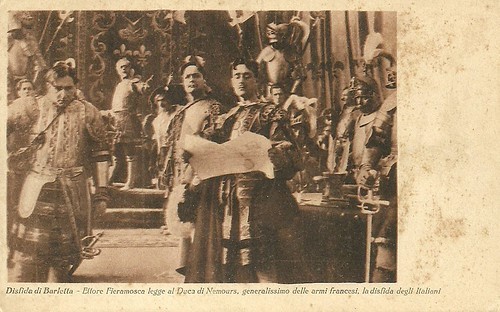
Italian postcard. Pasquali Film. Caption: Ettore Fieramosca reads to the Duke of Nemours, commander in chief of the French armies, the challenge by the Italians.
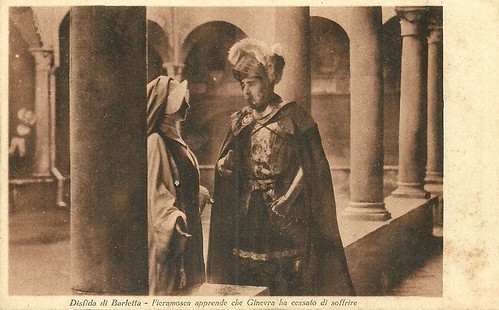
Italian postcard. Photo: Pasquali Film. Caption: Fieramosca hears that Ginevra has stopped suffering.
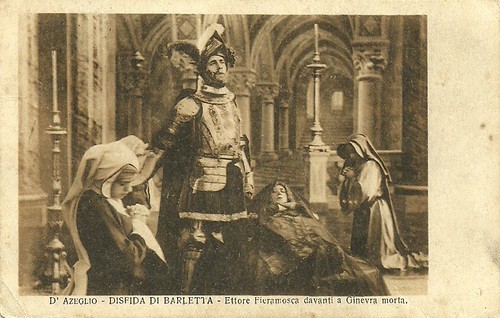
Italian postcard. Photo: Pasquali Film. Caption: Ettore Fieramosca before the dead Ginevra.
Source: Vittorio Martinelli (Il cinema muto italiano, 1915), Wikipedia and IMDb.

Italian postcard. Photo: Pasquali Film. Caption: During the banquet given in her honour, Elvira Consalvo cannot take her eyes from Ettore Fieramosca.

Italian postcard. Photo: Pasquali Film. Caption: The Count of Monreale, who had organised the defense of Capua, returns gravely wounded to his castle, welcomed by his daughter Ginevra.

Italian postcard. Photo: Pasquali Film. Caption: Zoraide saves Fieramosca, sucking the venom of the wound and dies.
A farewell kiss which awakens her
La disfida di Barletta/Ettore Fieramosca (Umberto Paradisi, 1915) was based on a literary action epic by Massimo D'Azeglio. During the Risorgimento and the rise of Fascism, Ettore Fieramosca was presented as a national hero and became the subject of national celebrations. D'Azeglio wrote his novel in 1833 novel in an effort to boost Italian patriotism.
In 1938, during the Fascist era, Alessandro Blasetti directed a sound film Ettore Fieramosca. Two warships, the protected cruiser Ettore Fieramosca and the submarine Ettore Fieramosca, were named after him. Before that Fieramosca had been the subject of two Italian silent films by the Ambrosio company, Ettore Fieramosca (Ernesto Maria Pasquali, 1909) and La disfida di Barletta/Ettore Fieramosca (Umberto Paradisi, 1915).
In 1503, the French army is walking towards Rome. Ettore Fieramosca (Giovanni Cimara), engaged to Ginevra di Monreale (Laura Darville), is sent to Bari to organise the Resistance. But the invaders proceed and they capture the castle of Monreale.
The old count of Monreale offers his daughter in a marriage to Grajano d'Asti (Nello Carotenuto), a renegade who commands the French troops, if he frees them from the foreign soldiers. Among Grajano's friends is Valentino Borgia, who becomes hot for Ginevra and gives her a potion which creates an apparent death.
Yet when Ettore returns from Bari and hears from her death, he gives her a farewell kiss... and awakens her. The two of them flee, so when Borgia opens the coffin, it is empty. The French now move to Barletta, ruled by Ettore.
During a seize fire, a French captain, prisoner of war of the Italians, insults the honour of the fighting Italians. Ettore then proposes a challenge of 13 Italians against 13 French and their allies. During the fight the Italians win and Grajano dies.
Borgia makes Ginevra believe Ettore has another love, so she has a heart attack. When Ettore returns to her, he finds her dead by grief. He then saddles his horse, storms towards a rock and ends up in sea.
While produced in 1915, La disfida di Barletta/Ettore Fieramosca was released late, e.g. in 1917 in Turin. The critics wrote that the film should have been lauded before the war (the First World War), but now looked old style, for instance in its performances, despite the tasteful sets and shots on location.
Vittorio Martinelli suspects that this oudated reputation may have been enforced by the insertion of fragments from the 1909 version, which is now considered a lost film.

Italian postcard. Photo: Pasquali Film. Caption: Duke Valentino confessions his passion to Ginevra.

Italian postcard. Photo: Pasquali Film. Caption: Valentino Borgia's local cronies press the sacristan to leave the door of the church open.

Italian postcard. Photo: Pasquali Film. Caption: In the still of the night, Ettore Fieramosca lifts the drugged Ginevra from the coffin and thus subtracts her from the infamous Borgia.

Italian postcard. Photo: Pasquali Film. Caption: In the name of the Italian armies, Ettore Fieramosca challenges Baron la Motta, who has insulted Italy.

Italian postcard. Pasquali Film. Caption: Ettore Fieramosca reads to the Duke of Nemours, commander in chief of the French armies, the challenge by the Italians.

Italian postcard. Photo: Pasquali Film. Caption: Fieramosca hears that Ginevra has stopped suffering.

Italian postcard. Photo: Pasquali Film. Caption: Ettore Fieramosca before the dead Ginevra.
Source: Vittorio Martinelli (Il cinema muto italiano, 1915), Wikipedia and IMDb.
Published on June 12, 2019 22:00
June 11, 2019
Der Sohn des Hannibal (1918)
Danish actor, director, scriptwriter and producer Viggo Larsen (1880-1957) was one of the pioneers of the Danish cinema. During the 1910s, he also worked in Germany for the Messter-Film studio. One of his German films is the comedy Der Sohn des Hannibal/The Son of Hannibal (1918) which he directed, produced and starred in.

German postcard by Rotophot in the Film Sterne series, no. 542/1. Photo: Messter-Film. Viggo Larsen in Der Sohn des Hannibal/The Son of Hannibal (Viggo Larsen, 1918).
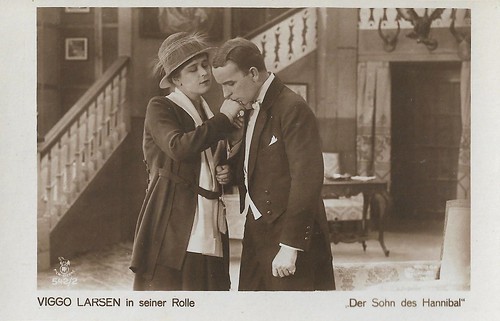
German postcard by Rotophot in the Film Sterne series, no. 542/2. Photo: Messter-Film. Viggo Larsen in Der Sohn des Hannibal/The Son of Hannibal (Viggo Larsen, 1918). The woman is Käthe Haack .
A racehorse called Imperator
The screenplay of Der Sohn des Hannibal/The Son of Hannibal (Viggo Larsen, 1918) was written by Karl Singer and Rudolf Strauß and based on a novel by Ludwig Wolff.
The title of the film does not refer to the historical figure but to a horse and the film is mainly situated at a Berlin racetrack.
Viggo Larsen plays an elegant racing team owner, Count Ferdinand Muntaniz, who buys a racehorse, a descendant of the stallion Hannibal, and calls it 'Imperator'. Immediately he bets with Count Szivarwany that the horse will win the first derby. Due to race shifts and game losses, Count Ferdinand is forced to resell Imperator but he has recovered his losses through the bet.
The German magazine Kinematographische Rundschau was enthusiastic about the results: "The brilliant acting of Viggo Larsen , who understands the role of an aristocrat as truly aristocratic and sympathetic, is among the best achievements of this popular artist. Even as his own director, he has created a framework that effectively highlights the moving action. (...) A good idea is associated with beautiful images, which is accompanied by success."
In 1926, the film was remade as Der Sohn des Hannibal (Felix Basch, 1926), a silent film with Liane Haid , Alphons Fryland , Ferdinand von Alten, Albert Paulig and Sig Arno .
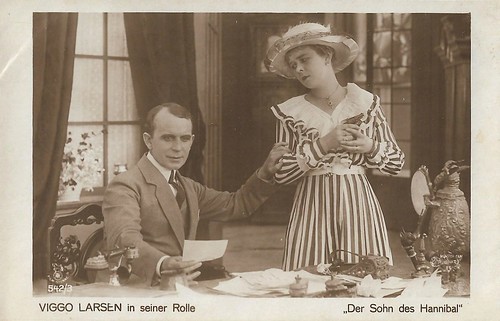
German postcard by Rotophot in the Film Sterne series, no. 542/3. Photo: Messter-Film. Viggo Larsen in Der Sohn des Hannibal/The Son of Hannibal (Viggo Larsen, 1918). The woman with the gun is Käthe Haack .
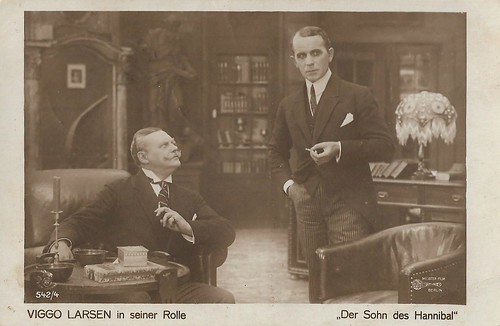
German postcard by Rotophot in the Film Sterne series, no. 542/4. Photo: Messter-Film. Viggo Larsen in Der Sohn des Hannibal/The Son of Hannibal (Viggo Larsen, 1918). The man on the left could be Franz Verdier.
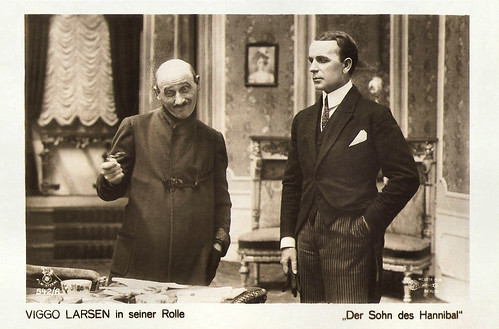
German postcard by Rotophot in the Film Sterne series, no. 542/6. Photo: Messter-Film. Viggo Larsen in Der Sohn des Hannibal/The Son of Hannibal (Viggo Larsen, 1918).
Sources: Wikipedia (German) and IMDb.

German postcard by Rotophot in the Film Sterne series, no. 542/1. Photo: Messter-Film. Viggo Larsen in Der Sohn des Hannibal/The Son of Hannibal (Viggo Larsen, 1918).

German postcard by Rotophot in the Film Sterne series, no. 542/2. Photo: Messter-Film. Viggo Larsen in Der Sohn des Hannibal/The Son of Hannibal (Viggo Larsen, 1918). The woman is Käthe Haack .
A racehorse called Imperator
The screenplay of Der Sohn des Hannibal/The Son of Hannibal (Viggo Larsen, 1918) was written by Karl Singer and Rudolf Strauß and based on a novel by Ludwig Wolff.
The title of the film does not refer to the historical figure but to a horse and the film is mainly situated at a Berlin racetrack.
Viggo Larsen plays an elegant racing team owner, Count Ferdinand Muntaniz, who buys a racehorse, a descendant of the stallion Hannibal, and calls it 'Imperator'. Immediately he bets with Count Szivarwany that the horse will win the first derby. Due to race shifts and game losses, Count Ferdinand is forced to resell Imperator but he has recovered his losses through the bet.
The German magazine Kinematographische Rundschau was enthusiastic about the results: "The brilliant acting of Viggo Larsen , who understands the role of an aristocrat as truly aristocratic and sympathetic, is among the best achievements of this popular artist. Even as his own director, he has created a framework that effectively highlights the moving action. (...) A good idea is associated with beautiful images, which is accompanied by success."
In 1926, the film was remade as Der Sohn des Hannibal (Felix Basch, 1926), a silent film with Liane Haid , Alphons Fryland , Ferdinand von Alten, Albert Paulig and Sig Arno .

German postcard by Rotophot in the Film Sterne series, no. 542/3. Photo: Messter-Film. Viggo Larsen in Der Sohn des Hannibal/The Son of Hannibal (Viggo Larsen, 1918). The woman with the gun is Käthe Haack .

German postcard by Rotophot in the Film Sterne series, no. 542/4. Photo: Messter-Film. Viggo Larsen in Der Sohn des Hannibal/The Son of Hannibal (Viggo Larsen, 1918). The man on the left could be Franz Verdier.

German postcard by Rotophot in the Film Sterne series, no. 542/6. Photo: Messter-Film. Viggo Larsen in Der Sohn des Hannibal/The Son of Hannibal (Viggo Larsen, 1918).
Sources: Wikipedia (German) and IMDb.
Published on June 11, 2019 22:00
June 10, 2019
Georges Melchior
Georges Melchior (1889-1944) was a French film actor, active in French cinema between 1911 and 1937. He was known for his roles in the Fantômas serials by Louis Feuillade (1913-1914), and the Jacques Feyder classic L'Atlantide (1921).
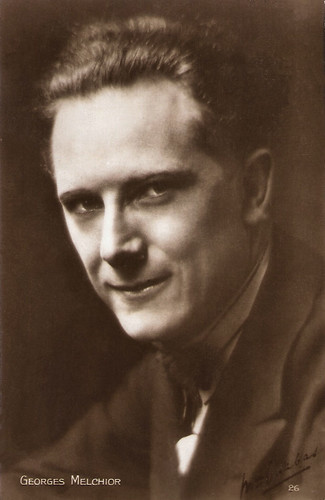
French postcard by Editions Cinémagazine, no. 26.
Fantômas
Georges Melchior was born in 1889 in Paris. He made his first film, L'Envieuse/The envious (Albert Capellani, 1910), at Pathé Frères, but quickly shifted to rival company Gaumont.
After several shorts at Gaumont, he had his breakthrough as the journalist Jérôme Fandor of the newspaper 'La Capitale' in Louis Feuillade's crime serial Fantômas - À l'ombre de la guillotine/Fantômas: In the Shadow of the Guillotine (1913), with René Navarre as the title character and criminal mastermind. Its success inspired the sequels Juve contre Fantomas/Juve versus Fantômas (Louis Feuillade, 1913), La Mort qui tue/Fantômas: The Dead Man Who Killed (Louis Feuillade, 1913), Fantômas contre Fantômas/Fantomas Against Fantomas (Louis Feuillade, 1914), and Le Faux Magistrat/Fantômas: The False Magistrate (Louis Feuillade, 1914), in which Melchior all played.
Parallel to this, Melchior acted in several modern realist dramas, historical films, and comedies at Gaumont, often directed by Feuillade but also by René Le Somptier and Henri Fescourt. During the First World War, Melchior's film career slowed down to a handful of films, including the French propaganda film Mères françaises/Mothers of France (René Hervil, Louis Mercanton, 1917) starring Sarah Bernhardt . After that, he was away from the film sets for several years.
In 1921, Melchior returned with a bang in Jacques Feyder's Orientalist mystery drama L'Atlantide/Lost Atlantis (1921), set and partly filmed in North Africa, and starring Jean Angelo and Stacia Napierkowska . Melchior played lieutenant Saint-Avit, who, pushed by vengeful, fatal desert queen Antinea (Napierkowska) kills his rival in love and army buddy captain Morhange (Angelo), who has rejected Antinea. Helped with Antinea's servant Tanit-Zerga (Marie-Louise Iribe), Saint-Avit flees and is found in the desert by soldiers, but he cannot forget Antinea. So years later, he returns to his desert queen.
The success of L'Atlantide guaranteed Melchior a fruitful career in French silent cinema of the 1920s. His films of the 1920s include e.g. Les Roquevillard/The Roquevillards (Julien Duvivier, 1922) with Maxime Desjardins , and Les Hommes nouveaux/The New Men (Émile-Bernard Donatien, Édouard-Émile Violet, 1922-1923), starring Donatien and Lucienne Legrand.

French postcard in the Les Vedettes du Cinéma series by Editions Filma, no. 24.
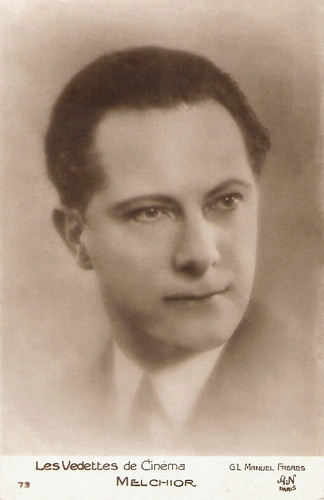
French postcard in the Les Vedettes de Cinéma series by A.N., Paris, no. 73. Photo: G.L. Manuel Frères.
Sarah Bernhardt
Georges Melchior played the male lead opposite Sarah Bernhardt in La Voyante/The Clairvoyant (Leon Abrams, 1924). During the production of the film, Sarah Bernhardt died in 1923. The actress Jeanne Brindeau replaced her as double, which much delayed the release of the film. The story deals with the son of a politician (Melchior), thrown out of the house by his father ( Harry Baur ), who suspects him of having an affair with his mother-in-law ( Mary Marquet ). He is rescued by a painter and hosted in a house that is also inhabited by an old medium (Bernhardt). In the end, all ends well and the son marries the medium's daughter ( Lily Damita ). The film was scripted by Sacha Guitry , had costumes by Paul Poiret, and was partly shot at Bernhardt's own home, but unfortunately, the film is considered lost.
In the early 1920s, Melchior often acted in films by Gaston Roudès such as Le Lac d'argent/The silver lake (1922), Le Petit Moineau de Paris/The Little Sparrow of Paris (1923) and Les Rantzeau/The Rantzaus (1923) with France Dhélia and Maurice Schutz . Melchior and Roudès later also worked together on Le Dédale/The maze (Marcel Dumont, Gaston Roudès, 1926) with Claude France , and La Maison au soleil/House in the Sun (Gaston Roudès, 1928) with Gaston Jacquet . In the later 1920s, Melchior often acted in films by Donatien , including Mon curé chez les riches/My priest among the rich (Donatien, 1925), Au revoir...et merci/Good bye and thank you (Pierre Colombier, Donatien, 1926), and Florine, la fleur du Valois/Florine, the flower of Valois (Donatien, 1926).
Melchior also worked with René Le Somptier, his former director at Gaumont, on the Belgian film La Forêt qui tue/The forest that kills (1926) and the serial Le P'tit Parigot/The Small Parisian One (1926). In La Sirène des Tropiques/Siren of the Tropics (Henri Etievant, Mario Nalpas, 1927), Melchior is a marquis who tries to prevent the marriage between his nephew ( Pierre Batcheff ) and his goddaughter (Régina Thomas) - as he eyes her himself. He sends his nephew off to the Antilles, where he hopes an evil aid will kill him, but a young local ( Josephine Baker ) saves him.
Melchior seems to have quite easily made the passage to sound cinema, as he appeared in nine films between 1930 and 1933. His first sound film probably was Les saltimbanques/The Mountebanks (Robert Land, Lucien Jaquelux, 1930), a Franco-German musical comedy with Käthe von Nagy , Nicolas Koline and Max Hansen . By now, Melchior played supporting parts as the older man, such as the rich father of Harry Krimer in Les vagabonds magnifiques/The beautiful vagabonds (Gennaro Dini, 1931), also starring Nadia Sibirskaïa; and the colonel in the comedy Le billet de logement/The accommodation ticket (Charles-Félix Tavano, 1932).
Gradually, his parts became smaller and smaller, though he still was billed on posters such as that for Le grand bluff/The Big Bluff (Maurice Champreux, 1933), starring José Noguero and Florelle . He also had a major part in La Vierge du rocher/The virgin of the rock (Georges Pallu, 1933), about a young boy who starts walking again because of the Virgin of Lourdes. After a gap of years, Melchior had a last supporting part in the period piece La citadelle du silence/The Citadel of Silence (Marcel L'Herbier, 1937), starring Annabella , but his name was not on the film posters anymore.
Georges Melchior died in 1944 at Levallois-Perret, Hauts-de-Seine. He was 54. All in all, he had acted in some 67 films.
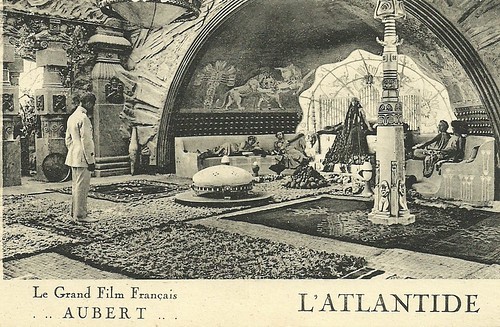
French postcard for the Louis Aubert production L'Atlantide (1921) by Jacques Feyder, based on the novel by Pierre Benoit. The card depicts the French captain Morhange ( Jean Angelo ) received by the mysterious and cruel desert queen Antinéa ( Stacia Napierkowska ). The sets were by Manuel Orazi.
Sources: dvdtoile.com, Wikipedia (French) and .

French postcard by Editions Cinémagazine, no. 26.
Fantômas
Georges Melchior was born in 1889 in Paris. He made his first film, L'Envieuse/The envious (Albert Capellani, 1910), at Pathé Frères, but quickly shifted to rival company Gaumont.
After several shorts at Gaumont, he had his breakthrough as the journalist Jérôme Fandor of the newspaper 'La Capitale' in Louis Feuillade's crime serial Fantômas - À l'ombre de la guillotine/Fantômas: In the Shadow of the Guillotine (1913), with René Navarre as the title character and criminal mastermind. Its success inspired the sequels Juve contre Fantomas/Juve versus Fantômas (Louis Feuillade, 1913), La Mort qui tue/Fantômas: The Dead Man Who Killed (Louis Feuillade, 1913), Fantômas contre Fantômas/Fantomas Against Fantomas (Louis Feuillade, 1914), and Le Faux Magistrat/Fantômas: The False Magistrate (Louis Feuillade, 1914), in which Melchior all played.
Parallel to this, Melchior acted in several modern realist dramas, historical films, and comedies at Gaumont, often directed by Feuillade but also by René Le Somptier and Henri Fescourt. During the First World War, Melchior's film career slowed down to a handful of films, including the French propaganda film Mères françaises/Mothers of France (René Hervil, Louis Mercanton, 1917) starring Sarah Bernhardt . After that, he was away from the film sets for several years.
In 1921, Melchior returned with a bang in Jacques Feyder's Orientalist mystery drama L'Atlantide/Lost Atlantis (1921), set and partly filmed in North Africa, and starring Jean Angelo and Stacia Napierkowska . Melchior played lieutenant Saint-Avit, who, pushed by vengeful, fatal desert queen Antinea (Napierkowska) kills his rival in love and army buddy captain Morhange (Angelo), who has rejected Antinea. Helped with Antinea's servant Tanit-Zerga (Marie-Louise Iribe), Saint-Avit flees and is found in the desert by soldiers, but he cannot forget Antinea. So years later, he returns to his desert queen.
The success of L'Atlantide guaranteed Melchior a fruitful career in French silent cinema of the 1920s. His films of the 1920s include e.g. Les Roquevillard/The Roquevillards (Julien Duvivier, 1922) with Maxime Desjardins , and Les Hommes nouveaux/The New Men (Émile-Bernard Donatien, Édouard-Émile Violet, 1922-1923), starring Donatien and Lucienne Legrand.

French postcard in the Les Vedettes du Cinéma series by Editions Filma, no. 24.

French postcard in the Les Vedettes de Cinéma series by A.N., Paris, no. 73. Photo: G.L. Manuel Frères.
Sarah Bernhardt
Georges Melchior played the male lead opposite Sarah Bernhardt in La Voyante/The Clairvoyant (Leon Abrams, 1924). During the production of the film, Sarah Bernhardt died in 1923. The actress Jeanne Brindeau replaced her as double, which much delayed the release of the film. The story deals with the son of a politician (Melchior), thrown out of the house by his father ( Harry Baur ), who suspects him of having an affair with his mother-in-law ( Mary Marquet ). He is rescued by a painter and hosted in a house that is also inhabited by an old medium (Bernhardt). In the end, all ends well and the son marries the medium's daughter ( Lily Damita ). The film was scripted by Sacha Guitry , had costumes by Paul Poiret, and was partly shot at Bernhardt's own home, but unfortunately, the film is considered lost.
In the early 1920s, Melchior often acted in films by Gaston Roudès such as Le Lac d'argent/The silver lake (1922), Le Petit Moineau de Paris/The Little Sparrow of Paris (1923) and Les Rantzeau/The Rantzaus (1923) with France Dhélia and Maurice Schutz . Melchior and Roudès later also worked together on Le Dédale/The maze (Marcel Dumont, Gaston Roudès, 1926) with Claude France , and La Maison au soleil/House in the Sun (Gaston Roudès, 1928) with Gaston Jacquet . In the later 1920s, Melchior often acted in films by Donatien , including Mon curé chez les riches/My priest among the rich (Donatien, 1925), Au revoir...et merci/Good bye and thank you (Pierre Colombier, Donatien, 1926), and Florine, la fleur du Valois/Florine, the flower of Valois (Donatien, 1926).
Melchior also worked with René Le Somptier, his former director at Gaumont, on the Belgian film La Forêt qui tue/The forest that kills (1926) and the serial Le P'tit Parigot/The Small Parisian One (1926). In La Sirène des Tropiques/Siren of the Tropics (Henri Etievant, Mario Nalpas, 1927), Melchior is a marquis who tries to prevent the marriage between his nephew ( Pierre Batcheff ) and his goddaughter (Régina Thomas) - as he eyes her himself. He sends his nephew off to the Antilles, where he hopes an evil aid will kill him, but a young local ( Josephine Baker ) saves him.
Melchior seems to have quite easily made the passage to sound cinema, as he appeared in nine films between 1930 and 1933. His first sound film probably was Les saltimbanques/The Mountebanks (Robert Land, Lucien Jaquelux, 1930), a Franco-German musical comedy with Käthe von Nagy , Nicolas Koline and Max Hansen . By now, Melchior played supporting parts as the older man, such as the rich father of Harry Krimer in Les vagabonds magnifiques/The beautiful vagabonds (Gennaro Dini, 1931), also starring Nadia Sibirskaïa; and the colonel in the comedy Le billet de logement/The accommodation ticket (Charles-Félix Tavano, 1932).
Gradually, his parts became smaller and smaller, though he still was billed on posters such as that for Le grand bluff/The Big Bluff (Maurice Champreux, 1933), starring José Noguero and Florelle . He also had a major part in La Vierge du rocher/The virgin of the rock (Georges Pallu, 1933), about a young boy who starts walking again because of the Virgin of Lourdes. After a gap of years, Melchior had a last supporting part in the period piece La citadelle du silence/The Citadel of Silence (Marcel L'Herbier, 1937), starring Annabella , but his name was not on the film posters anymore.
Georges Melchior died in 1944 at Levallois-Perret, Hauts-de-Seine. He was 54. All in all, he had acted in some 67 films.

French postcard for the Louis Aubert production L'Atlantide (1921) by Jacques Feyder, based on the novel by Pierre Benoit. The card depicts the French captain Morhange ( Jean Angelo ) received by the mysterious and cruel desert queen Antinéa ( Stacia Napierkowska ). The sets were by Manuel Orazi.
Sources: dvdtoile.com, Wikipedia (French) and .
Published on June 10, 2019 22:00
June 9, 2019
Photo by Republic Pictures
Republic Pictures was an American film production-distribution corporation that operated from 1935 to 1967. The studio was best known for its Westerns, serials and B films emphasising mystery and action. Republic was also developed the careers of John Wayne, Gene Autry and Roy Rogers. It also financed and distributed several John Ford-directed films during the 1940s and early 1950s and one Shakespeare film, Macbeth (1948), directed by Orson Welles. Under the cigar-chomping Herbert J. Yates, Republic was considered a mini-major film studio.
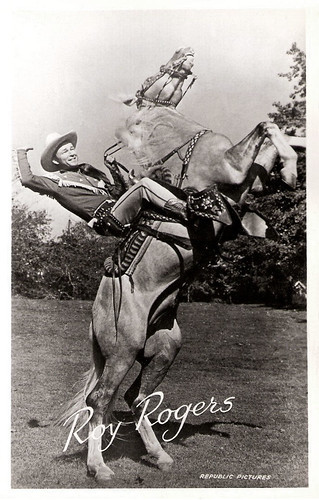
Dutch postcard. Photo: Republic Pictures.
American singer and cowboy actor Roy Rogers (1911–1998) was one of the most popular Western stars of his era. Known as the 'King of the Cowboys', he appeared in over 100 films.
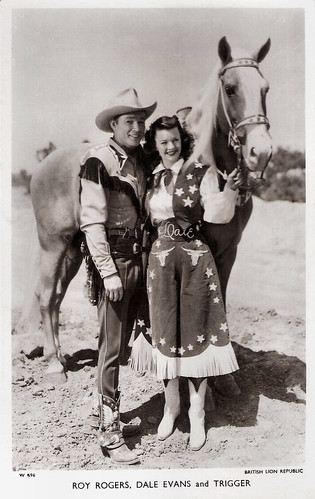
British postcard in the Picturegoer Series, London, no. W. 596. Photo: British Lion Republic. Roy Rogers, Dale Evans and Trigger.
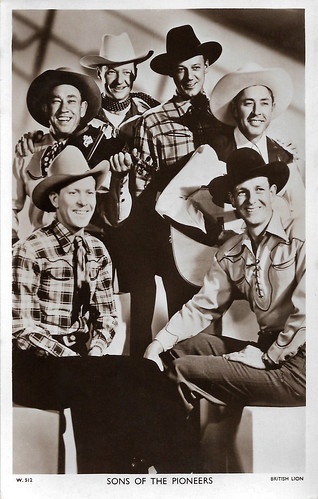
British postcard in the Picturegoer Series, London, no. W. 512. Photo: British Lion.
The Sons of the Pioneers are one of the United States' earliest Western singing groups. Known for their vocal performances, their musicianship, and their songwriting, they produced innovative recordings that have inspired many Western music performers and remained popular through the years. Since 1933, through many changes in membership, the Sons of the Pioneers have remained one of the longest-surviving country music vocal groups. Between 1935 and 1984, the Sons of the Pioneers appeared in 87 films.
A studio merger on Poverty Row
In 1935, Republic was created by Herbert J. Yates (1880-1966), a long time investor in film and owner of the film processing laboratory Consolidated Film Industries. Yates had discreetly helped finance Darryl F. Zanuck 's Twentieth Century Pictures in 1933. Zanuck's new studio would become a major customer of Yates' Consolidated Film Industries. Republic was initially formed by Yates' acquisition of six smaller independent studios along Gower Gulch, a section of Gower Street in Hollywood, also called 'Poverty Row'.
In the depths of the Great Depression, Yates' laboratory was no longer servicing the major studios, which had developed their own in-house laboratories for purposes of both economy and control, while the small, independent producers were going under in the face of Depression-born increased competition from the majors combined with the general impact of the depressed economy.
Yates thus decided to create a studio of his own to insure Consolidated's stability. Six surviving small companies (Monogram Pictures, Mascot Pictures, Liberty Pictures, Majestic Pictures, Chesterfield Pictures and Invincible Pictures) were all in debt to his lab. He prevailed upon these studios to merge under his leadership or else face foreclosure on their outstanding lab bills. Yates' new company, Republic Pictures Corporation, was presented to their producer-owners as a collaborative enterprise focused on low-budget product.
The largest of Republic's components was Monogram Pictures, run by producers Trem Carr and W. Ray Johnston, which specialised in B films and operated a nationwide distribution system. The most technologically advanced of the studios that now comprised Republic was Nat Levine's Mascot Pictures Corporation, which had been making serials almost exclusively since the mid-1920s and had a first-class production facility, the former Mack Sennett-Keystone lot in Studio City. Mascot also had just discovered Gene Autry and signed him to a contract as a singing cowboy star.
Larry Darmour's Majestic Pictures had developed an exhibitor following with big-name stars and rented sets giving his humble productions a polished look. Republic took its original Liberty Bell logo from M.H. Hoffman's Liberty Pictures as well as Hoffman's talents as a low-budget film producer. Chesterfield Pictures and Invincible Pictures, two sister companies under the same ownership, were skilled in producing low-budget melodramas and mysteries.
Acquiring and integrating these six companies enabled Republic to begin life with an experienced production staff, a company of veteran B-film supporting players and at least one very promising star, a complete distribution system and a functioning and modern studio. In exchange for merging, the principals were promised independence in their productions under the Republic aegis, and higher budgets with which to improve the quality of the films.
One of the first films Republic released successfully was the Western Westward Ho (Robert N. Bradbury, 1935) starring John Wayne and Sheila Bromley. Another box office hit was the Western Tumbling Tumbleweeds (Joseph Kane, 1935) starring Gene Autry, Smiley Burnette, and George ‘Gabby’ Hayes. Written by Ford Beebe, the film is about a cowboy who returns home after a five-year absence to find his father murdered and his boyhood pal accused of the dastardly deed. Tumbling Tumbleweeds features several songs including the classic 'Tumbling Tumbleweeds'.
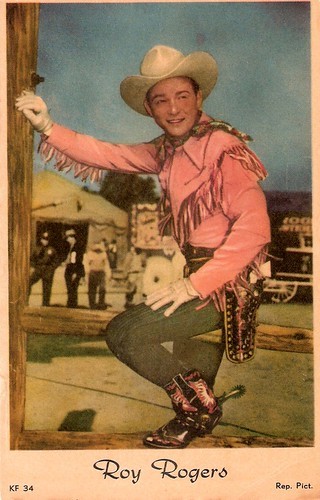
Dutch postcard, no. KF 34. Photo: Republic Pictures. Roy Rogers.
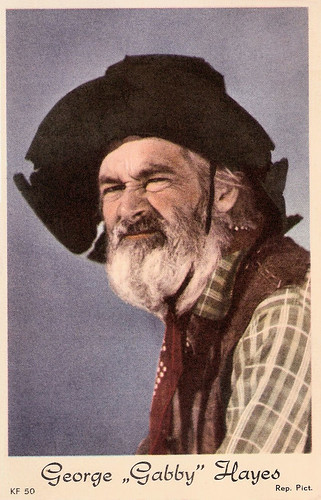
Dutch postcard, no. KF 50. Photo: Republic Pictures.
American character actor George 'Gabby' Hayes (1885-1969) was one of the colourful sidekicks to the leading men in the Hollywood Westerns of the 1930s and 1940s. His grizzled codger was so popular that Hayes landed repeatedly on the annual list of Top Ten Western Box-office Stars.
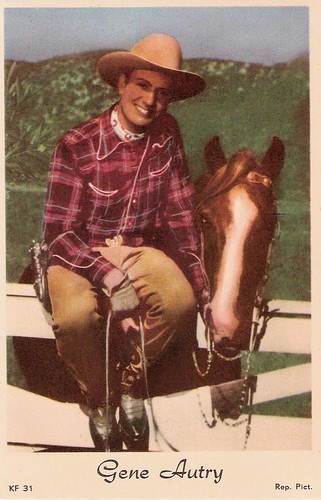
Dutch postcard, no. KF 31. Photo: Republic Pictures.
Gene Autry (1907-1998) was an American singer, and actor who gained fame as a singing cowboy in a crooning style on radio, in films, and on television for more than three decades beginning in the early 1930s. From 1934 to 1953, Autry appeared in 93 films, and between 1950 and 1956 hosted The Gene Autry Show television series.
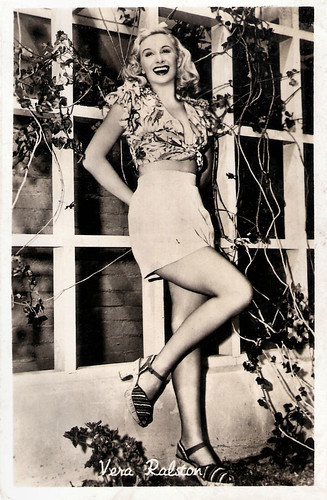
Belgian postcard by Nieuwe Merksemsche Chocolaterie S.P.R.L., Merksem (Anvers). Photo: Republic.
After achieving modest fame as an ice skater in her native Czechoslovakia, Vera Hruba (1923-2003) was brought to America by Republic Pictures head Herbert J. Yates, who hoped to turn her into the next Sonja Henie . After featuring her in two Ice Capades films, he added Ralston' to her name and tried to pass her off as a leading lady.
A Rise of Dissension in the Ranks
After he had learned the basics of film production and distribution from his partners, Herbert Yates began asserting more and more authority over their film departments, and dissension arose in the ranks. Trem Carr and W. Ray Johnston constantly clashed with Yates, who they felt was a tyrannical Hollywood interloper. They left and reactivated Monogram Pictures in 1937. Larry Darmour resumed independent production for Columbia Pictures.
Nat Levine managed to largely remain out of the fray, and by using many of the same production techniques he had used at Mascot, the new studio's output came to resemble the best of Levine's Mascot product. Levine was later bought out by Yates. Republic could also boast of having the best special effects department (then called 'miniatures') in the industry, which was headed by former Mascot employees Howard Lydecker and his brother Theodore Lydecker. This was a factor that greatly contributed to the quality level of Republic's output. Republic was often contracted by the major studios to provide special effects and miniature work for them.
Meanwhile, Yates installed a staff of new, associate producers who were loyal to him. Freed of partners, Yates presided over what was now his film studio and acquiring senior production and management staff who served him as employees, not experienced peers with independent ideas and agendas. Republic also acquired Brunswick Records to record its singing cowboys Gene Autry and Roy Rogers and hired Cy Feuer as head of its music department.
In its early years Republic was itself sometimes labelled a ‘Poverty Row’ company, as its primary products were B films and serials. Republic, however, showed more interest in — and provided larger budgets to — these films than many of the larger studios were doing, and certainly more than other independents were able to. The heart of the company was its Westerns, and its many Western-film leads — among them John Wayne, Gene Autry, Rex Allen and Roy Rogers — became recognisable stars at Republic.
However, by the mid-1940s Yates was producing better-quality pictures, mounting big-budget fare like Sands of Iwo Jima (Allan Dwan, 1949) starring John Wayne, The Quiet Man (John Ford, 1952) with John Wayne and Maureen O'Hara , Johnny Guitar (Nicholas Ray, 1954) with Joan Crawford and Sterling Hayden, and The Maverick Queen (Joseph Kane, 1956) featuring Barbara Stanwyck. Another distinguishing aspect of the studio was Yates' avoidance of any controversial subject matter, adhering to the Breen Office, in contrast to the other studios which dodged the Production Code.
From the mid-1940s Republic films often featured Vera Hruba Ralston, a former ice-skater from Czechoslovakia who had won the heart of studio boss Yates, becoming the second Mrs. Yates in 1949. She was originally featured in musicals as Republic's answer to Sonja Henie , but Yates tried to build her up as a dramatic star, casting her in leading roles opposite important male stars. Yates billed her as 'the most beautiful woman in films', but her charms were lost on the cinema audiences and exhibitors complained that Republic was making too many Ralston pictures. Years later, John Wayne admitted that the reason he left Republic in 1952 was the threat of having to make another picture with Miss Ralston. Yates remained Ralston's biggest supporter, and she continued to appear in Republic features until its very last production.
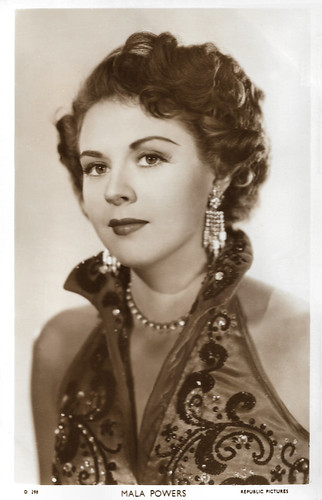
British postcard in the Picturegoer series, London, no. D 298. Photo: Republic Pictures.
American actress Mala Powers (1931-2007) played the lovely Roxanne opposite José Ferrer in Cyrano de Bergerac (1950) and starred in other Hollywood films of the 1950s. She was a leading authority on the acting techniques of Russian-American theatre practitioner Michael Chekhov.
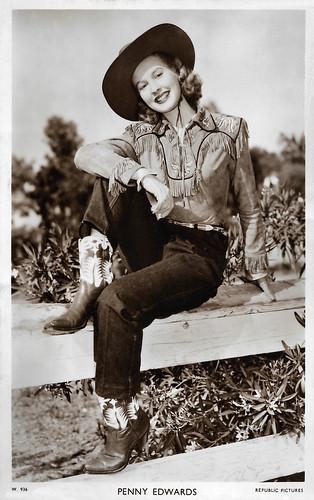
British postcard in the Picturegoer Series, London, no. W. 936. Photo: Republic Pictures.
Vivacious blue-eyed blonde Penny Edwards (1928-1998) was an American actress who performed on stage, in films, and on television. She made about two dozen films, initially working at Warners and Universal in the 1940s. She was under a term players contract at Republic Pictures from May, 1950 through October, 1951. At Republic, Edwards did mostly Westerns - six with Roy Rogers and one each with Rex Allen and Allan Lane.
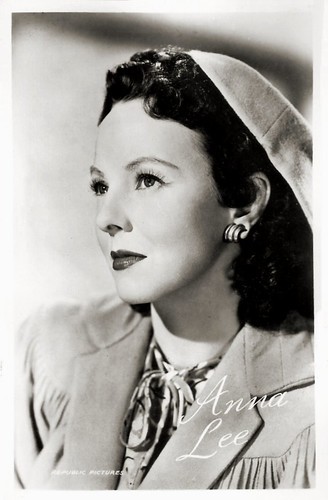
Dutch postcard, no. 3484. Photo: Republic Pictures.
Blue-eyed blonde Anna Lee (1913-2004) was a British-born American actress. She started her career in British films and earned the title 'Queen of the Quota Quickies'. In 1939, she moved to Hollywood with her husband, director Robert Stevenson. There she often worked with John Ford, and later became a TV star in the soap series General Hospital.
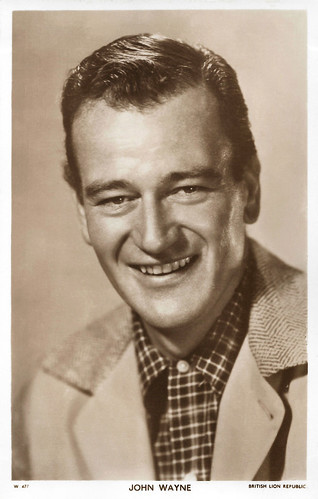
British postcard in the Picturegoer series, London, no W 477. Photo: British Lion / Republic Pictures.
American actor John Wayne (1907-1979) was one of the most popular film stars of the 20th century. He received his first leading film role in The Big Trail (Raoul Walsh, 1930). Working with John Ford, he got his next big break in Stagecoach (1939). His career as an actor took another leap forward when he worked with director Howard Hawks in Red River (1948). Wayne won his first Academy Award in 1969. He starred in 142 films altogether and remains a popular American icon to this day.
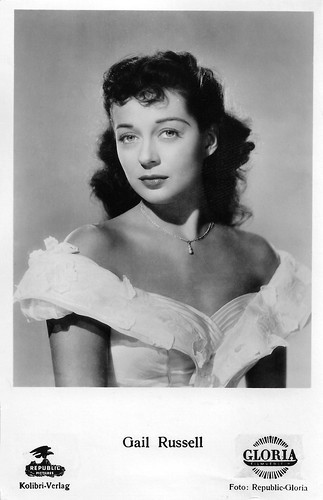
German postcard by Kolibri-Verlag, Minden/Westf. Photo: Republic Pictures / Gloria Filmverleih.
American actress Gail Russell (1924-1961) was an incredible doe-eyed beauty who presented a screen image of great innocence and vulnerability. She is best known for the supernatural horror film The Uninvited (1944). During a promising career at Paramount, she became a victim of alcoholism. It ruined her career, appearance and marriage to Guy Madison . In 1961, she died from liver damage, only 36.
Television as the prop supporting Republic
With production costs increasing, Herbert Yates organised Republic's output into four types of films: ‘Jubilee’, usually a Western shot in seven days for about $50,000; ‘Anniversary’, filmed in 14-15 days for $175,000-$200,000; ‘Deluxe’, major productions made with a budget of around $500,000; and ‘Premiere’, which were usually made by top-rank directors who did not usually work for Republic, such as John Ford, Fritz Lang and Frank Borzage, and which could have a budget of $1,000,000 or more. An example of a 'Premiere' was the Film Noir House by the River (Fritz Lang, 1950) starring Louis Hayward and Jane Wyatt.
Some of these ‘Deluxe’ films were from independent production companies that were picked up for release by Republic. Although Republic made most of its films in black and white, it occasionally produced a higher-budgeted film, such as The Red Pony (Lewis Milestone, 1949) with Myrna Loy and Robert Mitchum , and The Quiet Man (John Ford, 1952), in Technicolor.
During the late 1940s and 1950s Yates utilised a low-cost Cinecolor process called Trucolor in many of his films, including Johnny Guitar (Nicholas Ray, 1954), The Last Command (Frank Lloyd, 1955) with Sterling Hayden and Anna Maria Alberghetti, and Magic Fire (William Dieterle, 1956), starring Yvonne De Carlo and Carlos Thompson . In 1956 Republic came up with its own widescreen film process, Naturama, with The Maverick Queen (Joseph Kane, 1956) the first film made in that process.
Perhaps inspired by the success of American International Pictures catering to teenagers, Republic released several films in the late 1950s about juvenile delinquency such as The Wayward Girl (Lesley Selander, 1957) with Marcia Henderson, Juvenile Jungle (William Witney, 1958) and Young and Wild (William Witney, 1958) starring Gene Evans.
Republic was one of the first Hollywood studios to offer its film library to television. In 1951 Republic established a subsidiary, Hollywood Television Service, to sell screening rights in its vintage Westerns and action thrillers. Many of these films, especially the Westerns, were edited to fit in a one-hour television slot. Hollywood Television Service also produced television shows filmed in the same style as Republic's serials, such as The Adventures of Fu Manchu (Franklin Adreon, 1956). Also, in 1952 the Republic studio lot became the first home of MCA's series factory, Revue Productions.
While it appeared that Republic was well suited for television series production, it did not have the finances or vision to do so. Yet by the mid-1950s, thanks to its sale of old features and leasing of studio space to MCA, television was the prop supporting Republic. During this period the studio produced Commando Cody: Sky Marshal of the Universe (Harry Keller, Franklin Adreon, Fred C. Brannon, 1953). The 12-part serial was unsuccessful as a theatre release, but it was later sold to NBC for television distribution.
Talent agent MCA exerted influence at the studio, bringing in some high-paid clients for occasional features, and it was rumoured at various times that either MCA or deposed MGM head Louis B. Mayer would buy the studio outright. Republic produced The Pride of the Family (Bob Finkel, a.o., 1953-1954), a situation comedy on ABC starring Paul Hartman, Fay Wray and Natalie Wood. The following years, the studio produced Stories of the Century (William Witney, Franklin Andreon, 1954-1955), starring and narrated by Jim Davis. The syndicated series was the first Western to win an Emmy Award.
As the demand and market for films declined with the increasing popularity of television, Republic began to cut back on its films, slowing production from 40 features annually in the early 1950s to 18 in 1957. A tearful Yates informed shareholders at the 1958 annual meeting that feature film production was ending. The distribution offices were shut down the following year.
In 1959 Victor M. Carter, a Los Angeles businessman and turnaround specialist, acquired controlling interest in the floundering company, becoming its president. He turned Republic into a diversified business that included plastics and appliances in addition to its film and studio rentals and Consolidated Film Industries, renaming the company Republic Corporations. Having used the studio for series production for years, Republic began leasing its backlot to other firms, including CBS, in 1963. In 1967 Republic's studio was purchased outright by CBS. Republic sold its library of films to National Telefilm Associates (NTA).
In 1966, Herbert Yates died an extremely wealthy man and eventually left Vera Ralston a very rich widow. The Republic film library is now located at the UCLA Film and Television Archive.
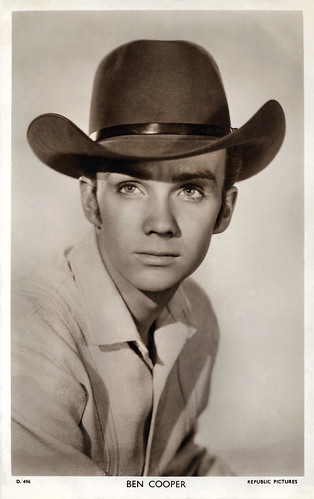
British postcard in the Picturegoer series, no D. 496. Photo: Republic Pictures.
Ben Cooper (1933) is a retired American actor of film and television, who won a Golden Boot Award in 2005 for his work in Westerns. The baby faced leading man appeared as well in Republic Westerns and in many TV Western series.
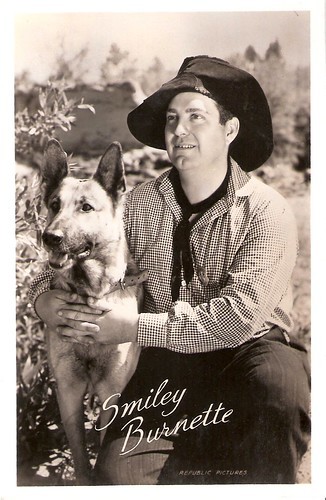
Dutch postcard. Photo: Republic Pictures.
American country music performer and actor Smiley Burnette (1911-1967) was known as Gene Autry's plump, comic sidekick 'Ole Frog' Milhouse in over 60 Westerns. His trademarks were his floppy black hat and his trick voice, imitating a deep, froglike croak. Smiley's career, beginning in 1934, spanned four decades.
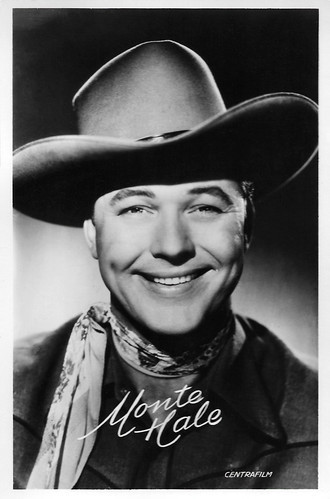
Dutch postcard. Photo: Centrafilm / Republic Pictures.
Monte Hale (1919-2009) was an American B-Western film star and country musician. He was one of the last of the 'singing cowboys' of Republic Pictures.
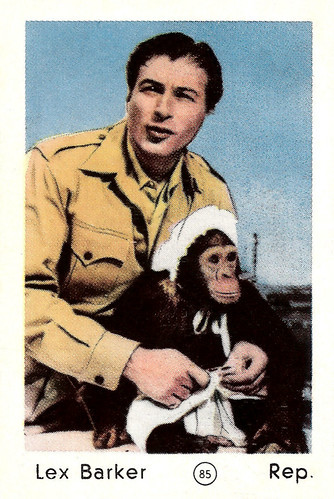
Small German collectors card, no. 85. Photo: Republic.
After a Hollywood career as Tarzan and as Mr. Lana Turner , Lex Barker (1919-1973) moved to Europe. Here he worked with Federico Fellini and later became Old Shatterhand in the popular Karl May film series.
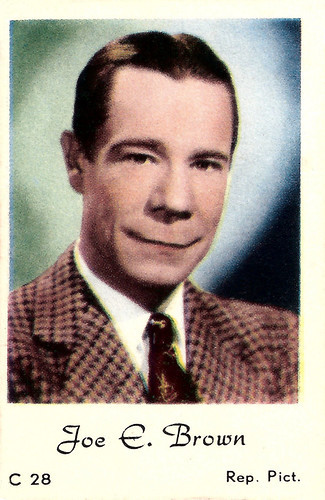
Small collectors card, no. C 28. Photo: Republic Pictures.
American comedian Joe E. Brown (1891-1973) is dearly remembered for his portrayal as Osgood Fielding III in Billy Wilder's Some Like It Hot (1959), in which he utters the famous punchline "Well, nobody's perfect". With his amiable screen persona, comic timing, and enormous elastic-mouth smile, Brown was one of the most popular American comedians in the 1930s and 1940s, with successful films like A Midsummer Night's Dream (1935), Earthworm Tractors (1936) and Alibi Ike (1935).
Sources: Wikipedia and .

Dutch postcard. Photo: Republic Pictures.
American singer and cowboy actor Roy Rogers (1911–1998) was one of the most popular Western stars of his era. Known as the 'King of the Cowboys', he appeared in over 100 films.

British postcard in the Picturegoer Series, London, no. W. 596. Photo: British Lion Republic. Roy Rogers, Dale Evans and Trigger.

British postcard in the Picturegoer Series, London, no. W. 512. Photo: British Lion.
The Sons of the Pioneers are one of the United States' earliest Western singing groups. Known for their vocal performances, their musicianship, and their songwriting, they produced innovative recordings that have inspired many Western music performers and remained popular through the years. Since 1933, through many changes in membership, the Sons of the Pioneers have remained one of the longest-surviving country music vocal groups. Between 1935 and 1984, the Sons of the Pioneers appeared in 87 films.
A studio merger on Poverty Row
In 1935, Republic was created by Herbert J. Yates (1880-1966), a long time investor in film and owner of the film processing laboratory Consolidated Film Industries. Yates had discreetly helped finance Darryl F. Zanuck 's Twentieth Century Pictures in 1933. Zanuck's new studio would become a major customer of Yates' Consolidated Film Industries. Republic was initially formed by Yates' acquisition of six smaller independent studios along Gower Gulch, a section of Gower Street in Hollywood, also called 'Poverty Row'.
In the depths of the Great Depression, Yates' laboratory was no longer servicing the major studios, which had developed their own in-house laboratories for purposes of both economy and control, while the small, independent producers were going under in the face of Depression-born increased competition from the majors combined with the general impact of the depressed economy.
Yates thus decided to create a studio of his own to insure Consolidated's stability. Six surviving small companies (Monogram Pictures, Mascot Pictures, Liberty Pictures, Majestic Pictures, Chesterfield Pictures and Invincible Pictures) were all in debt to his lab. He prevailed upon these studios to merge under his leadership or else face foreclosure on their outstanding lab bills. Yates' new company, Republic Pictures Corporation, was presented to their producer-owners as a collaborative enterprise focused on low-budget product.
The largest of Republic's components was Monogram Pictures, run by producers Trem Carr and W. Ray Johnston, which specialised in B films and operated a nationwide distribution system. The most technologically advanced of the studios that now comprised Republic was Nat Levine's Mascot Pictures Corporation, which had been making serials almost exclusively since the mid-1920s and had a first-class production facility, the former Mack Sennett-Keystone lot in Studio City. Mascot also had just discovered Gene Autry and signed him to a contract as a singing cowboy star.
Larry Darmour's Majestic Pictures had developed an exhibitor following with big-name stars and rented sets giving his humble productions a polished look. Republic took its original Liberty Bell logo from M.H. Hoffman's Liberty Pictures as well as Hoffman's talents as a low-budget film producer. Chesterfield Pictures and Invincible Pictures, two sister companies under the same ownership, were skilled in producing low-budget melodramas and mysteries.
Acquiring and integrating these six companies enabled Republic to begin life with an experienced production staff, a company of veteran B-film supporting players and at least one very promising star, a complete distribution system and a functioning and modern studio. In exchange for merging, the principals were promised independence in their productions under the Republic aegis, and higher budgets with which to improve the quality of the films.
One of the first films Republic released successfully was the Western Westward Ho (Robert N. Bradbury, 1935) starring John Wayne and Sheila Bromley. Another box office hit was the Western Tumbling Tumbleweeds (Joseph Kane, 1935) starring Gene Autry, Smiley Burnette, and George ‘Gabby’ Hayes. Written by Ford Beebe, the film is about a cowboy who returns home after a five-year absence to find his father murdered and his boyhood pal accused of the dastardly deed. Tumbling Tumbleweeds features several songs including the classic 'Tumbling Tumbleweeds'.

Dutch postcard, no. KF 34. Photo: Republic Pictures. Roy Rogers.

Dutch postcard, no. KF 50. Photo: Republic Pictures.
American character actor George 'Gabby' Hayes (1885-1969) was one of the colourful sidekicks to the leading men in the Hollywood Westerns of the 1930s and 1940s. His grizzled codger was so popular that Hayes landed repeatedly on the annual list of Top Ten Western Box-office Stars.

Dutch postcard, no. KF 31. Photo: Republic Pictures.
Gene Autry (1907-1998) was an American singer, and actor who gained fame as a singing cowboy in a crooning style on radio, in films, and on television for more than three decades beginning in the early 1930s. From 1934 to 1953, Autry appeared in 93 films, and between 1950 and 1956 hosted The Gene Autry Show television series.

Belgian postcard by Nieuwe Merksemsche Chocolaterie S.P.R.L., Merksem (Anvers). Photo: Republic.
After achieving modest fame as an ice skater in her native Czechoslovakia, Vera Hruba (1923-2003) was brought to America by Republic Pictures head Herbert J. Yates, who hoped to turn her into the next Sonja Henie . After featuring her in two Ice Capades films, he added Ralston' to her name and tried to pass her off as a leading lady.
A Rise of Dissension in the Ranks
After he had learned the basics of film production and distribution from his partners, Herbert Yates began asserting more and more authority over their film departments, and dissension arose in the ranks. Trem Carr and W. Ray Johnston constantly clashed with Yates, who they felt was a tyrannical Hollywood interloper. They left and reactivated Monogram Pictures in 1937. Larry Darmour resumed independent production for Columbia Pictures.
Nat Levine managed to largely remain out of the fray, and by using many of the same production techniques he had used at Mascot, the new studio's output came to resemble the best of Levine's Mascot product. Levine was later bought out by Yates. Republic could also boast of having the best special effects department (then called 'miniatures') in the industry, which was headed by former Mascot employees Howard Lydecker and his brother Theodore Lydecker. This was a factor that greatly contributed to the quality level of Republic's output. Republic was often contracted by the major studios to provide special effects and miniature work for them.
Meanwhile, Yates installed a staff of new, associate producers who were loyal to him. Freed of partners, Yates presided over what was now his film studio and acquiring senior production and management staff who served him as employees, not experienced peers with independent ideas and agendas. Republic also acquired Brunswick Records to record its singing cowboys Gene Autry and Roy Rogers and hired Cy Feuer as head of its music department.
In its early years Republic was itself sometimes labelled a ‘Poverty Row’ company, as its primary products were B films and serials. Republic, however, showed more interest in — and provided larger budgets to — these films than many of the larger studios were doing, and certainly more than other independents were able to. The heart of the company was its Westerns, and its many Western-film leads — among them John Wayne, Gene Autry, Rex Allen and Roy Rogers — became recognisable stars at Republic.
However, by the mid-1940s Yates was producing better-quality pictures, mounting big-budget fare like Sands of Iwo Jima (Allan Dwan, 1949) starring John Wayne, The Quiet Man (John Ford, 1952) with John Wayne and Maureen O'Hara , Johnny Guitar (Nicholas Ray, 1954) with Joan Crawford and Sterling Hayden, and The Maverick Queen (Joseph Kane, 1956) featuring Barbara Stanwyck. Another distinguishing aspect of the studio was Yates' avoidance of any controversial subject matter, adhering to the Breen Office, in contrast to the other studios which dodged the Production Code.
From the mid-1940s Republic films often featured Vera Hruba Ralston, a former ice-skater from Czechoslovakia who had won the heart of studio boss Yates, becoming the second Mrs. Yates in 1949. She was originally featured in musicals as Republic's answer to Sonja Henie , but Yates tried to build her up as a dramatic star, casting her in leading roles opposite important male stars. Yates billed her as 'the most beautiful woman in films', but her charms were lost on the cinema audiences and exhibitors complained that Republic was making too many Ralston pictures. Years later, John Wayne admitted that the reason he left Republic in 1952 was the threat of having to make another picture with Miss Ralston. Yates remained Ralston's biggest supporter, and she continued to appear in Republic features until its very last production.

British postcard in the Picturegoer series, London, no. D 298. Photo: Republic Pictures.
American actress Mala Powers (1931-2007) played the lovely Roxanne opposite José Ferrer in Cyrano de Bergerac (1950) and starred in other Hollywood films of the 1950s. She was a leading authority on the acting techniques of Russian-American theatre practitioner Michael Chekhov.

British postcard in the Picturegoer Series, London, no. W. 936. Photo: Republic Pictures.
Vivacious blue-eyed blonde Penny Edwards (1928-1998) was an American actress who performed on stage, in films, and on television. She made about two dozen films, initially working at Warners and Universal in the 1940s. She was under a term players contract at Republic Pictures from May, 1950 through October, 1951. At Republic, Edwards did mostly Westerns - six with Roy Rogers and one each with Rex Allen and Allan Lane.

Dutch postcard, no. 3484. Photo: Republic Pictures.
Blue-eyed blonde Anna Lee (1913-2004) was a British-born American actress. She started her career in British films and earned the title 'Queen of the Quota Quickies'. In 1939, she moved to Hollywood with her husband, director Robert Stevenson. There she often worked with John Ford, and later became a TV star in the soap series General Hospital.

British postcard in the Picturegoer series, London, no W 477. Photo: British Lion / Republic Pictures.
American actor John Wayne (1907-1979) was one of the most popular film stars of the 20th century. He received his first leading film role in The Big Trail (Raoul Walsh, 1930). Working with John Ford, he got his next big break in Stagecoach (1939). His career as an actor took another leap forward when he worked with director Howard Hawks in Red River (1948). Wayne won his first Academy Award in 1969. He starred in 142 films altogether and remains a popular American icon to this day.

German postcard by Kolibri-Verlag, Minden/Westf. Photo: Republic Pictures / Gloria Filmverleih.
American actress Gail Russell (1924-1961) was an incredible doe-eyed beauty who presented a screen image of great innocence and vulnerability. She is best known for the supernatural horror film The Uninvited (1944). During a promising career at Paramount, she became a victim of alcoholism. It ruined her career, appearance and marriage to Guy Madison . In 1961, she died from liver damage, only 36.
Television as the prop supporting Republic
With production costs increasing, Herbert Yates organised Republic's output into four types of films: ‘Jubilee’, usually a Western shot in seven days for about $50,000; ‘Anniversary’, filmed in 14-15 days for $175,000-$200,000; ‘Deluxe’, major productions made with a budget of around $500,000; and ‘Premiere’, which were usually made by top-rank directors who did not usually work for Republic, such as John Ford, Fritz Lang and Frank Borzage, and which could have a budget of $1,000,000 or more. An example of a 'Premiere' was the Film Noir House by the River (Fritz Lang, 1950) starring Louis Hayward and Jane Wyatt.
Some of these ‘Deluxe’ films were from independent production companies that were picked up for release by Republic. Although Republic made most of its films in black and white, it occasionally produced a higher-budgeted film, such as The Red Pony (Lewis Milestone, 1949) with Myrna Loy and Robert Mitchum , and The Quiet Man (John Ford, 1952), in Technicolor.
During the late 1940s and 1950s Yates utilised a low-cost Cinecolor process called Trucolor in many of his films, including Johnny Guitar (Nicholas Ray, 1954), The Last Command (Frank Lloyd, 1955) with Sterling Hayden and Anna Maria Alberghetti, and Magic Fire (William Dieterle, 1956), starring Yvonne De Carlo and Carlos Thompson . In 1956 Republic came up with its own widescreen film process, Naturama, with The Maverick Queen (Joseph Kane, 1956) the first film made in that process.
Perhaps inspired by the success of American International Pictures catering to teenagers, Republic released several films in the late 1950s about juvenile delinquency such as The Wayward Girl (Lesley Selander, 1957) with Marcia Henderson, Juvenile Jungle (William Witney, 1958) and Young and Wild (William Witney, 1958) starring Gene Evans.
Republic was one of the first Hollywood studios to offer its film library to television. In 1951 Republic established a subsidiary, Hollywood Television Service, to sell screening rights in its vintage Westerns and action thrillers. Many of these films, especially the Westerns, were edited to fit in a one-hour television slot. Hollywood Television Service also produced television shows filmed in the same style as Republic's serials, such as The Adventures of Fu Manchu (Franklin Adreon, 1956). Also, in 1952 the Republic studio lot became the first home of MCA's series factory, Revue Productions.
While it appeared that Republic was well suited for television series production, it did not have the finances or vision to do so. Yet by the mid-1950s, thanks to its sale of old features and leasing of studio space to MCA, television was the prop supporting Republic. During this period the studio produced Commando Cody: Sky Marshal of the Universe (Harry Keller, Franklin Adreon, Fred C. Brannon, 1953). The 12-part serial was unsuccessful as a theatre release, but it was later sold to NBC for television distribution.
Talent agent MCA exerted influence at the studio, bringing in some high-paid clients for occasional features, and it was rumoured at various times that either MCA or deposed MGM head Louis B. Mayer would buy the studio outright. Republic produced The Pride of the Family (Bob Finkel, a.o., 1953-1954), a situation comedy on ABC starring Paul Hartman, Fay Wray and Natalie Wood. The following years, the studio produced Stories of the Century (William Witney, Franklin Andreon, 1954-1955), starring and narrated by Jim Davis. The syndicated series was the first Western to win an Emmy Award.
As the demand and market for films declined with the increasing popularity of television, Republic began to cut back on its films, slowing production from 40 features annually in the early 1950s to 18 in 1957. A tearful Yates informed shareholders at the 1958 annual meeting that feature film production was ending. The distribution offices were shut down the following year.
In 1959 Victor M. Carter, a Los Angeles businessman and turnaround specialist, acquired controlling interest in the floundering company, becoming its president. He turned Republic into a diversified business that included plastics and appliances in addition to its film and studio rentals and Consolidated Film Industries, renaming the company Republic Corporations. Having used the studio for series production for years, Republic began leasing its backlot to other firms, including CBS, in 1963. In 1967 Republic's studio was purchased outright by CBS. Republic sold its library of films to National Telefilm Associates (NTA).
In 1966, Herbert Yates died an extremely wealthy man and eventually left Vera Ralston a very rich widow. The Republic film library is now located at the UCLA Film and Television Archive.

British postcard in the Picturegoer series, no D. 496. Photo: Republic Pictures.
Ben Cooper (1933) is a retired American actor of film and television, who won a Golden Boot Award in 2005 for his work in Westerns. The baby faced leading man appeared as well in Republic Westerns and in many TV Western series.

Dutch postcard. Photo: Republic Pictures.
American country music performer and actor Smiley Burnette (1911-1967) was known as Gene Autry's plump, comic sidekick 'Ole Frog' Milhouse in over 60 Westerns. His trademarks were his floppy black hat and his trick voice, imitating a deep, froglike croak. Smiley's career, beginning in 1934, spanned four decades.

Dutch postcard. Photo: Centrafilm / Republic Pictures.
Monte Hale (1919-2009) was an American B-Western film star and country musician. He was one of the last of the 'singing cowboys' of Republic Pictures.

Small German collectors card, no. 85. Photo: Republic.
After a Hollywood career as Tarzan and as Mr. Lana Turner , Lex Barker (1919-1973) moved to Europe. Here he worked with Federico Fellini and later became Old Shatterhand in the popular Karl May film series.

Small collectors card, no. C 28. Photo: Republic Pictures.
American comedian Joe E. Brown (1891-1973) is dearly remembered for his portrayal as Osgood Fielding III in Billy Wilder's Some Like It Hot (1959), in which he utters the famous punchline "Well, nobody's perfect". With his amiable screen persona, comic timing, and enormous elastic-mouth smile, Brown was one of the most popular American comedians in the 1930s and 1940s, with successful films like A Midsummer Night's Dream (1935), Earthworm Tractors (1936) and Alibi Ike (1935).
Sources: Wikipedia and .
Published on June 09, 2019 22:00
June 8, 2019
Claudia Cardinale is here
La Cardinale is in town! CC visits Amsterdam as a special guest of the Italian film week 'Fare Cinema'. Tonight, she will be interviewed before the screening of Luchino Visconti's Il gattopardo (1963) in EYE Filmmuseum. Yesterday, Ivo Blom met her at a cocktail party at the Waldorf Astoria in Amsterdam and presented her his book 'Reframing Luchino Visconti'. For this post at EFSP, I use a series of Czech collectors cards, which I recently acquired. The cards were published in 1965 after Cardinale's visit to the Karlovy Vary International Film Festival in 1964.
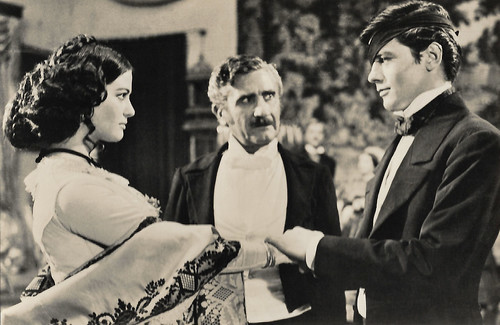
Small Czech collectors card by Pressfoto, Praha (Prague), no. S 101/6. Photo: Claudia Cardinale , Paolo Stoppa and Alain Delon in Il gattopardo/The Leopard (Luchino Visconti, 1963).
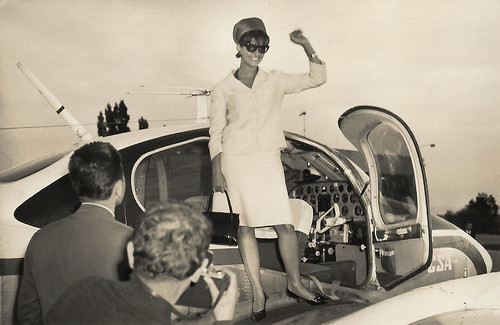
Small Czech collectors card by Pressfoto, Praha (Prague), no. S 101/10. Photo: Claudia Cardinale arrives at the Karlovy Vary International Film Festival in 1964.

Small Czech collectors card by Pressfoto, Praha (Prague), no. S 101/7. Photo: Claudia Cardinale in La ragazza di Bube/Bebo's Girl (Luigi Comencini, 1964), the film which was presented at the Karlovy Vary International Film Festival.
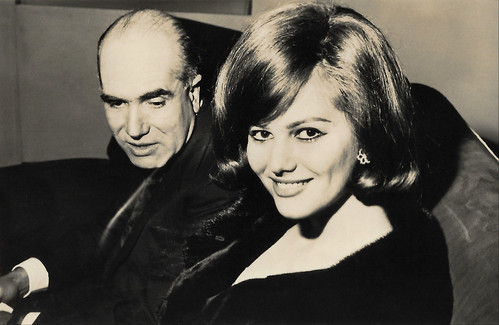
Small Czech collectors card by Pressfoto, Praha (Prague), no. S 101/8. Claudia Cardinale and director Luigi Comencini, director of La ragazza di Bube/Bebo's Girl (1964), at Karlovy Vary International Film Festival.
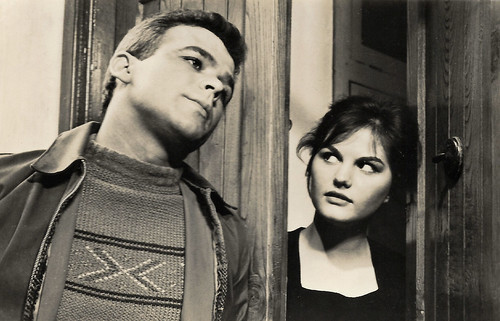
Small Czech collectors card by Pressfoto, Praha (Prague), no. S 101/3. Photo: Claudia Cardinale and Renato Salvatori in Audace colpo dei soliti ignoti/Fiasco in Milan (Nanni Loy, 1959).
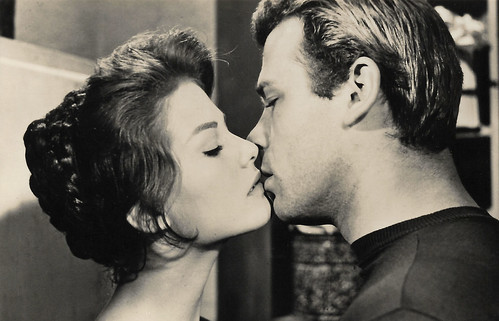
Small Czech collectors card by Pressfoto, Praha (Prague), no. S 101/4. Photo: Claudia Cardinale and Renato Salvatori in Audace colpo dei soliti ignoti/Fiasco in Milan (Nanni Loy, 1959).
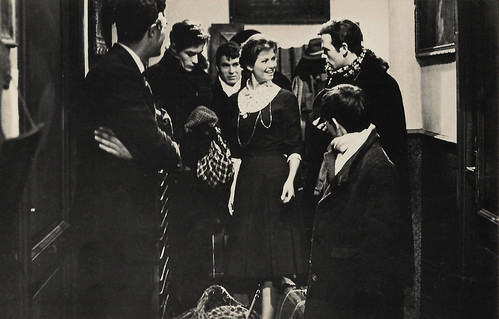
Small Czech collectors card by Pressfoto, Praha (Prague), no. S 101/5. Photo: Claudia Cardinale , Alain Delon , Max Cartier and Renato Salvatori in Rocco e i suoi fratelli/Rocco and His Brothers (Luchino Visconti, 1960).
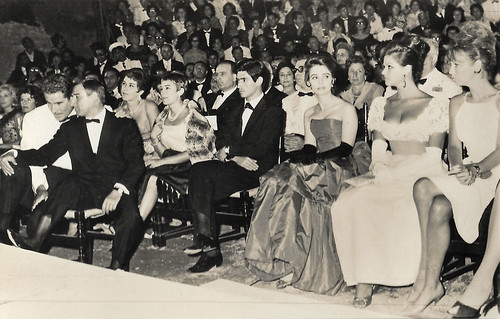
Small Czech collectors card by Pressfoto, Praha (Prague), no. S 101/2. Photo: Claudia Cardinale at the Taormina Film Fest in Sicily, in 1962. The American actress Susan Strasberg is sitting next to her.
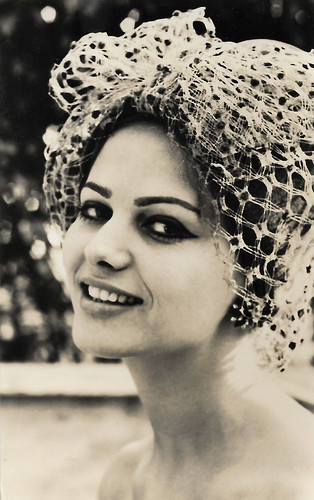
Small Czech collectors card by Pressfoto, Praha (Prague), no. S 101/1, 1965. The retail price was 0,50 Kcs.
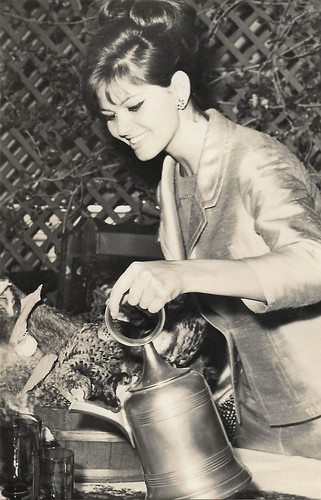
Small Czech collectors card by Pressfoto, Praha (Prague), no. S 101/9, 1965. The retail price was 0,50 Kcs.
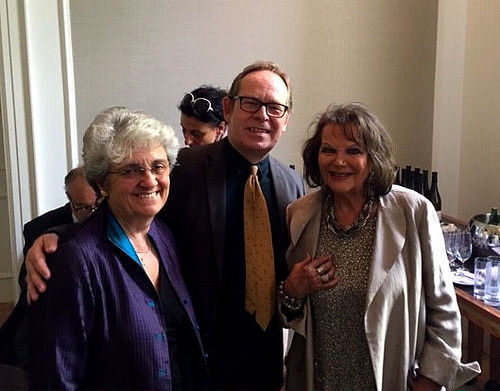
Claudia Cardinale with Caterina D'Amico, producer and former president of the Scuola Nazionale del Cinema (Centro Sperimentale di Cinematografia) in Rome, and Ivo Blom at the Waldorf Astoria Hotel in Amsterdam, 8 June 2019.

Small Czech collectors card by Pressfoto, Praha (Prague), no. S 101/6. Photo: Claudia Cardinale , Paolo Stoppa and Alain Delon in Il gattopardo/The Leopard (Luchino Visconti, 1963).

Small Czech collectors card by Pressfoto, Praha (Prague), no. S 101/10. Photo: Claudia Cardinale arrives at the Karlovy Vary International Film Festival in 1964.

Small Czech collectors card by Pressfoto, Praha (Prague), no. S 101/7. Photo: Claudia Cardinale in La ragazza di Bube/Bebo's Girl (Luigi Comencini, 1964), the film which was presented at the Karlovy Vary International Film Festival.

Small Czech collectors card by Pressfoto, Praha (Prague), no. S 101/8. Claudia Cardinale and director Luigi Comencini, director of La ragazza di Bube/Bebo's Girl (1964), at Karlovy Vary International Film Festival.

Small Czech collectors card by Pressfoto, Praha (Prague), no. S 101/3. Photo: Claudia Cardinale and Renato Salvatori in Audace colpo dei soliti ignoti/Fiasco in Milan (Nanni Loy, 1959).

Small Czech collectors card by Pressfoto, Praha (Prague), no. S 101/4. Photo: Claudia Cardinale and Renato Salvatori in Audace colpo dei soliti ignoti/Fiasco in Milan (Nanni Loy, 1959).

Small Czech collectors card by Pressfoto, Praha (Prague), no. S 101/5. Photo: Claudia Cardinale , Alain Delon , Max Cartier and Renato Salvatori in Rocco e i suoi fratelli/Rocco and His Brothers (Luchino Visconti, 1960).

Small Czech collectors card by Pressfoto, Praha (Prague), no. S 101/2. Photo: Claudia Cardinale at the Taormina Film Fest in Sicily, in 1962. The American actress Susan Strasberg is sitting next to her.

Small Czech collectors card by Pressfoto, Praha (Prague), no. S 101/1, 1965. The retail price was 0,50 Kcs.

Small Czech collectors card by Pressfoto, Praha (Prague), no. S 101/9, 1965. The retail price was 0,50 Kcs.

Claudia Cardinale with Caterina D'Amico, producer and former president of the Scuola Nazionale del Cinema (Centro Sperimentale di Cinematografia) in Rome, and Ivo Blom at the Waldorf Astoria Hotel in Amsterdam, 8 June 2019.
Published on June 08, 2019 22:00
Paul van Yperen's Blog
- Paul van Yperen's profile
- 13 followers
Paul van Yperen isn't a Goodreads Author
(yet),
but they
do have a blog,
so here are some recent posts imported from
their feed.



